March 07, 2023

Calving season is a special time of year and is something we prepare for year-round, as it often makes or breaks the ranch. Ranchers rely on their calves to support the ranch the entire year. Every spring, we genetic test our female yearlings to make sure we choose the best of the best to breed and become our replacement heifers. We look for high milk production, high marbling, high gains, low birth rates, and other genetic markers that ensure the heifers we breed are only improving the genetics of the herd. After choosing the best of our heifers, we then carefully pick a bull to breed to the heifers. Bulls are also genetically tested and surveyed for those optimal genetic markers that help ensure the growth, health, and quality of our herd.
Once we have chosen the perfect match, we artificially inseminate (often referred to as ‘AI-ing’) our heifers using the bull that we have carefully selected. When AI-ing, stress, heat, and noise can all affect heifers' ability to come into heat and ultimately breed, so it is imperative that we create a low-stress environment and favorable breeding conditions for each heifer.
In the fall, we check to see which heifers are bred (referred to as ‘preg-checking’). Heifers that are ‘open’ (not bred), are sent to be processed at our meat production facility. Heifers that are bred are sent to the ranch out north to be cared for, fed, and, ultimately, calved.
Before they calve, proper nutrition and hydration are key to helping the heifers carry healthy calves to term. We feed our heifers extra feed rations, with increased vitamins, minerals, and protein. We also make sure they are protected from storms and cold temperatures, as heifers will ‘sluff’ (abort) their calf if their bodies undergo extreme stress from weather or other conditions. Interestingly, pine needles also cause cows to sluff their calves, so while protection from the elements is important, they cannot be around pine trees while pregnant.
Since all of our heifers are bred on the same day, they generally calve within a 10-20 day window, which makes an extremely busy few weeks of calving. The heifer’s genetic markers, including their gestation cycle, allow us to pinpoint the day when the heifers will start calving.
Our heifers generally start calving around March 9th. A week or so before, we move them into the calving pasture, which is closest to our house. This allows us to have eyes on the heifers at all times. Once again, heifers are first-time moms, so low-stress environments are of the utmost importance. We typically check the heifers on an hourly basis 24 hours a day to make sure they aren’t having any problems. As we get closer to calving days, we have a “day-man” and a “night-man” (or woman) whose sole job is to care for the heifers during their shift.
Calving season is in early March, which can mean spring storms with heavy snow and sometimes frigid temperatures. In those conditions, the heifers are often brought in from the pasture at night to the barn, so they have protection from the weather.
When heifers start to get close to calving, they ‘bag-up’ which means their milk has come in and their udders enlarge. They also start ‘springing,’ which means their vulva becomes swollen and relaxed. When contractions actually start, their tails often wring or they start kicking their bellies. When this happens, we try and give them space, peace, and quiet, so they can focus on the job at hand. It is important heifers can lie down and relax to channel all of their energy and effort into having their calves.
Heifers are curious (and sometimes clueless) creatures, so other heifers will crowd the calving heifer, or the heifer herself won’t find an isolated place, so we try and help her find a quiet spot. Being new moms, heifers often get confused and try and claim another calf (sometimes even while they are actually in labor) or try and leave their own, so it's important they are separated from the herd and from other heifers calving.
We usually give a heifer around two hours to calve on her own. While in labor, first, part of the heifer’s water bag will come out, often looking like a balloon. Then, we make sure two feet come out, to ensure the calf isn’t backward or a foot isn’t stuck. The goal is to allow a heifer to have a calf without our assistance, which means while we have to watch her throughout labor to monitor for signs of distress or complications, we don’t disturb her so long as we can observe the safe delivery of her calf is on track.
Once a heifer has a calf, we monitor the next thirty minutes or so to make sure she licks the calf clean and helps the calf to its feet to allow it to nurse (drink its mother's milk). This bonding time is vital as it will ensure the mother will care for the calf over the months ahead. If the calf doesn’t get up or its mother won’t allow it to feed or she just plain runs off, we will bring the calf to the barn.
If a heifer doesn’t have her calf within a couple of hours of going into labor, we will bring her closer to the barn. We give her a little more time in a smaller pen near the barn, but if she still isn’t progressing, we will eventually bring her inside to pull the calf. To do this, we use a ‘calf-puller,’ which looks similar to a small containment stall. We place chains around the calf’s feet inside the mother and then use the leverage of the puller to pull the calf’s legs and then body out. This is a very delicate process, where we time each pull with each contraction. We have to pull hard enough to get the calf out safely, but not so hard that we will cause the mother stress or injure the calf’s hips. This process requires patience and constant attention to the heifer and calf. It generally only takes a couple of minutes, then we quickly put the pair in a nearby pen to allow the mother and calf to bond.
All of our heifers have numbered tags in their ears and we put a tag in her calf’s ear with the same number so we can tell who each calf belongs to. We also spray the calf’s umbilical cord with an ointment to protect it from infection and give it a multivitamin. Once again, it is important to give the mother and her new calf undisturbed quiet time together to allow them to bond and encourage the calf to nurse.
After a day or so, heifer/calf pairs are turned out into a separate pasture along with the other heifer pairs. These pairs are checked on multiple times a day to make sure a heifer hasn’t left her calf, that heifers are recovering, and that the calves are continuing to eat and thrive. As each pair has matching ear tags, we make sure every mother is still with her own calf and continuing to care for and bond with it. The first few days are the most important for the calf’s health and development, so it is vital it is getting proper nutrition.
Of course, things often don’t go according to plan. Mothers will refuse to ‘claim’ their calf, won’t have sufficient milk, sometimes she will even try and kill her calf, and, of course, sometimes we may lose a calf. When this occurs, we try and ‘graft’ a calf to a new heifer. We will bottle-feed calves until we can find them a new mom. Sometimes calves are backward or too big, and under those circumstances, we have to take the heifer to the vet for a c-section. Storms often force us to turn entire shops into mother/calf wards. Calves inevitably get sick and cold, which requires extra care and attention, and sometimes even hours in the mudroom of our house getting a warm bottle.
The entire process is exhausting and frustrating, but also incredibly rewarding - and quite honestly, it’s my favorite time of year. We look forward to the sleepless nights and never-ending work to see our next generation grow and thrive. While we count down the days to our next calving season, we prepare the best we can for all the things that can go wrong, pray for good weather, and rest up for the work to come.
We look forward to sharing more calving updates from the ranch with our Bootheel customers throughout the calving season. So - wish us luck and stay tuned!
Anne Wasserburger
Returning customer? log in to access previous order(s) and your saved home address.
New to Bootheel7Ranch.com? You'll be able to set up an account when you check out.
For now, enter your delivery zip code below to see available products.
 >
>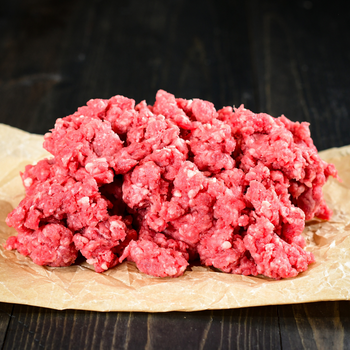
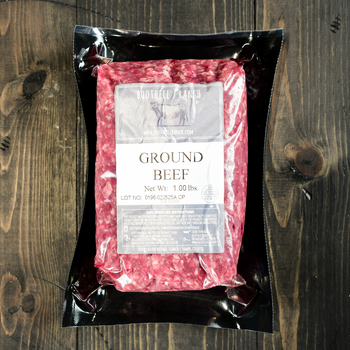
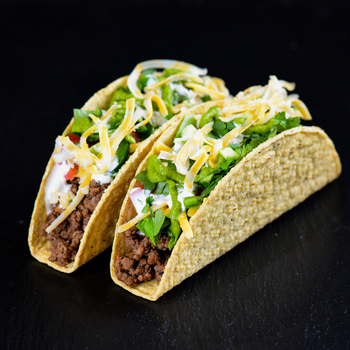
Our ground beef is a perfect blend that balancesdistinguished taste and texture. Made from 21-day dry-aged beef cuts including arm roast, mock tender, short rib, round steak, and sirloin, it's theflavorful, lean protein you can feel good about feeding your family. 1lb packages arrive flash-frozen and individually vacuum-sealed to maintain the highest quality standards.
Just can't. Been buying ground beef from B7R for the past 6 years and the overall quality is extremely noticeable. Even the smell is so different when compared to store bought ground beef. Taste is amazing.
I make sure I am always stocked up . Thanks B7R!
Our freezer always has Bootheel 7 ground beef! We have been ordering beef from Bootheel for several years and we will never go back to store beef.
Love this ground beef. It contains just the right amount of fat to be tasty, but not greasy. It is flavorful and healthier. Definitely worth a try!
Couldn't be happier with all my purchases. Always my go to for beef. Tastes amazing.
Before I started ordering from B7R, I just bought ground beef in the store. Once I tried this ground beef, I never looked back. The taste is unbeatable. We've become so spoiled and definitely taste the difference when we eat other ground beef. I order extra now so we never run out before our next delivery.
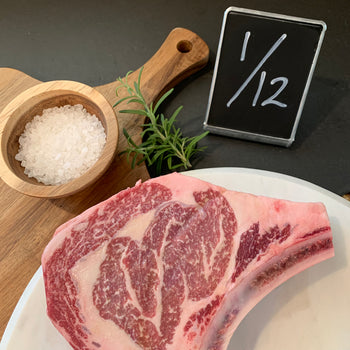
Enjoy a significant savings on your beef by moving up to one of our cow shares!
Our 1/12th cow share is an equal share of everything you would find on the side of a beef, just scaled down! Pricing includes all processing and packaging.
**SUBSTITUTIONS MAY BE POSSIBLE DEPENDING ON AVAILABILITY. PLEASE EMAIL HELLO@BOOTHEEL7RANCH.COM TO INQUIRE ABOUT PRODUCT SUBSTITUTIONS.**
Our 1/12th share includes:
(15) 1lb packages of our lean ground beef
(2) Bone-In Ribeyes
(2) T-bones
(1) package Short Ribs
(2) Assorted roasts (Chuck, Bottom Round)
(2) Top Round Steaks
(1) Top Sirloin Steaks
(1) package of Fajita Strip
(1) package Stew Meat
All cuts individually vacuum-sealed, labeled, and ready for your freezer!
Great taste and I appreciate the individually vacuumed sealed packaging
Thanks for the 5* review! We're delighted that you are happy with our products. We appreciate your continued business! - Team B7R
My husband was hesitant about the taste of grass-fed beef, but he couldn't be more pleased with the quality and taste. I love that you have different share size options with Bootheel. Prompt, on time delivery. This was my second order!
We have been ordering our beef from Bootheel for over a year… so delicious. I highly recommend it .
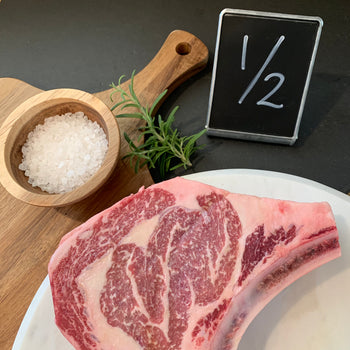
Our 1/2 cow share is in fact, a whole side of a beef! Pricing includes all processing, packaging, and delivery.
**SUBSTITUTIONS MAY BE POSSIBLE DEPENDING ON AVAILABILITY. PLEASE EMAIL HELLO@BOOTHEEL7RANCH.COM TO INQUIRE ABOUT PRODUCT SUBSTITUTIONS.**
Our 1/2 share includes:
(100) 1lb packages of our lean ground beef
(12) Bone-In Ribeyes
(12) T-Bone/Porterhouse
(1) Whole Tenderloin Roast
(1) Brisket
(4) Sirloin Steaks
(1) Tri-Tip
(1) Sirloin Bavette
(2) packages of Short Ribs
(2) packages Denver Steaks (2 steaks per pack)
(4) Flat Iron 8oz Steaks
(1) Flank Steak
(1) Skirt Steak
(8) assorted roasts (Chuck, Bottom Round)
(4) Top Round Steaks
(1) Oxtail
(2) packages Fajita Strip
(1) Petite Tender
(4) packages Stew Meat
(3) packages of Marrow and/or Knuckle Bones
All 21-day dry aged. Cuts are individually vacuum-sealed, labeled, and ready for your freezer.
We ordered the 1/2 and split with close friends so we could introduce them to the amazing beef at Bootheel 7. Needless to say they loved it, but we were so excited to try some new cuts with this order we don't see in the 1/4 order.
We ordered a half share from Bootheel 7 Ranch last October and were so impressed with the flavor and quality. I don’t usually buy beef because I care about how animals are treated, but knowing Bootheel 7 raises their cattle well made me feel good about our choice. Everything was delicious! We’re planning to order again this year.
Great taste nice portions reasonable price
meat is beautiful to look at, we had the pporterhouse this week and are impressed with the cut, the marbeling and the flavor. since we just got the 1/2 cow, we haven't tried many of the other steaks and chopmeat but the way the sale went and the niceness of the staff make me sure that we will buy again
The half share was delivered quickly, well packaged, and had great variety of cuts. Very happy with this purchase
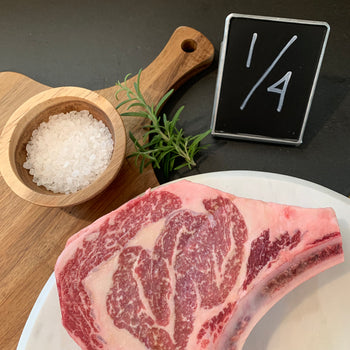
Our 1/4th cow share is an equal share of everything you would find on the side of a beef, just scaled down! Pricing includes all processing and packaging.
**SUBSTITUTIONS MAY BE POSSIBLE DEPENDING ON AVAILABILITY. PLEASE EMAIL HELLO@BOOTHEEL7RANCH.COM TO INQUIRE ABOUT PRODUCT SUBSTITUTIONS.**
Our 1/4th share includes:
(60) 1lb packages of lean ground beef
(6) Bone-In Ribeye Steaks
(6) T-bone/Porterhouse Steaks
(1) package of Short Ribs
(1) Oxtail
(2) Top Sirloin Steaks
(2) Top Round Steaks
(2) Flat Iron 8oz Steaks
(1) package Sirloin Bavette
(1) package Flank Steak or Skirt Steak
(4) assorted roasts (Chuck, Bottom Round)
(1) Denver Steak
(2) packages of Fajita Strips
(2) packages of Stew Meat
(1) packages of Marrow and/or Knuckle Bones
All 21-day dry aged. Cuts are individually vacuum-sealed, labeled, and ready for your freezer.
*Please note there may be an additional fee to ship depending on your location.
This has been our go to order for some time now. We love all of the different cuts we get to try in this order. Everything is delicious and the portion size is perfect for our family to last 6 months. Keeping the freezer full gives us piece of mind and provides our family with delicious, healthy beef!
We have been getting a 1/4 share from Bootheel 7 since 2018. Originally, we had to meet them in a parking lot to pick it up, but now they deliver directly to your door. All of the meat in the share is great tasting and is package well for the freezer. Our grandkids love the steaks and the hamburger!
We have been getting beef from Bootheel 7 since when you had to meet them in a parking lot to get your meat. We always enjoy it and usually order extra steaks and hamburger.
Hey Tom! Thanks for the 5* review! We're honored to feed your family and are grateful for your continued support of our family business! - Team B7R
I've bought this 1/4 cow share almost a handful of times. It's the bang for your buck that will fit in my freezer! The meat tastes great. When we go out to expensive steak houses the steaks aren't as good as what I can cook at home wtih a bootheel ribeye and the ground beef at grocery stores also doesn't hold a candle to the ground beef in this product!
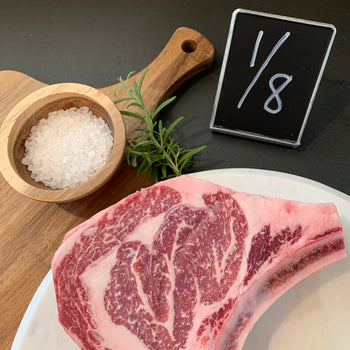
Our 1/8th cow share is an equal share of everything you would find on the side of a beef, just scaled down! Pricing includes all processing and packaging.
**SUBSTITUTIONS MAY BE POSSIBLE DEPENDING ON AVAILABILITY. PLEASE EMAIL HELLO@BOOTHEEL7RANCH.COM TO INQUIRE ABOUT PRODUCT SUBSTITUTIONS.**
Our 1/8th share includes:
(30) 1lb packages of lean ground beef
(3) Bone-In Ribeyes
(3) T-bones/Porterhouse
(1) Top Sirloin Steaks
(2) Top Round Steaks
(1) Cut Oxtail
(2) packages Short Ribs
(2) assorted roasts (Chuck, Bottom Round)
(1) package Fajita Strip
(1) package Stew Meat
(1) package Marrow or Knuckle Bones
All 21-day dry aged. Cuts are individually vacuum-sealed, labeled, and ready for your freezer!
*Please note there may be an additional fee to ship depending on your location.
Awesome service and high quality beef. A couple of the items included in the package we won’t use , would’ve liked the option to substitute.
Hi Pam, We're so glad to hear you enjoyed your order! Thank you for the feedback regarding substitutions. In the future, please do not hesitate to reach out to us at hello@bootheel7ranch.com before placing your order, and we would be happy to discuss substitutions with you. We appreciate your 5* review, and for your support of our homegrown family business. Best, Team B7R
Bought an eighth. Started with sirloin steak for first test. Amazing flavor and tenderness. Thank you. Will continue to be my source for “local” beef.
I did a ton of research on local farms that offer cow shares around Denver before deciding on B7R. We already knew they had quality ground beef because we'd been getting 1 lb/week through Royal Crest for a long while. I compared farming practices, price/lb, testimonials online, etc and found that B7R was about as good as you can get across the board. Regenerative farming + competitive pricing + affordable local delivery + the meat itself being higher quality than expected? Go ahead and put me down for an 1/8th every 6 months.
p.s. didn't come close to fitting in my 40 qt cooler on the porch, but fit perfectly in our standard freezer. 1/8th is the perfect amount.
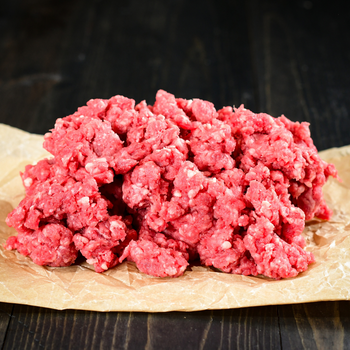
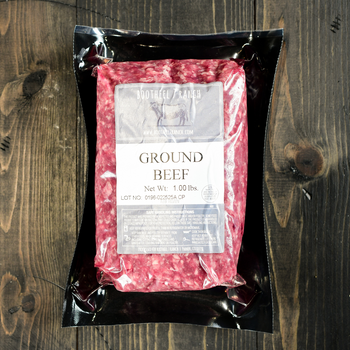
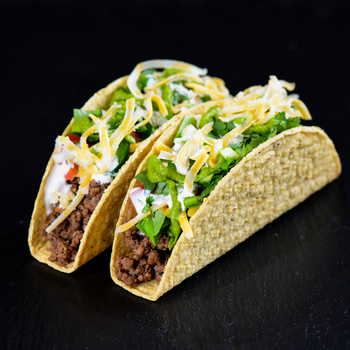
1lb Ground Beef: Buy 5, Save $5
Save $5.00 when you buy this bundle of (5) 1lb-packages of our 90/10 Ground Beef.
Our ground beef is a perfect blend that balances distinguished taste and texture. Made from 21-day dry-aged beef cuts including arm roast, mock tender, short rib, round steak, and sirloin, it's the flavorful, lean protein you can feel good about feeding your family. 1lb packages arrive flash-frozen and individually vacuum-sealed to maintain the highest quality standards.
Shepard's pie. Chili. Italian carbonara sauce and anything else that has 'ground beef' as an ingredient.
The best there is bar none.
We love the ground beef, it looks and tastes fresh.
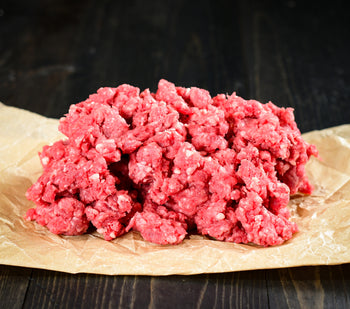
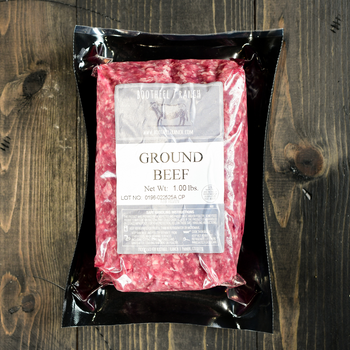
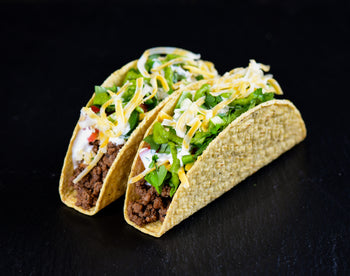
1lb Ground Beef: Buy 9, Get 1 FREE
Earn (1) FREE package of our bestselling ground beef when you buy this bundle of (9) 1lb-packages of our 90/10 Ground Beef (10 1lb packages total).
Our ground beef is a perfect blend that balances distinguished taste and texture. Made from 21-day dry-aged beef cuts including arm roast, mock tender, short rib, round steak, and sirloin, it's the flavorful, lean protein you can feel good about feeding your family.
(10) 1lb packages arrive flash-frozen and individually vacuum-sealed to maintain the highest quality standards. Approximately 10lbs of ground beef total.
Seriously cannot buy ground beef at the supermarket anymore.
Love the hamburger from Bootheel Ranch! Once you try it you can't go back to what is in the grocery stores as it just doesn't compare to the quality and you know you are getting a good product.
We love bootheel ranch. Have tried other beef companies, but this one has great delivery and the product is top notch. You won't be disappointed.
This is my family's favorite ground beef! Super flavorful and better than anything I've found in the grocery store. I always have to make sure I have several pounds of this in my freezer!
Their meat is so tasty! We love buying from a quality, local source.
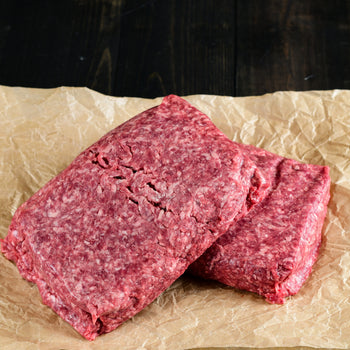
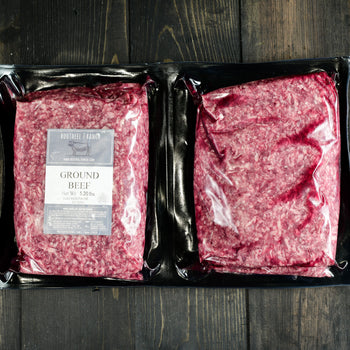
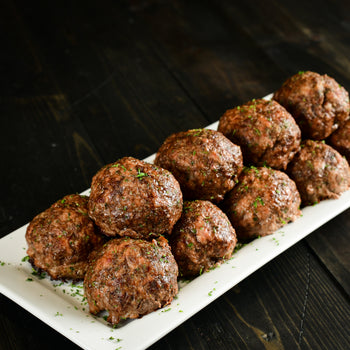
One, 77/23 fat ratio, 5lb pound bag of ground beef. Frozen and vacuum-sealed.
* These bulk packages are typically used to provide beef to our local restaurants for hamburgers!
Getting ground beef in the bulk packaging is great! We love Bootheel’s ground beef and use it exclusively, but sometime we need more than one pound increments. The 5lbs is actually (2)2 1/2 lb packages.
It was nice surprise that they packaged it in half just in case you don't need the whole 5 lbs at once.
I order from Royal Crest Dairy and its Bootheel ground beef! This stuff is worth the price! I don't think I will ever buy from the grocery store again! Great job yall!
Love this bulk package option for when you are entertaining/hosting. Great to have on hand in the freezer for when unexpected company drops by!
Hands down, the Best ground beef I've ever tasted!!!
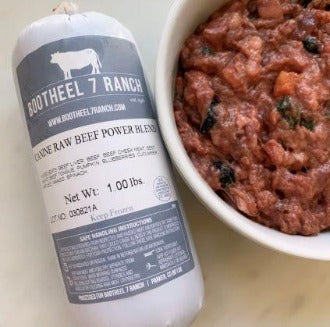
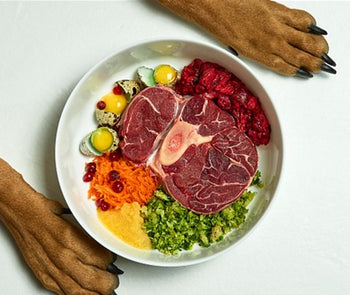
Suggested as a supplement for more active dogs, B7R Canine POWER Blend is a proprietary, healthy blend of lean beef, fruit, veggies, and organ meat:
Arrives frozen in individually wrapped 1lb packages. The meat used to produce this blend is human grade, USDA inspected, and produced fresh like our other B7R products.
My Shiba loves the raw Power Blend! I like that it comes in a small, manageable portion. It always looks fresh and looks appetizing (well, as appetizing as raw meat can look).
Our dogs and some of our friends' pups have food allergies. We also know that dog food is not nearly as regulated as people food, so you can't account for the quality, ingredients, or freshness.
We like to stock up and also give these canine blends as gifts!
Dogs love it!! No fillers just good healthy dog food.
Our dogs love this power blend and contains a variety of healthy ingredients for them.
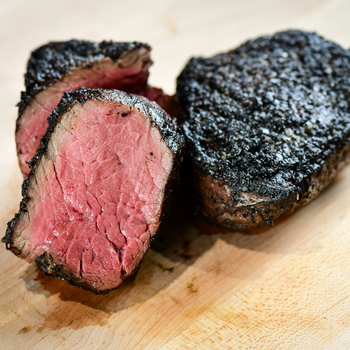
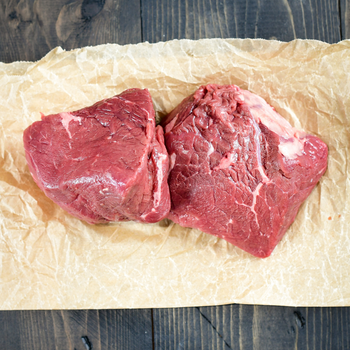
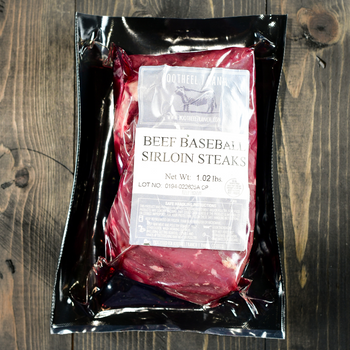
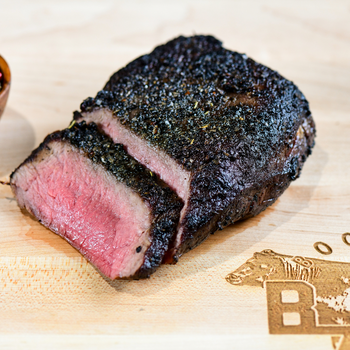
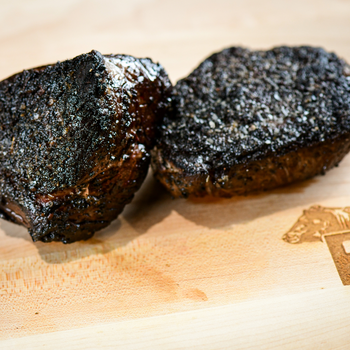
The baseball cut gets its name from its rounded shape. Cut from the center of the top sirloin, this cut is thick, lean, and flavorful - similar to filet mignon but at smaller price!
2 steaks per package, approx. 1lb per package
Love the size and flavor. A nice lean piece of meat that packs a ton of flavor. I like how they are packaged.
A very tasty piece of steak. Very much resembles a filet!
I just grilled these baseball sirloin steaks to use in my wife’s great beef stroganoff. The sirloin was fantastic like everything else we’ve enjoyed from Bootheel 7 Ranch. They were lean with great flavor. So good, I had to leave a review.
Wayne - We're so happy to hear you're enjoying our products. Thanks for your positive reviews and continued support of our family business. - Team B7R
We’ve been ordering from Bootheel 7 Ranch for a few years, but recently tried these steaks! They are consistently tender and delicious! I grew up on a farm and always had “home grown” beef. Thanks Bootheel 7 Ranch for bringing back memories of home!
We have been ordering with Bootheel 7 Ranch for several years. We find their products to be consitantly wonderful, the delivery always goes off without a hitch. We recommend them highly if you want a superior meal experience!
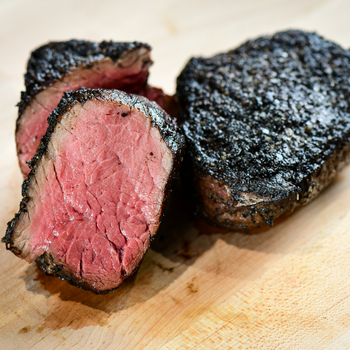
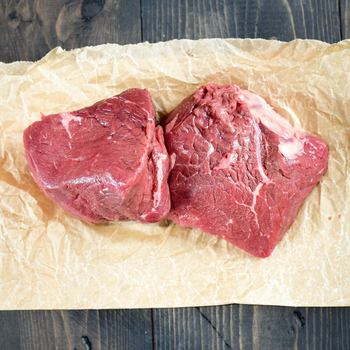
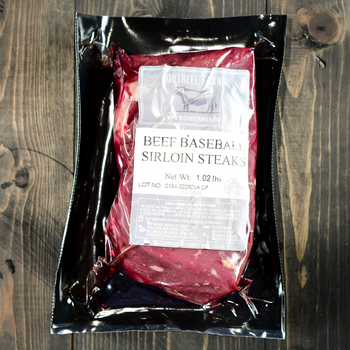
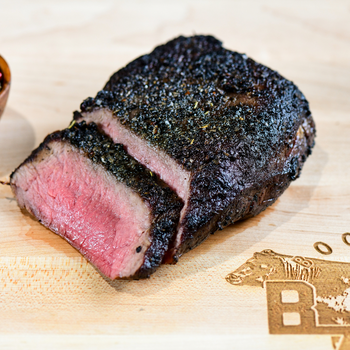
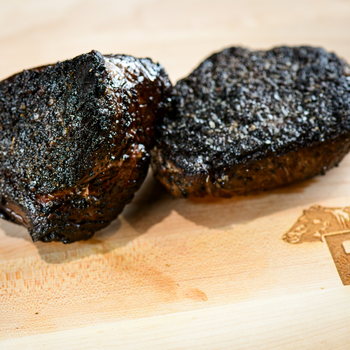
Baseball-Cut Sirloins: Buy 5, Save $5
Save $5.00 when you buy this bundle of (5) packages of 1lbs-packages of Baseball-Cut Sirloin steaks.
The baseball cut gets its name from its rounded shape. Cut from the center of the top sirloin, this cut is thick, lean, and flavorful - similar to filet mignon but at smaller price!
2 steaks per package, approx. 1lb per package -This bulk order includes approximately 5lbs of baseball-cut sirloins.
ootheel 7 Ranch baseball-cut sirloin steaks are delicious! All the flavor you can imagine in a steak with a tenderness second only to their tenderloin filets.
Season, grill, rest, and sprinkle with your favorite finishing salt! Steakhouse delicious!
Bootheel 7 Ranch baseball-cut sirloin steaks are delicious! All the flavor you can imagine in a steak with a tenderness second only to their tenderloin filets.
Season, grill, rest, and sprinkle with your favorite finishing salt! Steakhouse delicious!
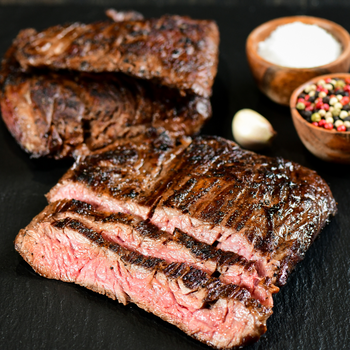
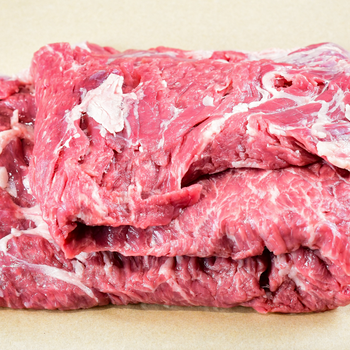
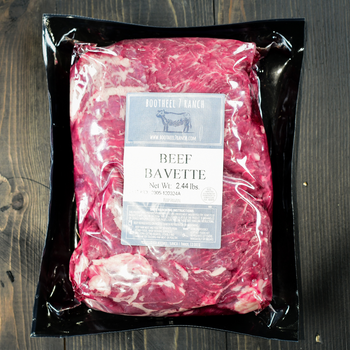
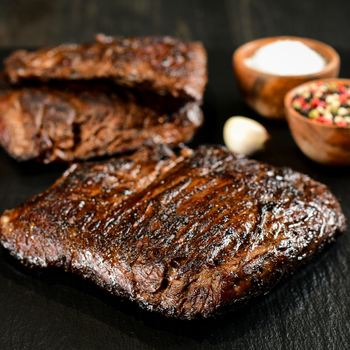
Bavette steak comes from the bottom sirloin, close to where a flank steak comes from. When cooked and sliced properly, it’s one incredibly tender and delicious cut that doesn't get nearly the recognition it deserves! With only one per animal, this cut is a welcome treat marinated and thrown on the grill or skillet.
2.5-3lbs per package
I used this to make pot roast. Waaay better than using chuck. A new favorite cut for me.
Hey Deb! Bavette is an exceptional cut that many folks haven't heard of! Thanks for giving it a shot and letting us know how it turned out. We appreciate your support of our family business. - Team B7R
I decided to try this cut I had never heard of because it seemed like a good value. We like our steaks lean and tender and this is a perfect fit! Feed the whole family or have extra for steak salads and sandwiches later.
Delicious and easy to cook on the grill! Very flavorful and made for great steak sandwiches with the leftovers
I was hesitant as I had never heard of this cut before. I put a dry rub on it and cooked it low and slow and it was fall apart tender and full of flavor.
Marinated with a chimichurri sauce. Then drizzled over. Crowd favorite.
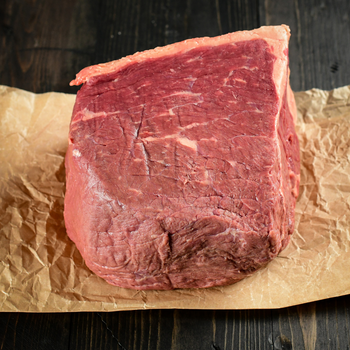
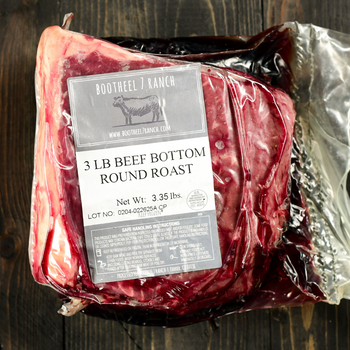
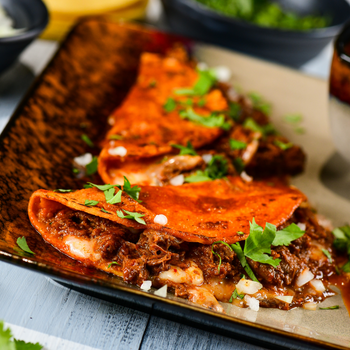
A beautiful roast and excellent choice for slow cooking pot roast, shredded beef enchiladas, corned beef and more. The options are endless with this versatile cut!
Approx. 3lbs
This was a tender and juicy roast, easy to make in the crock pot. Out of town company loved it. Bootheel7 never fails to please and has an extremely efficient delivery setup, even if not within the state.
This is the best roast we've had since moving off the farm and eating only the meat raised on the farm. This is our "treat" meal. Comfort food at its finest!
Comparing the bottom round I have occasionally bought at Costco and a few local organic grocery stores, the Bootheel 7 roast was extremely tender and flavorful. What a difference!! I marinated it in the refrigerator overnight with juice of 1 each lime and tangerine and some garlic and herbs. Slow cooked it for 4 hours next day. Very tender and juicy. Probably could have cooked it for a shorter time. Maybe could have had it rare/med rare. Will try next time.
Sharon - We love to hear from happy customers...especially when you share your culinary tips! We'll have to give that marinade a try. Thank you for your business, we look forward to sharing our 21-day dry-aged Black Angus goodness with you again in the future. - Team B7R
This rump roast is perfect and easy for a Sunday dinner. Just put in the crockpot and the roast is tender and delicious!
This is a flavorful cut that works great for roast beef. I season it, then sear in a hot cast iron pan. Then place on a rack in my Instapot with about 1/2 cup of beef broth and cook on high pressure for about 12 min (a 3lb roast) for Med. Rare. Then let it remain in the pot at the Keep Warm setting for 45 min. Remove and use liquid in pot to make a gravy or for AuJus. Slice thinly to serve
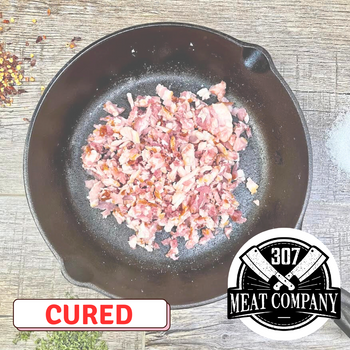
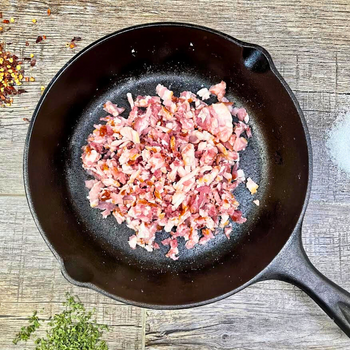
New from our partners, 307 Meat Company, add this chopped bacon to any salad, chili, baked potatoes or casserole for a flavor-enhancing treat. A bit richer than regular bacon (also available in our shop), chopped bacon – otherwise known as ‘ends and pieces’ – are the tasty morsels that remain after the slicing process. Though smaller – these little flavor bombs pack a hearty punch and will elevate any dish.
*0.5LB
*Locally-produced, nitrate-free
*All natural, antibiotic-free, no hormones
*The main difference between cured and uncured meat generally has to do with the aging process and methods used to preserve the product. Cured bacon, for example, may include sea salt and nitrites to seal the product’s flavor and color, while UNCURED bacon (like this product here), cures with naturally-occurring nitrites like celery juice powder.
Although a new addition to the B7R shop, this product is the result of our longstanding partnership with 307 Meat Company. 307 is a full-service craft butcher shop and retail store in Laramie, WY – just about the halfway point between Denver and the pastures of Bootheel 7 Ranch in Lusk, WY. This premium, locally-produced product is sourced from twenty family-owned farms who promote and practice sustainable agriculture, and devote individualized attention to the animals. We’re proud to carry 307 pork products and see our 307 partners expand their reach to B7R customers.
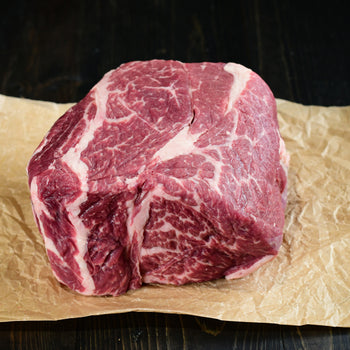
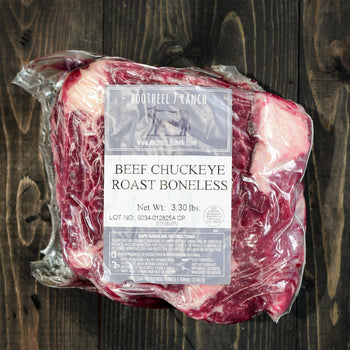
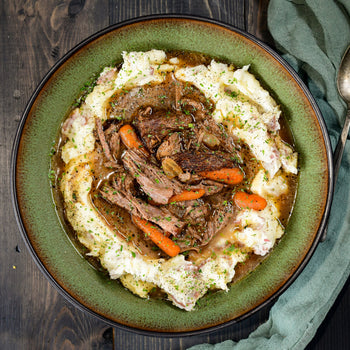
We love chuck! When prepared slow n' low, this versatile cut can be used for everything from pot roasts to shredded beef enchiladas. Set on low in the slow cooker for 9+ hours and come home to the best dinner (and wonderful smelling home!) waiting for you.
Approx 3lb per roast
First time cooking a chuck roast. It was excellent. Seared both sides (after salt and pepper) then braised in a Dutch oven with a 28oz can of crushed tomatoes, 16oz bone broth, and sautéed garlic, onions, carrots, and celery (spice to taste). Braised at 350 for about an hour per pound (mine was 3.37 lbs). Took some of the braising liquid (skimmed the fat off), puréed with a hand blender, then reduced that liquid in a frying pan after adding some red wine (maybe 1/2 cup). That sauce thickened up and was an awesome gravy on top of mashed potatoes and tender BR7 chuck! Will order again!
One of my favorites! Taste and texture is always perfect. You will notice the quality and then can never go back!
I love using this cut for meals! Such great flavor and excellent quality.
Tender, fatty, goodness!
This chuck roast is the best ever for barbacoa. The flavors really shone through and the entire family loved it in tacos and burritos. Yummy!!
Hey Wendy! Thanks for the 5* review! We're honored to feed your family and that you all enjoyed barbacoa chuck roast! We appreciate your continued business! - Team B7R
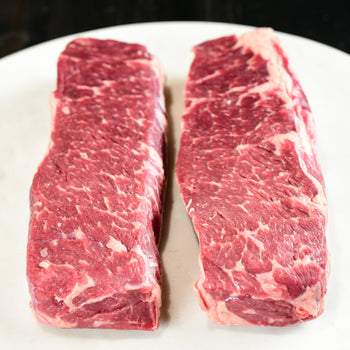
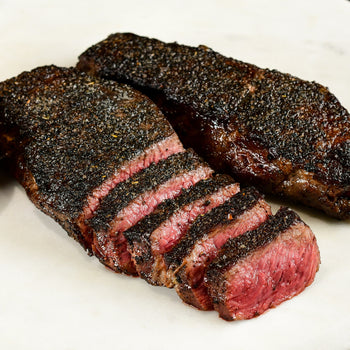
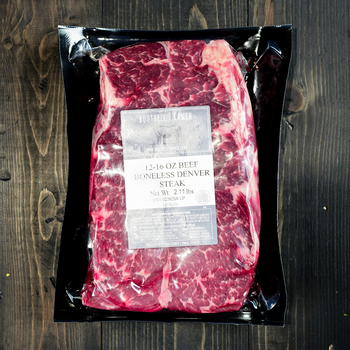
The Denver Steak has the qualities of both a Ribeye and a NY Strip Steak in one! Well marbled, this delicious cut carries all the depth of flavor associated with the chuck while remaining super tender. Grill or pan sear to medium-rare and slice against the grain for a show-stopping meal.
2 steaks per package, approx. 1.5lb per package
*Please note the label on the packaging may read 'Short Ribs (Denver Style).'
I’ve never had a Denver steak until seeing on B7R’s website. It has a ton of flavor and reminded me of the ribeye cap - but at a fraction of the price. Fun one to try to add some variety to your menu.
These steaks were so delicious. Great flavor and a good price.
Delicious.
We found steak to have much more fat than we anticipated. I grilled them on the stove to medium rare. Some pieces were really good, but a lot we threw out.
Every Sunday we have my Dad over for dinner. He's an old cowboy who loves good beef! We marinate it as it thaws in a half cup of teriyaki or orange sauce, then my husband grills it at 475 degrees with the grill closed; 10 minutes on one side, then 12 minutes on the other side, and slices it cross grain. One package of Denver Steak easily feeds all three of us, and it tender and delicious.
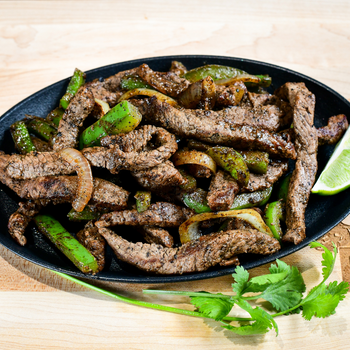
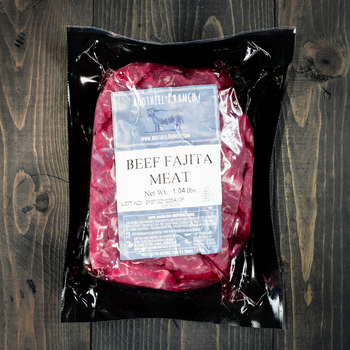
Our B7R Fajita Meat is a flavorful and tender cut pre-sliced into fajita-ready strips. All you have to do is throw it in your pan or wok and add your favorite veggies for an easy, delicious weeknight dinner!
1lb package
The fajita meat is the best and easiest to prepare. Great flavor and very tender, love it.
This is our first time order from Bootheel7 Ranch and we were not disappointed. We used this order for stir fry and the texture and taste were terrific. We are now a permanent customer!
This comes in thin strips which I cut down into 1inch pieces for beef stroganoff. Love the convenience and the beef is tasty and tender.
This is one of my faves! The meat is consistently good and soft!
This is the best for a quick, easy dinner! I let it sit for an hour with lime juice, cumin, chili powder, salt/pepper and throw it in a cast iron. Makes the best steak tacos!
Caitlin - thanks for your sharing your culinary secrets! We'll have to give this one a try. Enjoy your fajitas and thanks for shopping B7R!
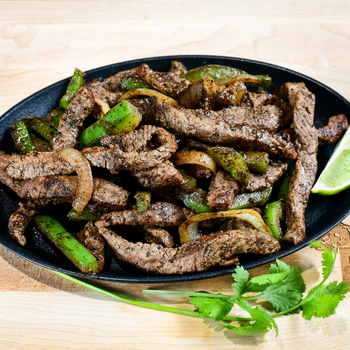
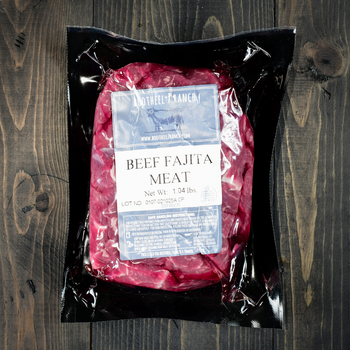
Fajita Meat: Buy 5, Save $5
Save $5.00 when you buy this bundle of (5) 1lb-Packages of Fajita Meat.
Our B7R Fajita Meat is a flavorful and tender cut pre-sliced into fajita-ready strips. All you have to do is throw it in your pan or wok and add your favorite veggies for an easy, delicious weeknight dinner!
1lb packages -This bulk order includes 5lbs of Fajita Meat.
We buy the fajita meat all the time. It’s versatile and is great for prepping multiple meals for the week. Comes together really quick and is delicious.
We have this weekly in our menu rotation. Everyone in the family looks forward to fajita night!
Cheri, thank you so much for your review, and we're thrilled the whole family is enjoying our product. We appreciate your support of our family business. - Team B7R
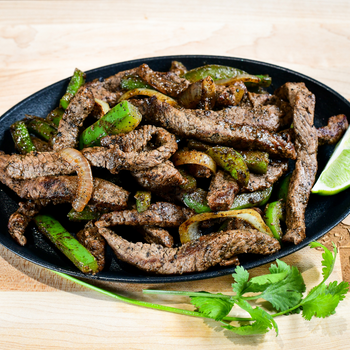
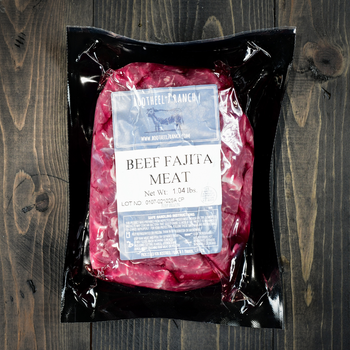
Fajita Meat: Buy 9, Get 1 FREE
Earn (1) FREE package of fajita meat when you buy this bundle of (9) packages of fajita meat (10 1lb packages total).
Our B7R Fajita Meat is a flavorful and tender cut pre-sliced into fajita-ready strips. All you have to do is throw it in your pan or wok and add your favorite veggies for an easy, delicious weeknight dinner!
1lb packages -This bulk order includes 10lbs of Fajita Meat.
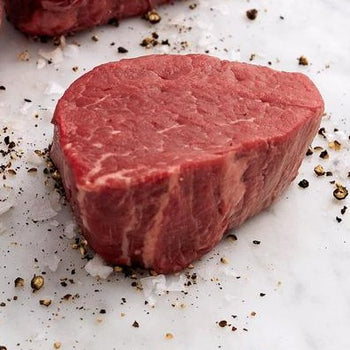
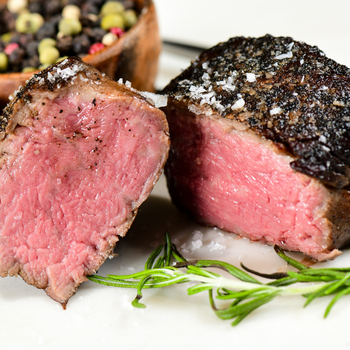
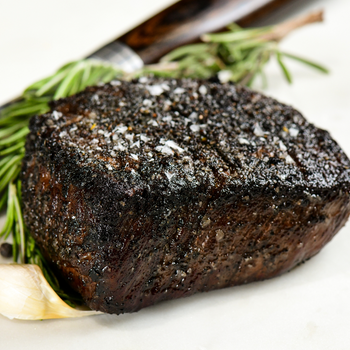
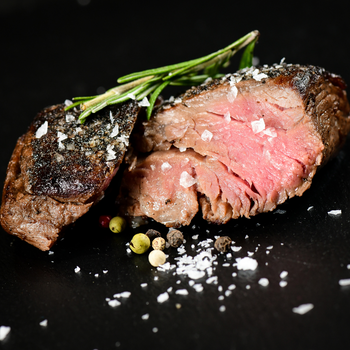
For a truly unbeatable steak experience, the filet mignon (cut from the beef tenderloin) is definitely your go to! It is the most expensive and sought-after cut of beef, simply because there isn't much of it to go around. It's small and unbelievably tender, making your B7R filet experience truly one to remember!
Individually cut and vacuum-sealed, 21-day dry age.
This is my personal favorite cut! Thank you Bootheel for providing a superior product every time we order! We are never disappointed, only when we run out!
This steak didn’t just change my diet—it rewrote my culinary belief system. This isn’t just meat; it’s a revelation wrapped in marbling. The flavor? Rich, clean, and somehow nostalgic, like it remembers what beef used to taste like before the world got weird. Every bite is a reminder that cows, when raised right, can do magical things.
I now evangelize to friends, family, and unsuspecting strangers at the grocery store. “You haven’t lived,” I whisper, “until you’ve had Bootheel 7.”
Bless you, Bootheel 7. You had me at first sizzle.
⭐️⭐️⭐️⭐️⭐️
I ordered a number of filet mignon’s and they were delicious so I’ve re-ordered more
Hey Steve! Thanks for the 5* review! We're honored to feed your family and that you are loving the filets! We're biased, of course, but agree that they are fantastic cuts :) We appreciate your continued business! - Team B7R
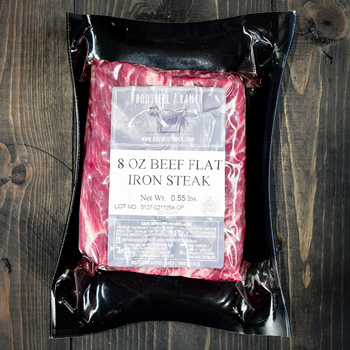
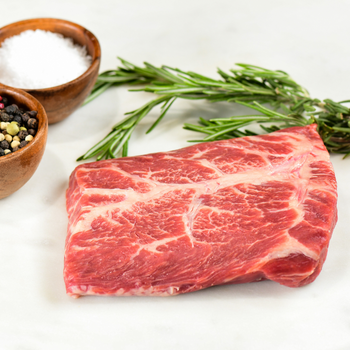
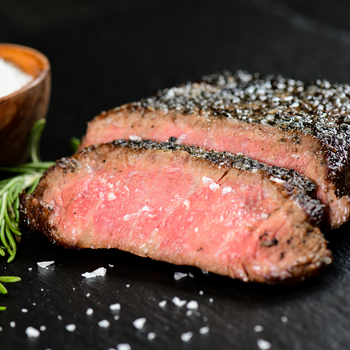
This cut is a hidden gem. Considered the second most tender cut of the cow (only after filet/tenderloin), the flat iron is well marbled and has a robust, meaty flavor like a NY Strip. Popular for grilling and certainly a crowd pleaser!
Approx. 8oz portion size
This is our go-to steak from Bootheel. We love the size, and it is always so tender. The Flat Iron Steak is a staple in our freezer.
High quality meat
Can’t say enough about this cut of meat. Cooked medium rare it literally melts in your mouth. It truly is an amazing steak that offers a variety of cooking methods that will tantalize your palate. We absolutely love this meat!!
We've been buying our beef from Bootheel 7 Ranch for almost 2 years now, and love always having such high quality meat in our freezer. All of it is exceptional, but the flat iron steaks may be my favorite. Tender, juicy, flavorful and at such a great price point so I tend to order a lot of them.
I love these flatiron steaks! They are tender and flavorful and great for slicing and either adding to a salad or just eating alone.
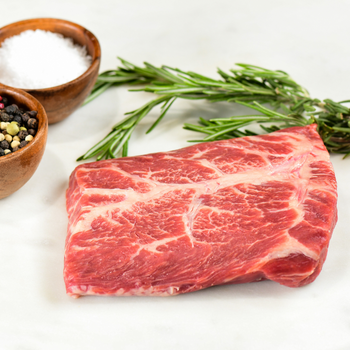
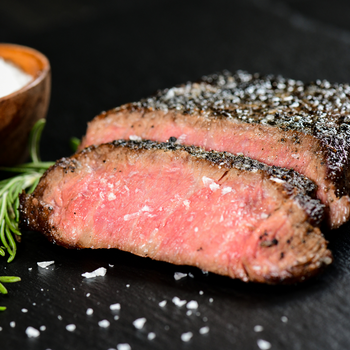
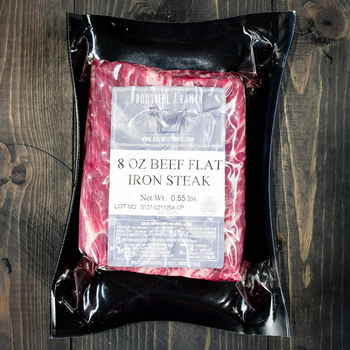
Flat Iron Steak: Buy 5, Save $5
Save $5.00 when you buy this bundle of (5) Flat Iron steaks.
This cut is a hidden gem. Considered the second most tender cut of the cow (only after filet/tenderloin), the flat iron is well marbled and has a robust, meaty flavor like a NY Strip. Popular for grilling and certainly a crowd-pleaser!
Approx. 8oz portion size per steak-This bulk order includes approximately 2.5lbs of 8oz flat irons.
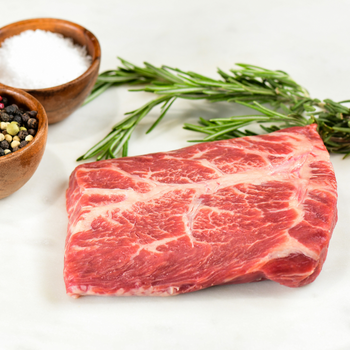
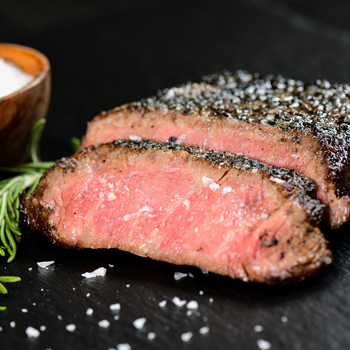
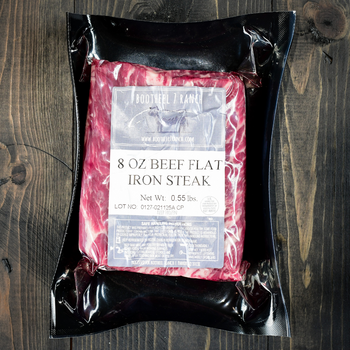
Flat Iron Steak: Buy 9, Get 1 FREE
Earn (1) FREE steak when you buy this bundle of (9) Flat Iron steaks (10 steaks total).
This cut is a hidden gem. Considered the second most tender cut of the cow (only after filet/tenderloin), the flat iron is well marbled and has a robust, meaty flavor like a NY Strip. Popular for grilling and certainly a crowd-pleaser!
Approx. 8oz portion size per steak-This bulk order includes approximately 5lbs of 8oz flat irons.
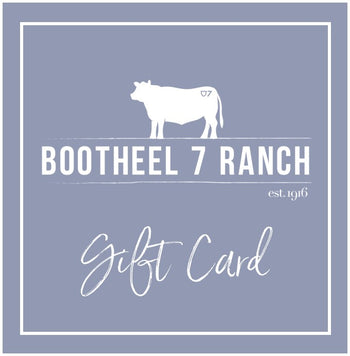
Give the gift of 'Denver's Best Steak' right at home! Ideal for family, friends, business associates, home chefs, and your hard-to-shop for loved ones!
Purchase a gift card and it will be instantly emailed to you (purchaser). Forward the email to your gift recipient, or print gift card out at home. **Please note - if you would like to include a personal message, please do so when emailing/forwarding to the gift recipient.
Can be used towards any future order, does not expire.
I bought two gift cards as Christmas gifts, gave them out early, their response was pure excitement, I’ve given out steaks as gifts, nothing but love, now they’ll have the pick of the crop.
Thank you Bootheel 7 Ranch, Merry Christmas
Hi Deb, Thank you so much for spreading the word about Bootheel 7 Ranch! Thank you for your 5* review, and for your support of our homegrown family business. Best, Team B7R
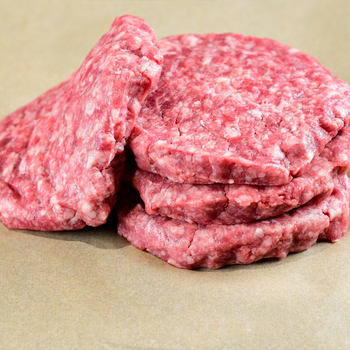
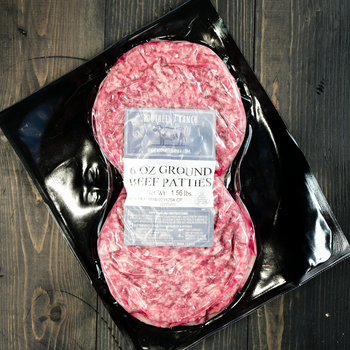
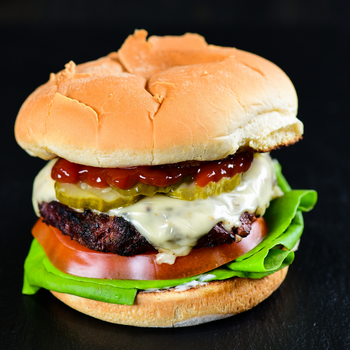
Enjoy our grill-ready hamburger patties! 80/20, vacuum-sealed, arrives frozen. Contains four ready to grill patties 6oz each (1.5lb of beef).
We purchase both the pound package of ground beef and the four-pack of hamburger patties. The patties are incredibly convenient for a quick and easy meal. They are also handy when entertaining, as they make less work for the chef.
B7R’s hamburger is heads and shoulders above what you can find at your local grocery store in my opinion.
We love the hamburger, nice to know we are supporting small businesses and getting a great product.
These make huge burgers, we usually make the 4 into 5 burgers. The beef is so tasty, with a smoother texture than store- bought getting beef.
Susan - Thanks for your review, we are so happy to hear you are enjoying the product! We appreciate your continued support of our family business. - Team B7R
The hamburger patties are the most juiciest and flavorful we've ever had. So far every thing we have had has been wonderful.
We appreciate your continued support of our family business, Scott! Thanks for your positive reviews of our products, we look forward continue serving your dinner table. - Team B7R
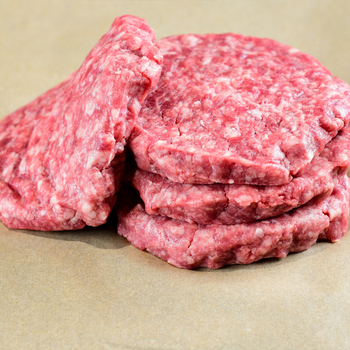
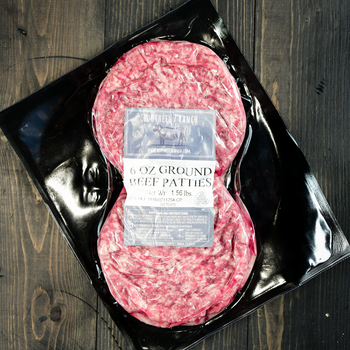
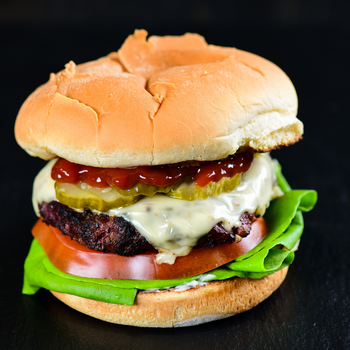
Hamburger Patties: Buy 5, Save $5
Save $5.00 when you buy this bundle of (5) Packages of 4x 6oz-patties.
Enjoy our grill-ready hamburger patties! 80/20 lean, vacuum-sealed, arrives frozen.
1 order of patties includes (4) patties per package, 6oz per patty (1.5lb of beef total). This bulk order includes 20 patties totaling 7.5lbs of burger patties.
Amazing product and service - never disappointing
Love these hamburgers, very juicy and there is hardly any shrinkage. The ground beef is also very good.
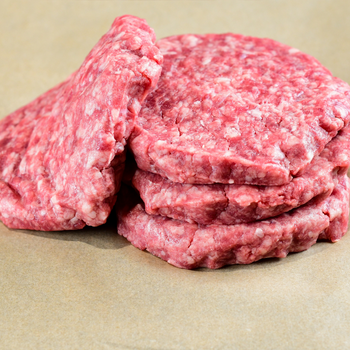
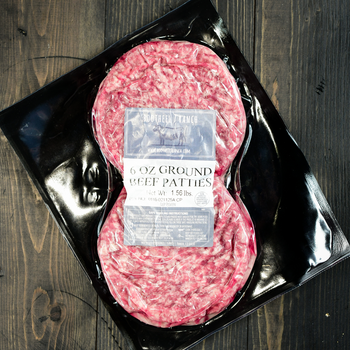
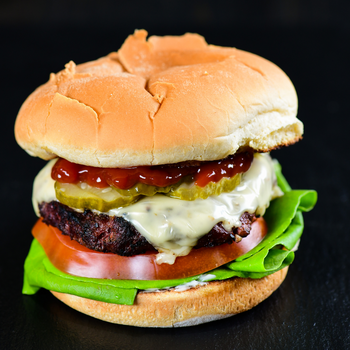
Hamburger Patties: Buy 5, Save $5
Earn (1) FREE package of burger patties when you buy this bundle of (9) Packages of 4x 6oz-patties.
Enjoy our grill-ready hamburger patties! 80/20 lean, vacuum-sealed, arrives frozen.
1 order of patties includes (4) patties per package, 6oz per patty (1.5lb of beef total). This bulk order includes 40 patties totaling 15lbs of burger patties.
These burgers are always flavorful and delicious!
Jennifer - We're so happy to hear our burgers are your favorite! Thanks for your kind words and continued support of our family business. - Team B7R

It's here! Always a holiday favorite, our BONELESS prime rib roast is the most desirable cut for any holiday or special event. With our 21 day dry-age, our rib roast will be sure to WOW your holiday crowd with tenderness and flavor!
Limited quantity available. We will continue to restock through the holiday season, so if your first choice is gone - stay tuned, and check back for restocks!
Please note: Prime Rib roasts are trimmed and have had the fat cap removed (not the spinalis dorsi).
Reverse Seared in the smoker. The best prime rib my family ever had according to them!
Dry brined in the fridge for 48 hours with coarse salt then mustard and Kinders and in to the smoker it went.
Hey Michael, Thank you so much for spreading the word about Bootheel 7 Ranch with your family! We greatly appreciate your 5* review and support of our homegrown family business. Best, Team B7R
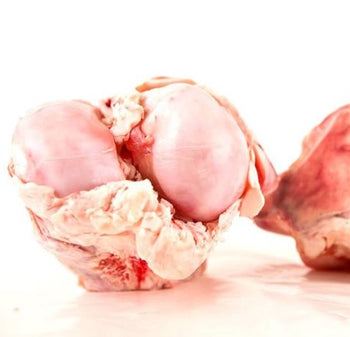
Our favorite bone for dogs! No edges with extra cartilage on the ends for strong chewers!
One package of beef knuckle bones, averages 2-3 bones (4lbs total)
These knuckle bones make the best ever healthy and healing beef bone broth. We freeze them in small one-cup bags just perfect to heat up in a mug and settle down in front of the fire.
Thanks for the 5* review, Wendy! Great idea for preparing your bone broth. We're so happy you are enjoying our products, and appreciate your continued business! - Team B7R
These are the best bones that I have found for my dogs, as long as each dog has their own. Even my little Maltese enjoys these big boy bones!
Jan - Nothing makes us happier than going above and beyond for our customers - the four-legged ones included! Thanks for sharing your review, we look forward to serving you and the pups again in the future. - Team B7R
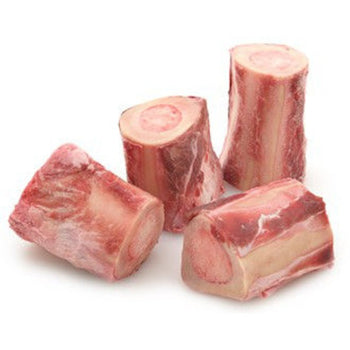
One package of beef marrow bones, averages 3lbs.
I always have these marrow bones on hand for special occasions or if we have company and I need to keep them busy. They love these!
My dogs enjoyed immensely. Kept them happy and busy chewing for hours.
I wasn’t please this time. The marrow bones I purchase for my dogs to chew on. This time they came split so I can’t let the dogs gnaw at them due to bone shards.
The picture that you’re showing advertising them they are not split and they haven’t been split on my past purchases.
Oh these would definitely be good for soups/stock/broth if someone was asking those.
Hi SKJ! First, thank you for your continued business, and for bringing this issue to our attention. We're sorry you received the wrong marrow bones. Your feedback helps us do better; we are looking into the issue and hope to resolve it quickly. Please contact us at hello@bootheel7ranch.com and we'll be happy to send a replacement of whole marrow bones for your dogs to enjoy safely.
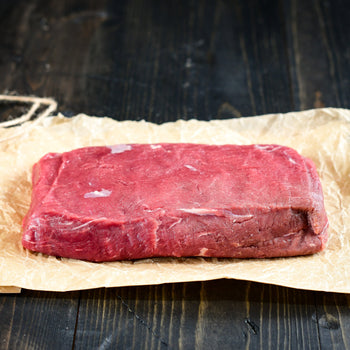
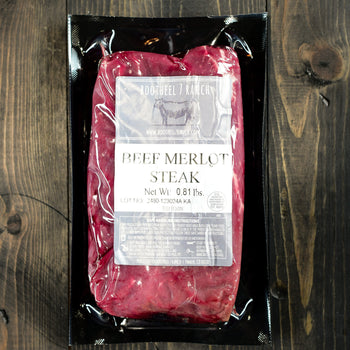
The Merlot Steak is similar in appearance to the Flank Steak, but with a finer texture. Best cooked pan seared or grilled, finish with a pinch of sea salt to amplify the flavor.
Approx 8-12oz Steak
The Merlot steak is one of my favorite cuts from B7R! It’s delicious, meaty, and great for grilling. It’s a great way to compliment the incredible flavor that B7R meat has with their sustainable farming practices and humane processing.
I love that this 100 Grass Fed and locally sourced! Healthy, delicious beef for the win!!
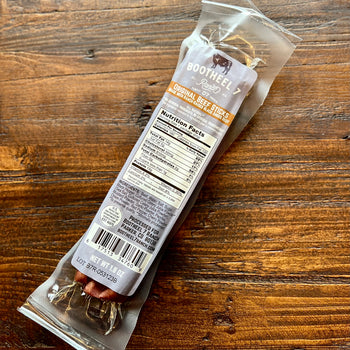
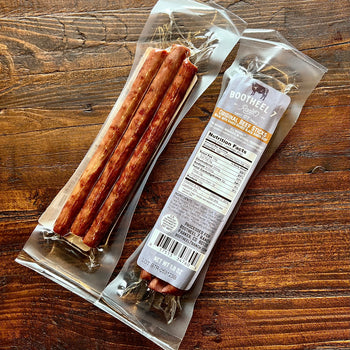
Brand new to the B7R Jerky Collection!
The classic, mild beef stick flavor you love with just a hint of smoke! A protein-packed snack made with premium beef cuts and clean ingredients you can feel good about feeding your family. With a little "snap" in each bite, they are the perfect pre/post workout, easy-to-pack lunch, or afternoon snack on the go!
2.65oz, peelable package - 3 sticks per package.
*Please note, second image shows two product packages to display item texture only. Customer will receive one package per quantity ordered.
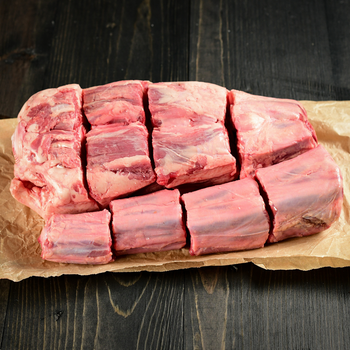
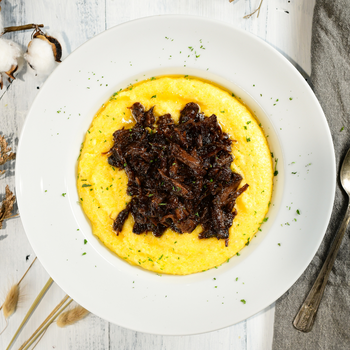
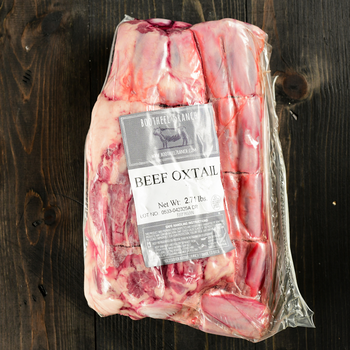
Oxtail are some of the most flavorful soup bones available. Give them a try in oxtail soup!
Approx 1.75lbs per package
These oxtails are awesome. Nicely trimmed and meaty! You won’t be disappointed. Just ordered more.
Really can’t beat the price and quality! Please bring them back in stock!
Bravo Bootheel 7 Ranch!!
Ordering was easy. The price for the meat was very good...and the quality EXCELLENT!!
I felt like I was, for the first time, actually getting my money's worth.
The fat was trimmed down perfectly & the packaging was done well.
There is nothing like buying straight from the ranch.
I will be making more purchases in the neat future.
You are greatly appreciate!
Best
K.
*IF there were anything to stop me from future orders, it will be due to the shipping costs...NOT because of quality or service**
Hi K, Thank you so much for your 5* review - we are happy to hear you enjoyed your order! We aim to keep shipping costs as manageable as possible, and we would be happy to help you build an order that will optimize the cost of shipping. Please reach out to us at hello@bootheel7ranch.com before placing your order next time and we'll go from there! Thank you for your support of our homegrown family business. Best, Team B7R
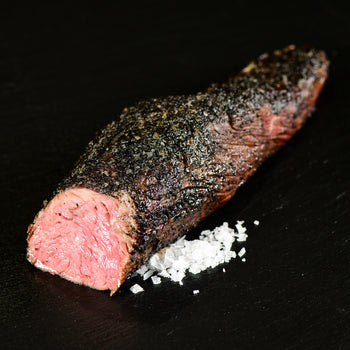
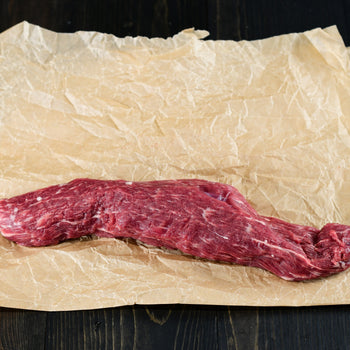
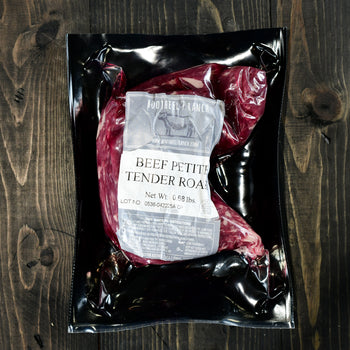
The Petite Tender or Terres Major, aka "Bistro Filet" is a small, lean cut from the chuck primal of the cow. It's a relatively rare steak to find in stores because it takes a butcher more time and skill to cut. Juicy and tender, it's second only to the tenderloin but is more affordable. Perfect to grill or broil.
(.5-1lb)
These are unique and great for a dinner for two. I cook on the grill, let it rest, and slice into medallions. We’ve never had this cut before B7R and now we order it all the time!
OK, these tenders don't have any fat...very little actually. Well seasoned and diced up, they make GREAT kabobs. I cube them up, season them with sea salt, garlic salt and black pepper and then combine them on skewers with red peppers, bacon (wink), and red onions. And then...off to the grill. Ahh-mazing. The meat stays tender and doesn't dry up. Great over a bed of rice or rissotto!
I grilled our first petite tender tonight and it was awesome! A perfect size to make a meal for my wife and me. Thanks for another great cut of beef.
Perfect for when my husband and I want to splurge; just big enough for the two of us. Delicious!
We love all your products especially when you have items on sale! Best meat a person can buy!
Howdy Mike - we're so glad to hear you're enjoying B7R products. Be sure to shop the end-of-summer steak sale, now through Labor Day. It's a great chance to stock your steak inventory for winter - save up to 29% on our bestselling steaks.
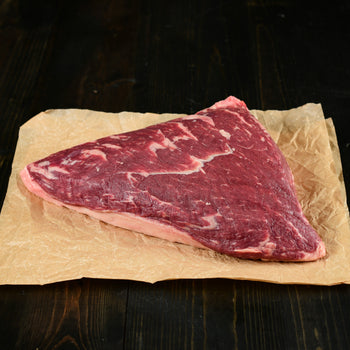
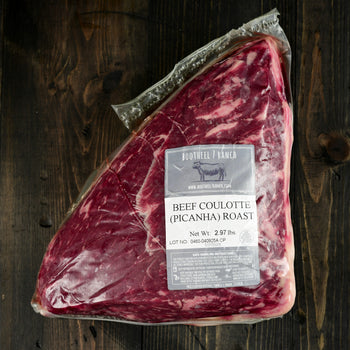
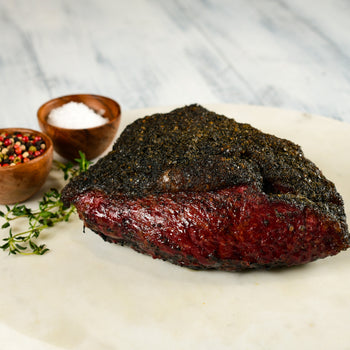
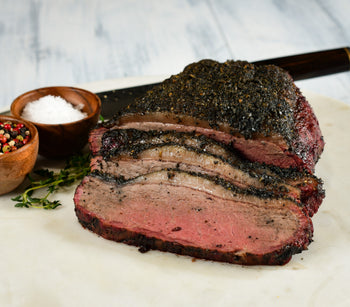
Try something out of the ordinary with this hard-to-find cut prized by Brazilian steakhouses. Our Picanha roasts are cut from the cap of top sirloin, with a nice 'fat cap' that makes them moist and tender. The flavor this cut delivers is impossible to find in any other product.
Prepare as a hearty roast or slice into individual steaks. Once you 'know' about picanha, you know - it's a B7R fan favorite!
You can prepare it as steaks on the grill - cut up 1in portions - and then rolled up on skewers.
Oven - easy preparation - many, many great recipes online. Key is to score the fat, season well with salt and garlic and cook with the fat on the top so that as it cooks it gets crispier and as it melts it will do so into the meat itself. Enjoy!
Overall an excellent cut by an excellent ranch!
Flavorful and tender! Good piece of beef!
My husband was intrigued by this cut of roast as he had never heard of it. I am sure it will be a hit just as all the other products from Boot Heel 7! Giving it 5 stars right now!
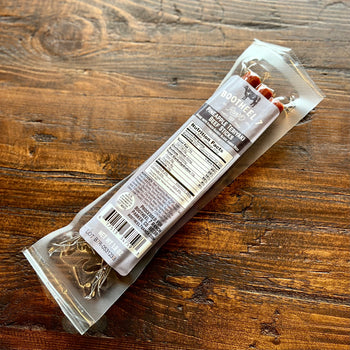
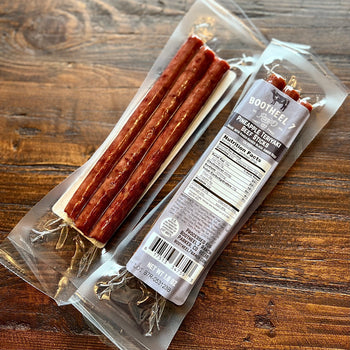
A perfect mix of sweet and savory, our new Pineapple Teriyaki Beef Sticks are tangy and flavorful with just a hint of pepper! A protein-packed snack made with premium beef cuts and clean ingredients you can feel good about feeding your family. Kid-approved as a delicious, nutrition-packed snack for on the go or in between practices!
3.2oz peelable package - 2 sticks per package.
*Please note, second image shows two product packages to display item texture only. Customer will receive one package per quantity ordered.
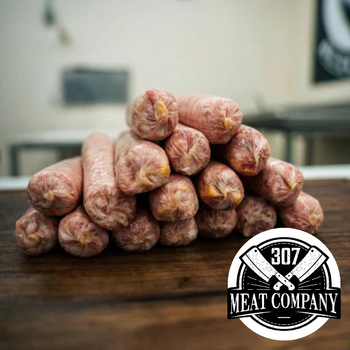
New from our partners, 307 Meat Company, add these Jalapeno Cheddar Pork bratwursts to any tailgate or backyard BBQ for a juicy and flavorful grill top staple.
The bratwurst combines cheddar cheese and jalapeños for a flavorful, right-amount-of-spice bite. They can be prepared on the grill, in the oven, or on the smoker - however you like! Each is a flavor bomb packing a hearty punch and elevating the menu at your get-togethers.
*1.25lb per pack, 5 brats per pack
*Please note, images featuring more or less than 5 brats are used simply to show texture of the product.
Although a new addition to the B7R shop, this product is the result of our longstanding partnership with 307 Meat Company. 307 is a full-service craft butcher shop and retail store in Laramie, WY – just about the halfway point between Denver and the pastures of Bootheel 7 Ranch in Lusk, WY.We’re proud to carry 307 pork products and see our 307 partners expand their reach to B7R customers.
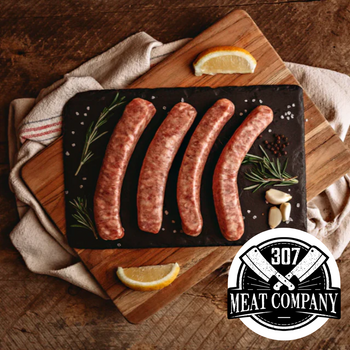
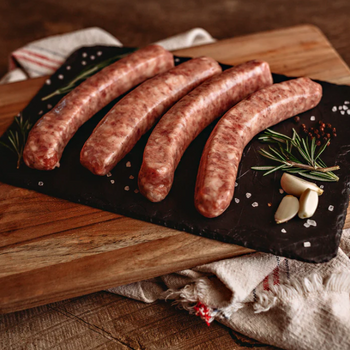
New from our partners, 307 Meat Company, add these Maui Wowi, Pineapple Teriyaki Pork sausages to any brunch, tailgate, or backyard BBQ for a juicy and flavorful grill top staple.
This sausage combines pineapple and teriyaki for a flavorful, just-right balance of sweet and savory bite. They can be prepared on the grill, in the oven, or on the smoker - however you like! Each is a flavor bomb packing a hearty punch and elevating the menu at your get-togethers.
*1.25lb per pack, 5 per pack
*Please note, any images featuring more or less than 5 brats are used simply to show texture of the product.
Although a new addition to the B7R shop, this product is the result of our longstanding partnership with 307 Meat Company. 307 is a full-service craft butcher shop and retail store in Laramie, WY – just about the halfway point between Denver and the pastures of Bootheel 7 Ranch in Lusk, WY.We’re proud to carry 307 pork products and see our 307 partners expand their reach to B7R customers.
The sausage is really good but it took some time to get used to the flavor. We prefer the jalapeno and cheese sausage, that one is terrific.
Scott, Thanks for your honest review! Your feedback is important to us - and we're so glad to hear you're enjoying a few of our products. We appreciate your business. - Team B7R


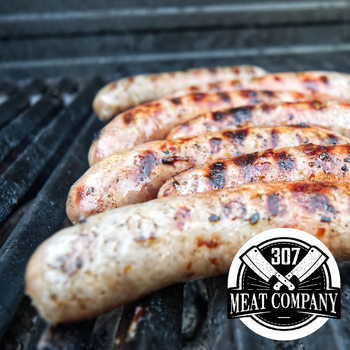
New from our partners, 307 Meat Company, add these Wisconsin-style PORK bratwursts to any backyard BBQ for a juicy and flavorful summer staple.
Imagine the classic ginger-mace-nutmeg flavor, the majority of "Wisconsin-style" bratwurst is usually made from coarsely ground pork with a consistency that is more like Italian sausage. Traditional bratwurst has a more emulsified and smooth texture. Each is a flavor bomb packing a hearty punch and elevating your summer get-togethers.
*1.25lb per pack, 5 brats per pack
*Please note, images featuring more or less than 5 brats are used simply to show texture of the product.
Although a new addition to the B7R shop, this product is the result of our longstanding partnership with 307 Meat Company. 307 is a full-service craft butcher shop and retail store in Laramie, WY – just about the halfway point between Denver and the pastures of Bootheel 7 Ranch in Lusk, WY.We’re proud to carry 307 pork products and see our 307 partners expand their reach to B7R customers.
Absolutely delicious bratwurst!
Low fat content.
Flavor is spot on. Keep on buying more and more!
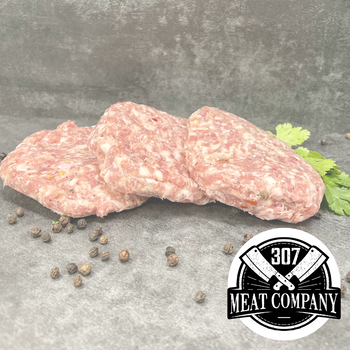
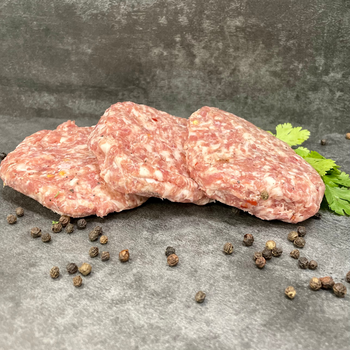
Be the first to try the all-new breakfast sausage patties from our partners, 307 Meat Company. 307’s customer-favorite classic breakfast sausage, now in patty form for your convenience. These patties are a rich, mouth-watering must-have for breakfast sandwiches – not to mention, great for meal prep, tailgates, campfires – you name it!
*1lb Packs
*Locally-produced, nitrate-free
*All natural, antibiotic-free, no hormones
Although a new addition to the B7R shop, this product is the result of our longstanding partnership with 307 Meat Company. 307 is a full-service craft butcher shop and retail store in Laramie, WY – just about the halfway point between Denver and the pastures of Bootheel 7 Ranch in Lusk, WY. This premium, locally-produced product is sourced from twenty family-owned farms who promote and practice sustainable agriculture, and devote individualized attention to the animals. We’re proud to carry 307 pork products and see our 307 partners expand their reach to B7R customers.
This sausage is very tasty and safe for someone with onion and garlic sensitivity. The only thing I didn’t like was that the patties are burger sized. Too big to serve with a normal breakfast unless you’re a linebacker!
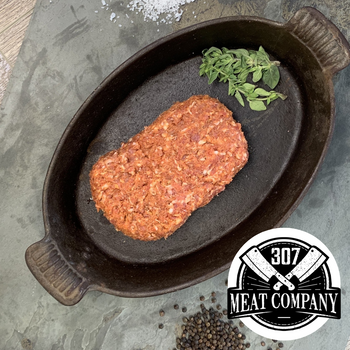
New to B7R shelves, this Wyoming Pork Chorizo is a product from our partners, 307 Meat Company. Chorizo is known for being a deeper red in color and the flavor is packed with spices. Chorizo recipes and styles can vary, 307's Wyoming Pork Chorizo has a hint of spice, but not too spicy.
*1LB
*Locally-produced, nitrate-free
*All natural, antibiotic-free, no hormones
Although a new addition to the B7R shop, this product is the result of our longstanding partnership with 307 Meat Company. 307 is a full-service craft butcher shop and retail store in Laramie, WY – just about the halfway point between Denver and the pastures of Bootheel 7 Ranch in Lusk, WY.We’re proud to carry 307 pork products and see our 307 partners expand their reach to B7R customers.
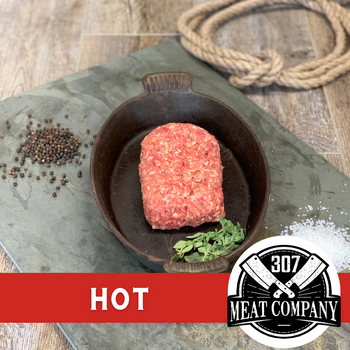
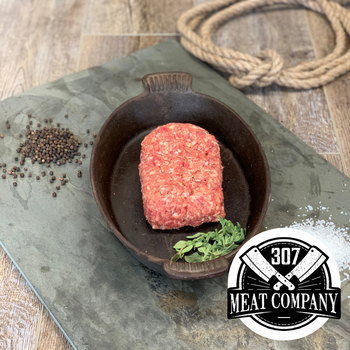
New from our partners, 307 Meat Company, this hot Italian sausage is characterized by a bold, spicy, and savory flavor profile with just a small kick of heat.
Product weight: 1LB
Although a new addition to the B7R shop, this product is the result of our longstanding partnership with 307 Meat Company. 307 is a full-service craft butcher shop and retail store in Laramie, WY – just about the halfway point between Denver and the pastures of Bootheel 7 Ranch in Lusk, WY.We’re proud to carry 307 pork products and see our 307 partners expand their reach to B7R customers.
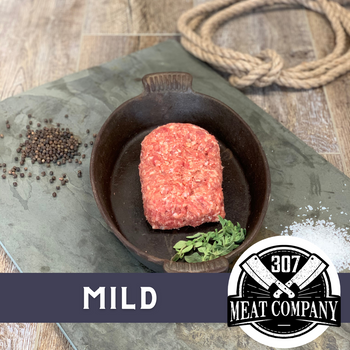

New from our partners, 307 Meat Company, this mild Italian sausage is characterized by its savory, slightly sweet, and aromatic flavor profile, making it versatile for various dishes.
Product weight: 1LB
Although a new addition to the B7R shop, this product is the result of our longstanding partnership with 307 Meat Company. 307 is a full-service craft butcher shop and retail store in Laramie, WY – just about the halfway point between Denver and the pastures of Bootheel 7 Ranch in Lusk, WY.We’re proud to carry 307 pork products and see our 307 partners expand their reach to B7R customers.
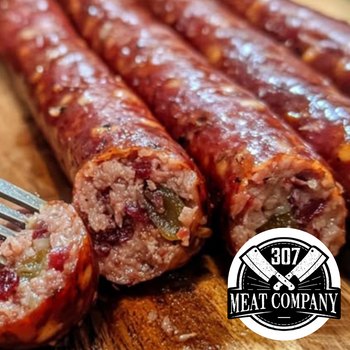
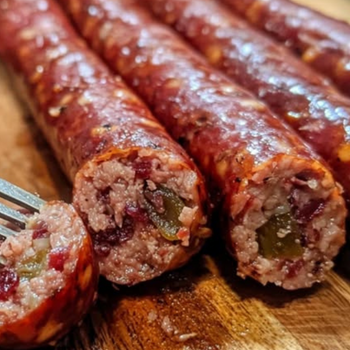
New from our partners, 307 Meat Company, add these Cranberry Jalapeno Mozzarella Pork sausages to any brunch, tailgate, or backyard BBQ for a juicy and flavorful grill top staple.
This sausage combines cranberry and jalapeños for a flavorful, just-right balance of sweet and spice bite, and the mozzarella tops it off with a bit of creamy goodness! They can be prepared on the grill, in the oven, or on the smoker - however you like! Each is a flavor bomb packing a hearty punch and elevating the menu at your get-togethers.
*1.25lb per pack, 5 per pack
*Please note, images featuring more or less than 5 brats are used simply to show texture of the product.
Although a new addition to the B7R shop, this product is the result of our longstanding partnership with 307 Meat Company. 307 is a full-service craft butcher shop and retail store in Laramie, WY – just about the halfway point between Denver and the pastures of Bootheel 7 Ranch in Lusk, WY.We’re proud to carry 307 pork products and see our 307 partners expand their reach to B7R customers.
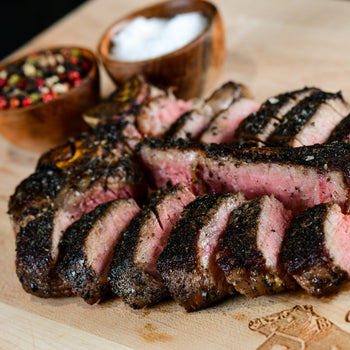
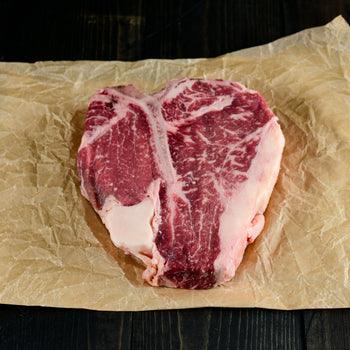
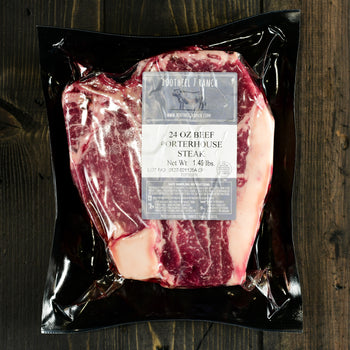
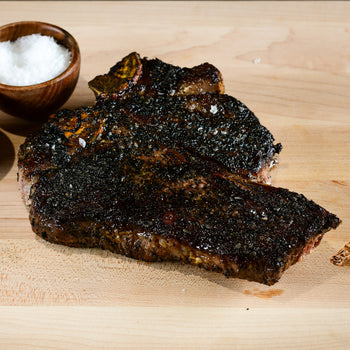
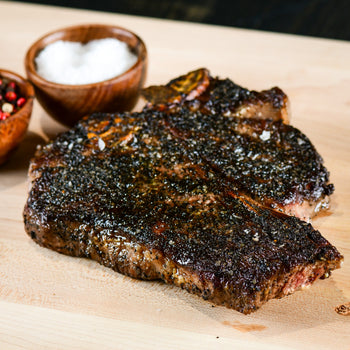
The Porterhouse is a prized steakhouse cut with NY Strip on one side of the bone, and our largest proportion of Tenderloin (filet mignon) on the other. It's a T-Bone Steak of mighty proportions! With our standard 21 day dry-age, this king of cuts is sure to impress.
(1.5-1.75lbs)
Plenty to go around on this trophy steak. B7R never disappoints! This is great for a dinner with friends. I like to send them as gifts too when I can’t grill one up for a friend in person.
We just had the porterhouse last night. It was the best! But we say that about all the steaks from Bootheel! I had the leftovers for breakfast, it was that good! We only buy our meat from here.
The steak was good, but the shipping was so unexpectedly expensive that I won’t order again.
The Porterhouse steak from Bootheel7 Ranch is one of our very favorite steaks. The flavor is unmatched - you seriously can’t find a tastier and juicer steak! Thank you!
Susan, We appreciate your 5* review of the Porterhouse, and hope our beef continues to stun everyone at your dinner table. Thanks for supporting our homegrown family business. Best, Team B7R
We just cooked up our Porterhouse last night and what can I say but delicious. The cut is beautiful and the meat tender and flavorful, I’ll be ordering more and love to share with family to spread the delicious news. Enjoy!
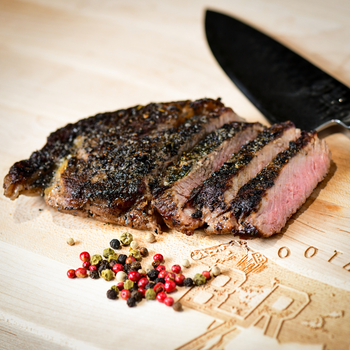
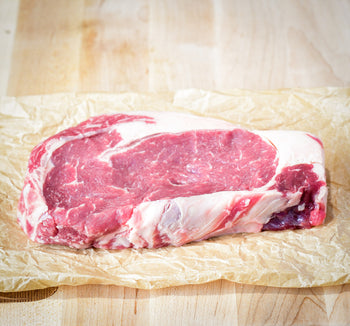
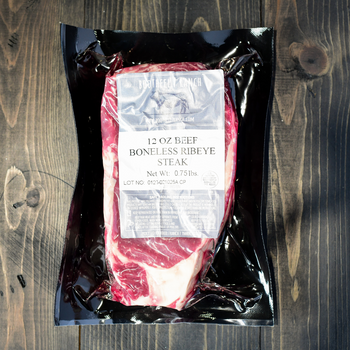
A crowd favorite here at the ranch, these 12oz boneless ribeyes have incredible marbling and stand out as one of our most tender, juicy cuts. A 21-day, dry-aged B7R ribeye is hard to beat!
Great flavor and marbling. Literally "farm to table" with their delivery service.
Hi Mike, We're so glad to hear you enjoyed your order! Thank you for your 5* review, and for your support of our homegrown family business.
Best,
Team B7R
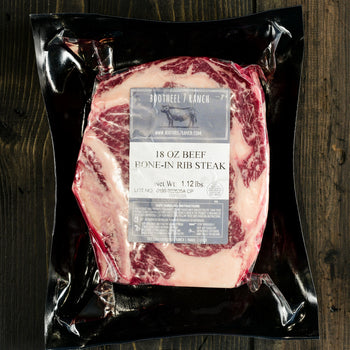
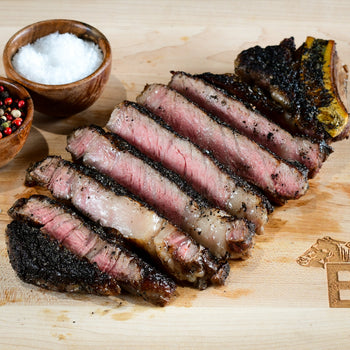
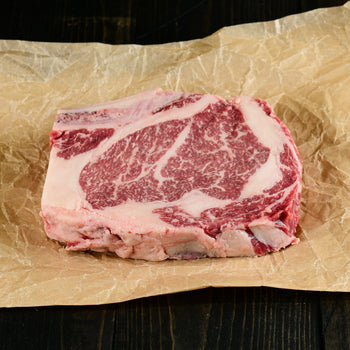
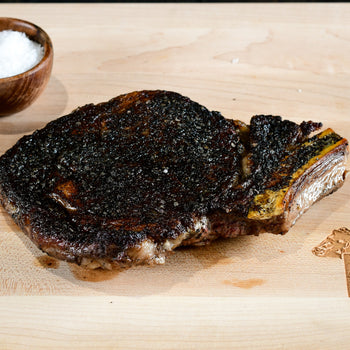
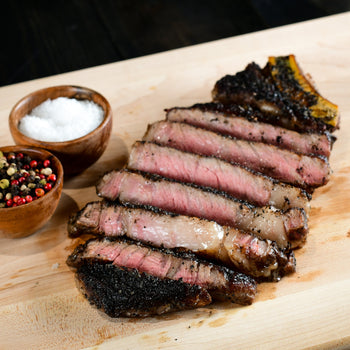
A crowd favorite here at the ranch, our bone-in ribeyes have incredible marbling and stand out as one of our most tender, juicy cuts. A 21 day dry-aged B7R ribeye is hard to beat!
Approx 1.12lbs
Bootheel continues to be the best in customer service and product satisfaction! These steaks do not disappoint, juicy and delicious, get you some!!!!!
Sean Suppi Highlands Ranch , CO
My husband and I started ordering from Bootheel7 ranch over a year ago and have been totally satisfied! The meat is tender and full of flavor. Highly recommend!
We only but steaks from Boothel 7 and these are our favorite steaks. Stay home, turn on the smoker, and eat a delicious steak dinner for a fraction of restaurant prices and just as high quality.
Cooked one on my Trager and it was wonderful.
My husband loves bone-in ribeye and he has tried others, but when he ate the one from Bootheel 7 Ranch it was a game changer and it is now the only place we buy them from.
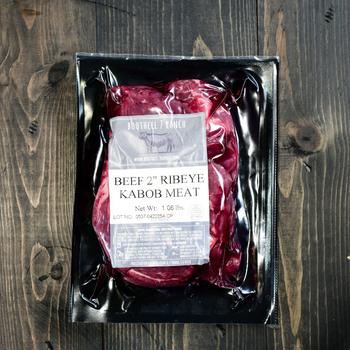
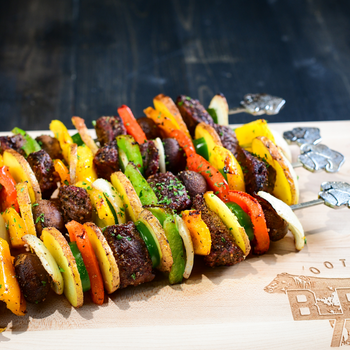
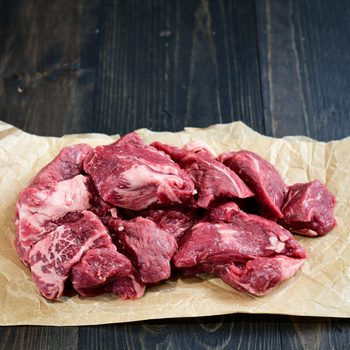
Ribeye Steak Tips for Kabobs
Tender, juicy, and packed with rich, beefy flavor — our Ribeye Steak Tips are the perfect choice for your next grilling adventure. Hand-cut from premium ribeye, these steak tips are naturally marbled for maximum tenderness and mouthwatering taste. Ideal for kabobs, stir-fries, or quick searing, they cook beautifully on skewers alongside your favorite vegetables.
Raised with care and expertly prepared, our ribeye tips deliver a melt-in-your-mouth experience with every bite. Whether you’re hosting a backyard barbecue or a cozy family dinner, these steak tips make it easy to impress.
Key Features:
Hand-cut from premium ribeye steaks
Perfectly sized for kabobs, stir-fries, and more
Rich marbling ensures tender, juicy results
Responsibly raised with a focus on quality and flavor
Grill. Savor. Repeat.
Approx. 1lb per package
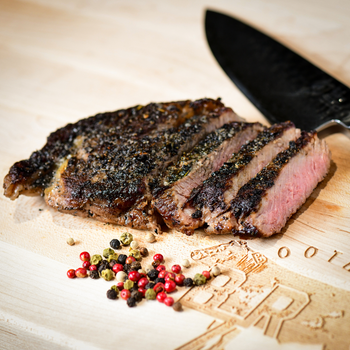
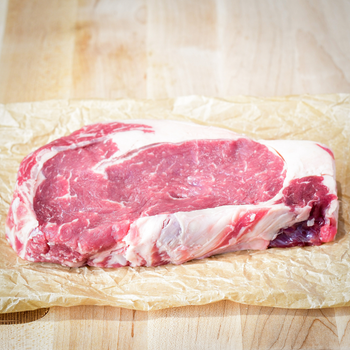
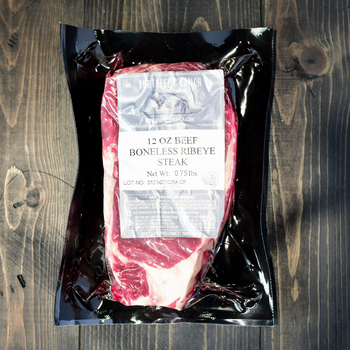
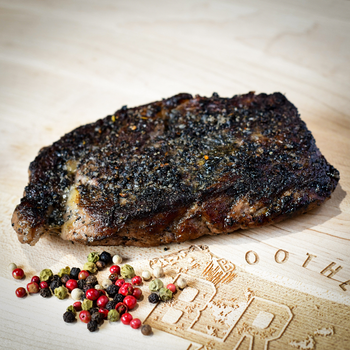
Boneless Ribeye, 12oz: Buy 5, Save $5
Save $5.00 when you buy this bundle of (5) 12oz Boneless Ribeyes.
A crowd favorite here at the ranch, these 12oz boneless ribeyes have incredible marbling and stand out as one of our most tender, juicy cuts. A 21-day, dry-aged B7R ribeye is hard to beat!
Approx. 12oz per steak-This bulk order includes approximately 3.75lbs of Boneless Ribeyes.
Ribeyes are perfect! Grilled them up and they are some of the best ribeyes!!
Top notch!
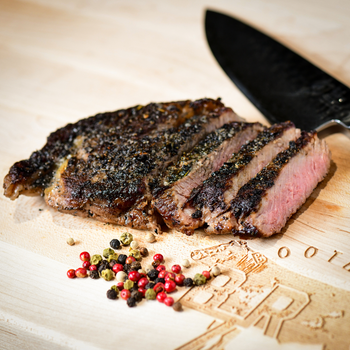
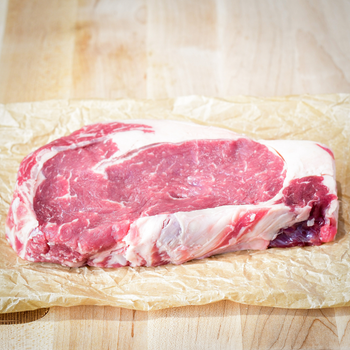
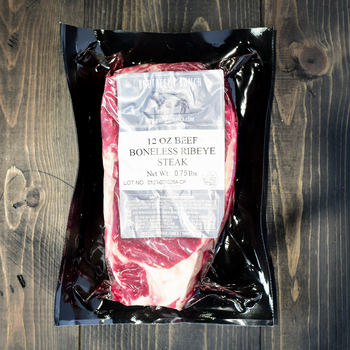
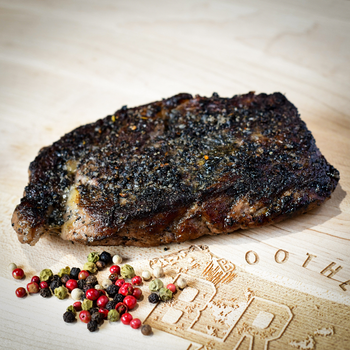
Boneless Ribeye, 12oz: Buy 9, Get 1 FREE
Earn (1) FREE steak when you buy this bundle of (9) 12oz Boneless Ribeyes (10 steaks total).
A crowd favorite here at the ranch, these 12oz boneless ribeyes have incredible marbling and stand out as one of our most tender, juicy cuts. A 21-day, dry-aged B7R ribeye is hard to beat!
Approx. 12oz per steak-This bulk order includes approximately 7.5lbs of Boneless Ribeyes.
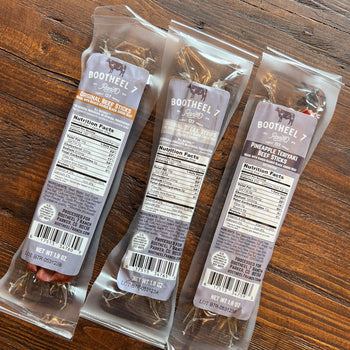
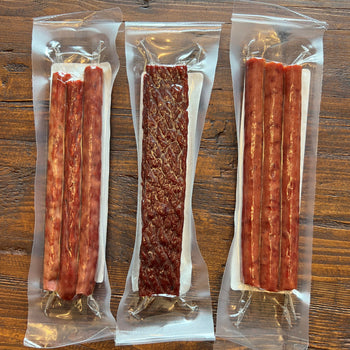
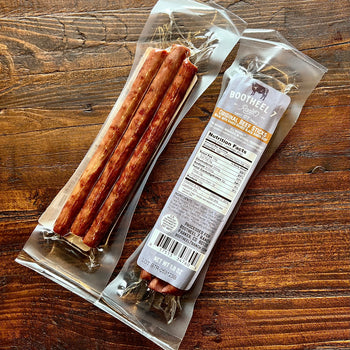
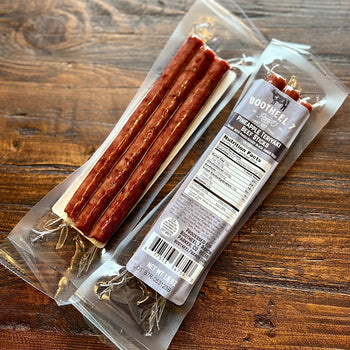
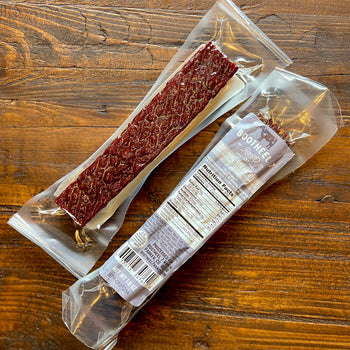
Our NEW beef stick and steak strip products are finally here! Buy in bulk and save - these items have become customers' new favorites!
Customers receive one package of each new product, multiples in product images are meant only to display texture.
Pineapple Teriyaki Beef Sticks
Tangy and flavorful, witha hint of pepper. - Approx. 1.8oz peelable package, 3 sticks per package.
Original Steak Strips
Black pepper, paprika, and red pepper, a mild kick you will love. - Approx. 1.8oz peelable package, 3 strips per package.
Original Beef Sticks
The classic flavor you grew up with, a bit of Nostalgia in every bite. - Approx. 1.8oz peelable package, 3 sticks per package.
Total shipping weight, approx. .5LBs
I tried these for the first time. I can’t close a favorite. They were all delicious. Perfect snack or picnic on the go.
Delicious and healthy
We threw this in our order just to give them a try. These beef sticks were awesome. They tasted great and did not last long! We will need to order several next time we place our order :)
These beef sticks are delicious, a quick healthy snack. My kids devoured the pineapple teriyaki ones!

It's here! Always a holiday favorite, our BONE-IN prime rib roast is the most desirable cut for any holiday or special event. With our 21 day dry-age, our rib roast will be sure to WOW your holiday crowd with tenderness and flavor!
Limited quantity available. We will continue to restock through the holiday season, so if your first choice is gone - stay tuned, and check back for restocks!
Please note: Prime Rib roasts are trimmed and have had the fat cap removed (not the spinalis dorsi).
Book your ticket to flavor town. Much better flavor than comparable rib roasts from the grocery store.
Hey, Sean! Happy to hear you enjoy our 21-day dry age. We appreciate your 5* review, and hope our beef continues to stun everyone at your dinner table. Thanks for supporting our homegrown family business. Best, Team B7R
Scrumptious!
Thanks, Pat! So happy to hear you enjoyed our Prime Rib. - Best, Team B7R

It's here! Always a holiday favorite, our BONELESS prime rib roast is the most desirable cut for any holiday or special event. With our 21 day dry-age, our rib roast will be sure to WOW your holiday crowd with tenderness and flavor!
Limited quantity available. We will continue to restock through the holiday season, so if your first choice is gone - stay tuned, and check back for restocks!
Please note: Prime Rib roasts are trimmed and have had the fat cap removed (not the spinalis dorsi).
Reverse Seared in the smoker. The best prime rib my family ever had according to them!
Dry brined in the fridge for 48 hours with coarse salt then mustard and Kinders and in to the smoker it went.
Hey Michael, Thank you so much for spreading the word about Bootheel 7 Ranch with your family! We greatly appreciate your 5* review and support of our homegrown family business. Best, Team B7R
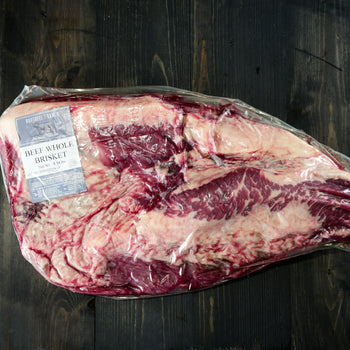
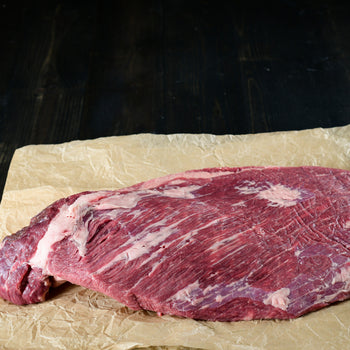
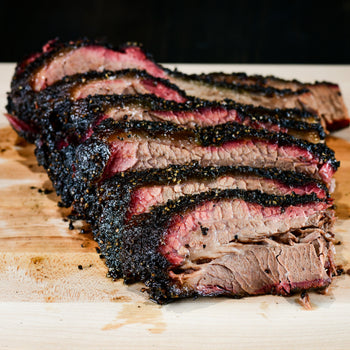
A classic for the smoker! Our competition-grade whole beef brisket is big, thick, well-marbled, and includes both the flat-cut and the point. Also great for the slow cooker or a Texas style BBQ experience.
This brisket is a crowd favorite at our house. People can’t get enough of it. Turns out fantastically on the smoker.
Awesome Brisket Son in-law smoked it and it was awesome
Hey, Ed! Happy to hear our brisket was an experience the whole family could enjoy. We appreciate your 5* review, and hope our beef continues to stun everyone at your dinner table. Thanks for supporting our homegrown family business. Best, Team B7R
I ordered this brisket for a party we had for a lot of our neighbors. We smoked it on our “egg” and it was the best brisket we have ever tasted. We thought we would have more left overs than we did but everyone raved about it and went back for seconds. So, that is definitely a testament to the brisket! Bootheel is the best!
We are so glad we found Bootheel 7 Ranch. Their beef is amazing. You can taste the difference, not just compared to what we get from the grocery store, but from top local meat stores. We've ordered a variety of products from ground beef to steaks. Just smoked a brisket and it was melt-in-our-mouths fantastic. Tri Tip is excellent. Love the steaks. Delivery is convenient. Highly recommend!
12 pound brisket smoked for 9 hours was very tender and flavorful. We loved it!
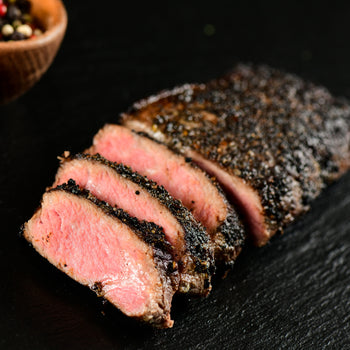
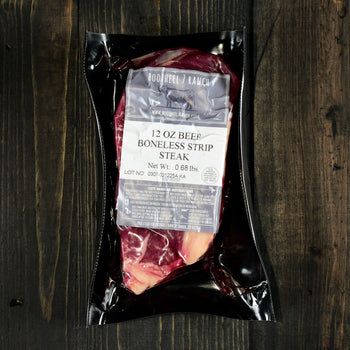
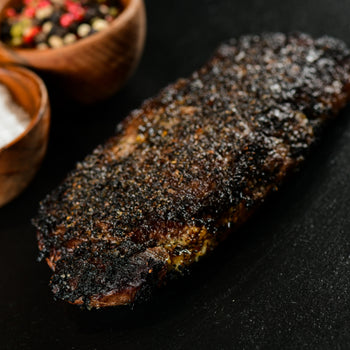
Crowned the king of all steaks, our 12oz New York Strip Steaks are cut from the center of the loin. This savory, juicy steak is well marbled and trimmed to perfection. Steak connoisseurs value its rich flavor and consider it a favorite grilling steak!
Love B7R’s Strip Steak! Tons of flavor. I always order a NY Strip when I go out and it never compares to what we can make at home with B7R!
This New York Strip Steak was incredibly flavorful and delicious. I reverse seared it on my Traeger. Came out perfect. Will buy again.
You have spoiled me to what beef should taste like and I cannot go back. Your products are simply amazing. My personal favorites are the flat iron, NY strip, and stew meat but honestly there are no bad choices. The delivery is great as well and always on time.
Brea - WOW, thank you so much for the stellar 5* review! We hope our beef continues to stun everyone at your dinner table. Thank you for supporting our homegrown family business. Best, Team B7R
So good! Looking forward to buying more and supporting local!
All the steaks are excellent, love the local delivery.



The Denver Steak has the qualities of both a Ribeye and a NY Strip Steak in one! Well marbled, this delicious cut carries all the depth of flavor associated with the chuck while remaining super tender. Grill or pan sear to medium-rare and slice against the grain for a show-stopping meal.
2 steaks per package, approx. 1.5lb per package
*Please note the label on the packaging may read 'Short Ribs (Denver Style).'
I’ve never had a Denver steak until seeing on B7R’s website. It has a ton of flavor and reminded me of the ribeye cap - but at a fraction of the price. Fun one to try to add some variety to your menu.
These steaks were so delicious. Great flavor and a good price.
Delicious.
We found steak to have much more fat than we anticipated. I grilled them on the stove to medium rare. Some pieces were really good, but a lot we threw out.
Every Sunday we have my Dad over for dinner. He's an old cowboy who loves good beef! We marinate it as it thaws in a half cup of teriyaki or orange sauce, then my husband grills it at 475 degrees with the grill closed; 10 minutes on one side, then 12 minutes on the other side, and slices it cross grain. One package of Denver Steak easily feeds all three of us, and it tender and delicious.
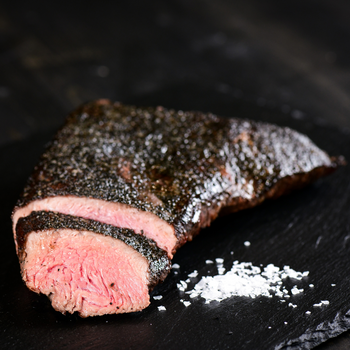
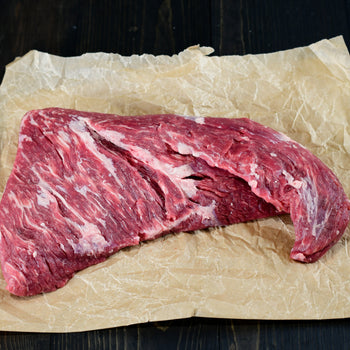
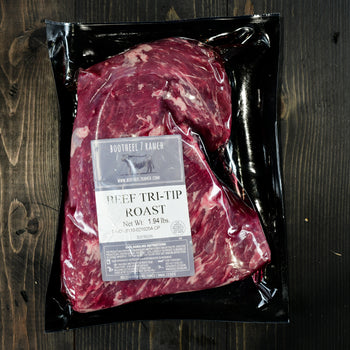
Often referred to as a 'California Tri-Tip,' ours are well-marbled and can be prepared as a roast or sliced into steaks. An excellent option for a summer BBQ! Dry aged for 21 days.
Approx 1.5-2lbs
This has been an awesome discovery. I love how tender and flavorful this meat is.
Maria - we're so glad you found us, and that you are enjoying our products! Thank you so much for your support of our family business. - Team B7R
Seriously...an excellent choice for an oven roast or on the grill. YEARS purchasing these cuts and have never been disappointed.
Jeremi - It's great to hear that you are a longtime B7R fan! We're grateful for your continued business - Thank you for your 5* review, and for your support of our homegrown family operation.
Best,
Team B7R
This is great Tri-Tip! We put two Tri-Tips on the smoker, one from Boothill 7 and one from a local high-end meat store. Boothill 7's Try-Tip was a little smaller, but tasted better. Like other Boothill 7 meats, we could taste the difference.
We are so happy to hear you were pleased with your order, Wayne! And very glad that our product surpassed another local contender. Thank you very much for your review. - Team B7R
We have yet to try anything from Bootheel 7 Ranch that isn't superb! This piece of meat was flavorful and delicious!
Theses tri tips cook up great with great flavor!
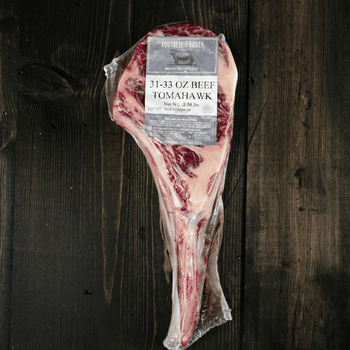
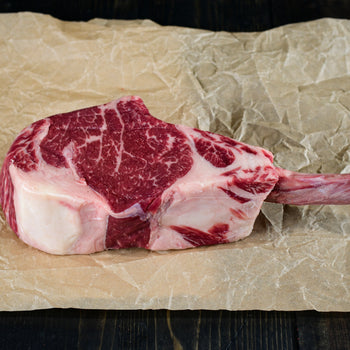
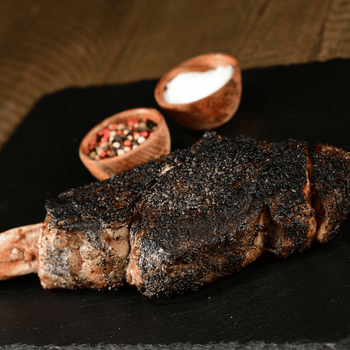
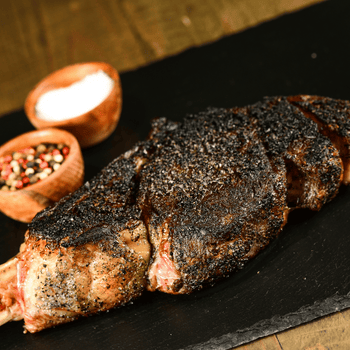
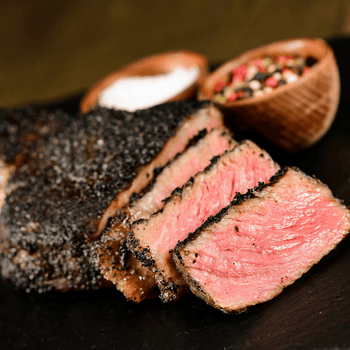
Satisfy your inner caveman with our largest and most impressive steak, the one and only Tomahawk! A large, center-cut, bone-in Ribeye and Ribcap with a long, caveman style bone. Perfect to share for a special occasion!
40oz, Approx 2.5lbs
32oz, Approx 2lbs
I save the tomahawk for when we have friends over and it never fails to impress. The size, succulence and flavor are unmatched. This baby can easily feed the whole table (~4 people). Do yourself a favor and bring out the big guns from Bootheel7 next time you have a party.
Dry aged beef. Yum!
We have purchased these since the pandemic and they are our monthly treat. We love that we can have them as a steak and a cheat "Sunday roast". We sear on grill and then finish in oven and we will sometime slice like a "roast". Saves time when we want that traditional roast beef type dinner.
I buy your hamburger all the time now and have become popular in the neighborhood and with my golf buddies for making smash burgers. The 90% beef is so red and fresh compared to grocery stores. I have also purchased about $500 of your other cuts this past month so anxious to try.
I ordered two large sized Tomohawks and grilled them on the Weber with charcoal. Indirect each side for 10 minutes then finished with a direct sear until blackened. Best thing to ever come off the grill.
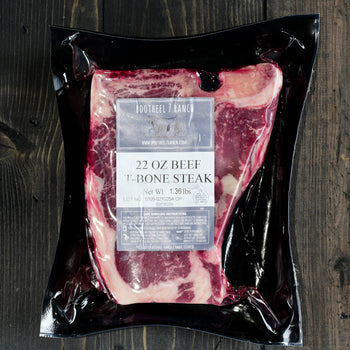
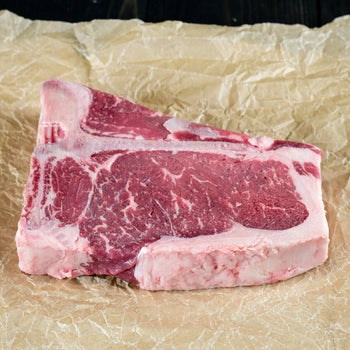
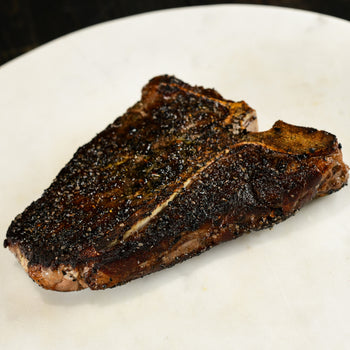
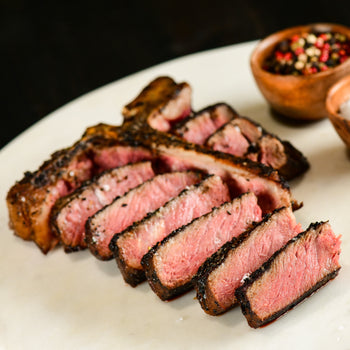
This classic steak lovers cut combines two great cuts in one divided by a t-shaped bone: the larger segment of steak is from the strip loin (NY Strip Steak) and the smaller section is tenderloin (the Porterhouse has the largest tenderloin portion). Incredible flavor and a steakhouse favorite!
Approx 1.35lb
This is my favorite steak because it has the best of all worlds - strip and tenderloin. The T-Bone size is perfect for a dinner party. I love to carve the steak off the bone right at the table for everyone to enjoy. The unique dry-aging process deployed by B7R provides a flavor and tenderness that I’ve never been able to replicate from store bought steaks. We love it!
Wonderful flavor. Cook them sous vide and finish on the grill. Very juicy.
There is no other place I want a T-bone from. Tender, flavorful and juicy. Absolute perfection!
Always a pleasure to do business with.





A crowd favorite here at the ranch, our bone-in ribeyes have incredible marbling and stand out as one of our most tender, juicy cuts. A 21 day dry-aged B7R ribeye is hard to beat!
Approx 1.12lbs
Bootheel continues to be the best in customer service and product satisfaction! These steaks do not disappoint, juicy and delicious, get you some!!!!!
Sean Suppi Highlands Ranch , CO
My husband and I started ordering from Bootheel7 ranch over a year ago and have been totally satisfied! The meat is tender and full of flavor. Highly recommend!
We only but steaks from Boothel 7 and these are our favorite steaks. Stay home, turn on the smoker, and eat a delicious steak dinner for a fraction of restaurant prices and just as high quality.
Cooked one on my Trager and it was wonderful.
My husband loves bone-in ribeye and he has tried others, but when he ate the one from Bootheel 7 Ranch it was a game changer and it is now the only place we buy them from.



A crowd favorite here at the ranch, these 12oz boneless ribeyes have incredible marbling and stand out as one of our most tender, juicy cuts. A 21-day, dry-aged B7R ribeye is hard to beat!
Great flavor and marbling. Literally "farm to table" with their delivery service.
Hi Mike, We're so glad to hear you enjoyed your order! Thank you for your 5* review, and for your support of our homegrown family business.
Best,
Team B7R



Ribeye Steak Tips for Kabobs
Tender, juicy, and packed with rich, beefy flavor — our Ribeye Steak Tips are the perfect choice for your next grilling adventure. Hand-cut from premium ribeye, these steak tips are naturally marbled for maximum tenderness and mouthwatering taste. Ideal for kabobs, stir-fries, or quick searing, they cook beautifully on skewers alongside your favorite vegetables.
Raised with care and expertly prepared, our ribeye tips deliver a melt-in-your-mouth experience with every bite. Whether you’re hosting a backyard barbecue or a cozy family dinner, these steak tips make it easy to impress.
Key Features:
Hand-cut from premium ribeye steaks
Perfectly sized for kabobs, stir-fries, and more
Rich marbling ensures tender, juicy results
Responsibly raised with a focus on quality and flavor
Grill. Savor. Repeat.
Approx. 1lb per package




Try something out of the ordinary with this hard-to-find cut prized by Brazilian steakhouses. Our Picanha roasts are cut from the cap of top sirloin, with a nice 'fat cap' that makes them moist and tender. The flavor this cut delivers is impossible to find in any other product.
Prepare as a hearty roast or slice into individual steaks. Once you 'know' about picanha, you know - it's a B7R fan favorite!
You can prepare it as steaks on the grill - cut up 1in portions - and then rolled up on skewers.
Oven - easy preparation - many, many great recipes online. Key is to score the fat, season well with salt and garlic and cook with the fat on the top so that as it cooks it gets crispier and as it melts it will do so into the meat itself. Enjoy!
Overall an excellent cut by an excellent ranch!
Flavorful and tender! Good piece of beef!
My husband was intrigued by this cut of roast as he had never heard of it. I am sure it will be a hit just as all the other products from Boot Heel 7! Giving it 5 stars right now!





The Porterhouse is a prized steakhouse cut with NY Strip on one side of the bone, and our largest proportion of Tenderloin (filet mignon) on the other. It's a T-Bone Steak of mighty proportions! With our standard 21 day dry-age, this king of cuts is sure to impress.
(1.5-1.75lbs)
Plenty to go around on this trophy steak. B7R never disappoints! This is great for a dinner with friends. I like to send them as gifts too when I can’t grill one up for a friend in person.
We just had the porterhouse last night. It was the best! But we say that about all the steaks from Bootheel! I had the leftovers for breakfast, it was that good! We only buy our meat from here.
The steak was good, but the shipping was so unexpectedly expensive that I won’t order again.
The Porterhouse steak from Bootheel7 Ranch is one of our very favorite steaks. The flavor is unmatched - you seriously can’t find a tastier and juicer steak! Thank you!
Susan, We appreciate your 5* review of the Porterhouse, and hope our beef continues to stun everyone at your dinner table. Thanks for supporting our homegrown family business. Best, Team B7R
We just cooked up our Porterhouse last night and what can I say but delicious. The cut is beautiful and the meat tender and flavorful, I’ll be ordering more and love to share with family to spread the delicious news. Enjoy!



This cut is a hidden gem. Considered the second most tender cut of the cow (only after filet/tenderloin), the flat iron is well marbled and has a robust, meaty flavor like a NY Strip. Popular for grilling and certainly a crowd pleaser!
Approx. 8oz portion size
This is our go-to steak from Bootheel. We love the size, and it is always so tender. The Flat Iron Steak is a staple in our freezer.
High quality meat
Can’t say enough about this cut of meat. Cooked medium rare it literally melts in your mouth. It truly is an amazing steak that offers a variety of cooking methods that will tantalize your palate. We absolutely love this meat!!
We've been buying our beef from Bootheel 7 Ranch for almost 2 years now, and love always having such high quality meat in our freezer. All of it is exceptional, but the flat iron steaks may be my favorite. Tender, juicy, flavorful and at such a great price point so I tend to order a lot of them.
I love these flatiron steaks! They are tender and flavorful and great for slicing and either adding to a salad or just eating alone.
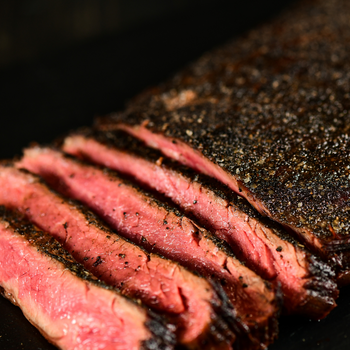
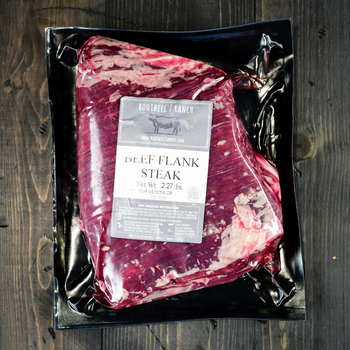
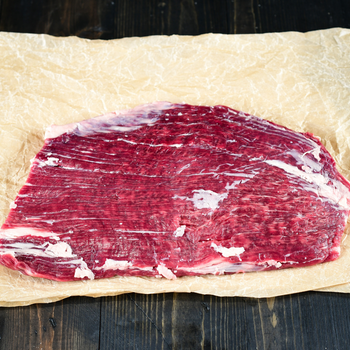
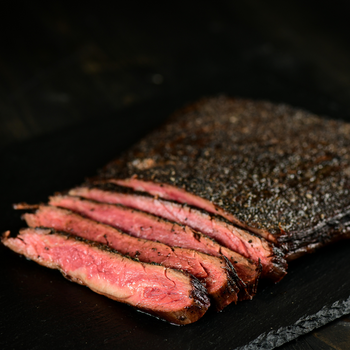
A 21-day dry aged flank steak is hard to beat! The flank is a thin cut, packed full of flavor, and ideal for quick dinners. We love ours marinated overnight, thrown on the grill, and sliced thin against the grain for a delicious steak salad!
Approx 1.5lbs
We use the flank steak to make jerky both for humans and treats for our dog. We all love it!
Really good flavor and very tender.
This is the best beef I have ever tasted. We drive from California to Colorado to visit our daughter. We have the meat delivered to her just so we can drive it home. Absolutely worth the two day drive!
What a hidden gem these flank steaks were. I will order these again.
The ground beef is the only beef I purchase, my dogs get to share the package of the large femur bones & you can’t go wrong with the ribeye from here - what a treat.
I live way down near Monument yet delivery is always prompt & friendly !
These flank steak cuts are REMARKABLE. The perfect amount of marbling for the juiciest and tender bites. Not like the grocery store cuts that you have to cut off half the weight you just paid for.




For a truly unbeatable steak experience, the filet mignon (cut from the beef tenderloin) is definitely your go to! It is the most expensive and sought-after cut of beef, simply because there isn't much of it to go around. It's small and unbelievably tender, making your B7R filet experience truly one to remember!
Individually cut and vacuum-sealed, 21-day dry age.
This is my personal favorite cut! Thank you Bootheel for providing a superior product every time we order! We are never disappointed, only when we run out!
This steak didn’t just change my diet—it rewrote my culinary belief system. This isn’t just meat; it’s a revelation wrapped in marbling. The flavor? Rich, clean, and somehow nostalgic, like it remembers what beef used to taste like before the world got weird. Every bite is a reminder that cows, when raised right, can do magical things.
I now evangelize to friends, family, and unsuspecting strangers at the grocery store. “You haven’t lived,” I whisper, “until you’ve had Bootheel 7.”
Bless you, Bootheel 7. You had me at first sizzle.
⭐️⭐️⭐️⭐️⭐️
I ordered a number of filet mignon’s and they were delicious so I’ve re-ordered more
Hey Steve! Thanks for the 5* review! We're honored to feed your family and that you are loving the filets! We're biased, of course, but agree that they are fantastic cuts :) We appreciate your continued business! - Team B7R
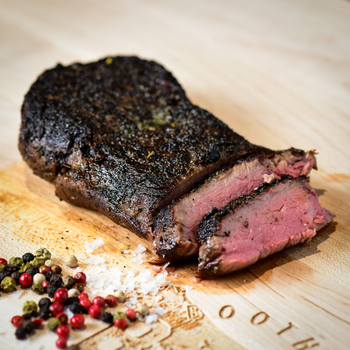
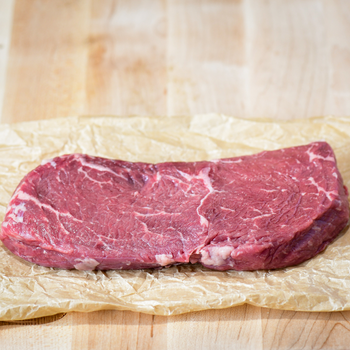
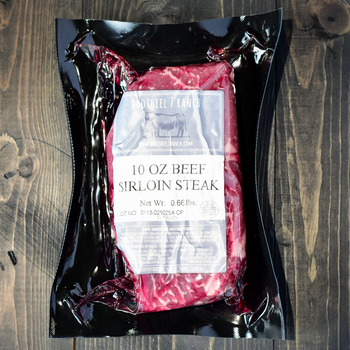
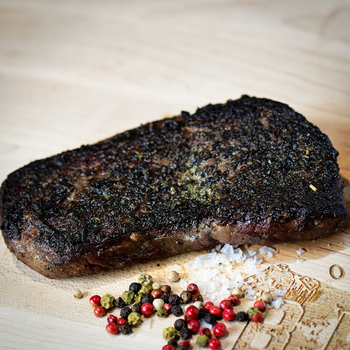
Flavorful, juicy, and versatile enough for weeknight meals and special occasions. A family favorite as a steak, cut into kabobs, or used in stir fry.
Approx .6 - .7lbs
I ordered ground beef and two sirloins. We LOVE it. The quality and freshness was great and the flavor was even better! So happy and we will definitely be ordering again! Thank you guys!
Jenacie, thank you so much for your business and positive review! Nothing makes us happier than hearing how much our customers enjoy our beef. Look forward to serving you again in the future! - Team B7R
These steaks are ideal cuts-perfect size for even an amateur cook/griller. Seriously, with ideal fat ratio and marbling, these cook up like your favorite steakhouse. Simple salt and pepper is all that’s needed here, the flavor of this bovine is divine! 🥩


Our B7R Fajita Meat is a flavorful and tender cut pre-sliced into fajita-ready strips. All you have to do is throw it in your pan or wok and add your favorite veggies for an easy, delicious weeknight dinner!
1lb package
The fajita meat is the best and easiest to prepare. Great flavor and very tender, love it.
This is our first time order from Bootheel7 Ranch and we were not disappointed. We used this order for stir fry and the texture and taste were terrific. We are now a permanent customer!
This comes in thin strips which I cut down into 1inch pieces for beef stroganoff. Love the convenience and the beef is tasty and tender.
This is one of my faves! The meat is consistently good and soft!
This is the best for a quick, easy dinner! I let it sit for an hour with lime juice, cumin, chili powder, salt/pepper and throw it in a cast iron. Makes the best steak tacos!
Caitlin - thanks for your sharing your culinary secrets! We'll have to give this one a try. Enjoy your fajitas and thanks for shopping B7R!



Our ground beef is a perfect blend that balancesdistinguished taste and texture. Made from 21-day dry-aged beef cuts including arm roast, mock tender, short rib, round steak, and sirloin, it's theflavorful, lean protein you can feel good about feeding your family. 1lb packages arrive flash-frozen and individually vacuum-sealed to maintain the highest quality standards.
Just can't. Been buying ground beef from B7R for the past 6 years and the overall quality is extremely noticeable. Even the smell is so different when compared to store bought ground beef. Taste is amazing.
I make sure I am always stocked up . Thanks B7R!
Our freezer always has Bootheel 7 ground beef! We have been ordering beef from Bootheel for several years and we will never go back to store beef.
Love this ground beef. It contains just the right amount of fat to be tasty, but not greasy. It is flavorful and healthier. Definitely worth a try!
Couldn't be happier with all my purchases. Always my go to for beef. Tastes amazing.
Before I started ordering from B7R, I just bought ground beef in the store. Once I tried this ground beef, I never looked back. The taste is unbeatable. We've become so spoiled and definitely taste the difference when we eat other ground beef. I order extra now so we never run out before our next delivery.



A beautiful roast and excellent choice for slow cooking pot roast, shredded beef enchiladas, corned beef and more. The options are endless with this versatile cut!
Approx. 3lbs
This was a tender and juicy roast, easy to make in the crock pot. Out of town company loved it. Bootheel7 never fails to please and has an extremely efficient delivery setup, even if not within the state.
This is the best roast we've had since moving off the farm and eating only the meat raised on the farm. This is our "treat" meal. Comfort food at its finest!
Comparing the bottom round I have occasionally bought at Costco and a few local organic grocery stores, the Bootheel 7 roast was extremely tender and flavorful. What a difference!! I marinated it in the refrigerator overnight with juice of 1 each lime and tangerine and some garlic and herbs. Slow cooked it for 4 hours next day. Very tender and juicy. Probably could have cooked it for a shorter time. Maybe could have had it rare/med rare. Will try next time.
Sharon - We love to hear from happy customers...especially when you share your culinary tips! We'll have to give that marinade a try. Thank you for your business, we look forward to sharing our 21-day dry-aged Black Angus goodness with you again in the future. - Team B7R
This rump roast is perfect and easy for a Sunday dinner. Just put in the crockpot and the roast is tender and delicious!
This is a flavorful cut that works great for roast beef. I season it, then sear in a hot cast iron pan. Then place on a rack in my Instapot with about 1/2 cup of beef broth and cook on high pressure for about 12 min (a 3lb roast) for Med. Rare. Then let it remain in the pot at the Keep Warm setting for 45 min. Remove and use liquid in pot to make a gravy or for AuJus. Slice thinly to serve



We love chuck! When prepared slow n' low, this versatile cut can be used for everything from pot roasts to shredded beef enchiladas. Set on low in the slow cooker for 9+ hours and come home to the best dinner (and wonderful smelling home!) waiting for you.
Approx 3lb per roast
First time cooking a chuck roast. It was excellent. Seared both sides (after salt and pepper) then braised in a Dutch oven with a 28oz can of crushed tomatoes, 16oz bone broth, and sautéed garlic, onions, carrots, and celery (spice to taste). Braised at 350 for about an hour per pound (mine was 3.37 lbs). Took some of the braising liquid (skimmed the fat off), puréed with a hand blender, then reduced that liquid in a frying pan after adding some red wine (maybe 1/2 cup). That sauce thickened up and was an awesome gravy on top of mashed potatoes and tender BR7 chuck! Will order again!
One of my favorites! Taste and texture is always perfect. You will notice the quality and then can never go back!
I love using this cut for meals! Such great flavor and excellent quality.
Tender, fatty, goodness!
This chuck roast is the best ever for barbacoa. The flavors really shone through and the entire family loved it in tacos and burritos. Yummy!!
Hey Wendy! Thanks for the 5* review! We're honored to feed your family and that you all enjoyed barbacoa chuck roast! We appreciate your continued business! - Team B7R




Bavette steak comes from the bottom sirloin, close to where a flank steak comes from. When cooked and sliced properly, it’s one incredibly tender and delicious cut that doesn't get nearly the recognition it deserves! With only one per animal, this cut is a welcome treat marinated and thrown on the grill or skillet.
2.5-3lbs per package
I used this to make pot roast. Waaay better than using chuck. A new favorite cut for me.
Hey Deb! Bavette is an exceptional cut that many folks haven't heard of! Thanks for giving it a shot and letting us know how it turned out. We appreciate your support of our family business. - Team B7R
I decided to try this cut I had never heard of because it seemed like a good value. We like our steaks lean and tender and this is a perfect fit! Feed the whole family or have extra for steak salads and sandwiches later.
Delicious and easy to cook on the grill! Very flavorful and made for great steak sandwiches with the leftovers
I was hesitant as I had never heard of this cut before. I put a dry rub on it and cooked it low and slow and it was fall apart tender and full of flavor.
Marinated with a chimichurri sauce. Then drizzled over. Crowd favorite.



The Petite Tender or Terres Major, aka "Bistro Filet" is a small, lean cut from the chuck primal of the cow. It's a relatively rare steak to find in stores because it takes a butcher more time and skill to cut. Juicy and tender, it's second only to the tenderloin but is more affordable. Perfect to grill or broil.
(.5-1lb)
These are unique and great for a dinner for two. I cook on the grill, let it rest, and slice into medallions. We’ve never had this cut before B7R and now we order it all the time!
OK, these tenders don't have any fat...very little actually. Well seasoned and diced up, they make GREAT kabobs. I cube them up, season them with sea salt, garlic salt and black pepper and then combine them on skewers with red peppers, bacon (wink), and red onions. And then...off to the grill. Ahh-mazing. The meat stays tender and doesn't dry up. Great over a bed of rice or rissotto!
I grilled our first petite tender tonight and it was awesome! A perfect size to make a meal for my wife and me. Thanks for another great cut of beef.
Perfect for when my husband and I want to splurge; just big enough for the two of us. Delicious!
We love all your products especially when you have items on sale! Best meat a person can buy!
Howdy Mike - we're so glad to hear you're enjoying B7R products. Be sure to shop the end-of-summer steak sale, now through Labor Day. It's a great chance to stock your steak inventory for winter - save up to 29% on our bestselling steaks.
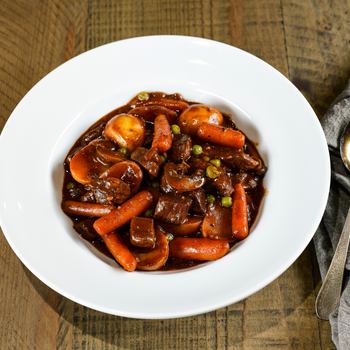
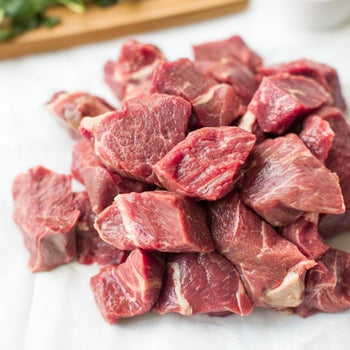
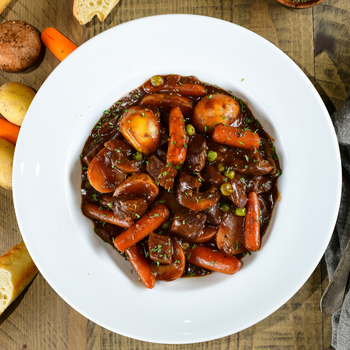
From simple minestrone to classic beef bourguignon, our stew meat is a flavorful and affordable cut that can liven up your weeknight dinner rotation! Throw it in the slow cooker or marinate and throw on the grill for a perfect and easy dinner!
Approx. 1lb per package
This Stew meat is so tender and has so much flavor. This is a go to in every order we place!
I use the stew meat for making a tasty stir fry! Always easy and quick to cook for a perfect medium rare and the meat is tender and tasty! They also work great to marinade and throw on a skewer as a kabob!
We absolutely Love this stew meat. It’s so lean and flavorful- Thanks Bootheel for all of your fresh & delicious options!
All the Bootheel7 beef we have tried is amazing! The Bootheel7 beef stew meat make a pot of stew something special!
Hi Cindy - Thanks for your review! Good news, stew and roast season is right around the corner with *hopefully* some cooler temperatures. We look forward to serving you again in the future! - Team B7R
We use these for stews in winter, kabobs on the grill in summer, and stroganoff anytime. Tender, juicy, delicious.
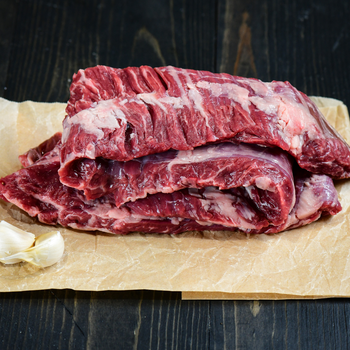
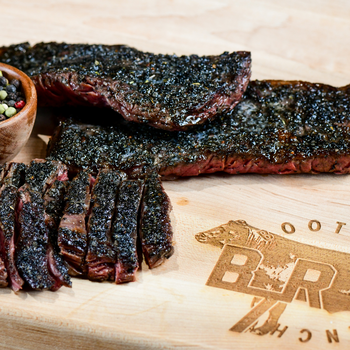
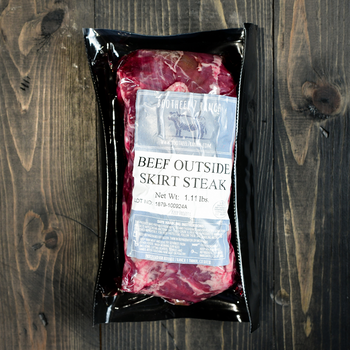
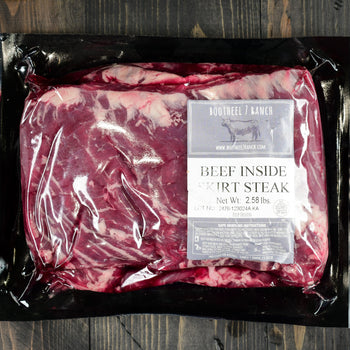
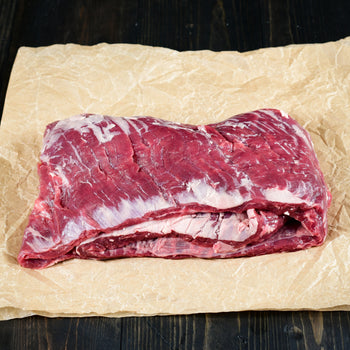
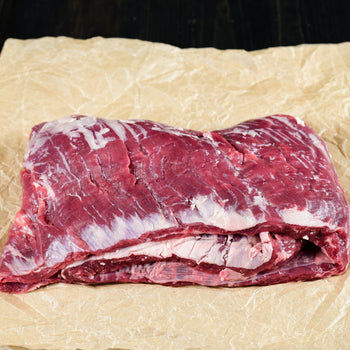
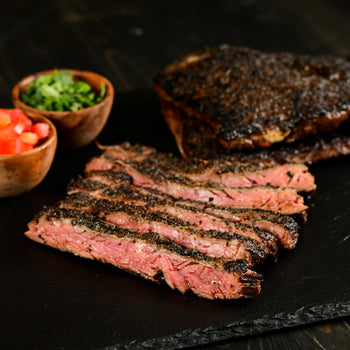
Skirt steak is packed with flavor and ready for your recipes! This unique steak cut grills quickly and cuts beautifully for fajitas, tacos, steak salads, stir-fry and more. A B7R family favorite for sure! Whenever we want to feed a crowd, there's nothing better than marinated skirt steak (find our favorite marinade recipe here) grilled and sliced against the grain to perfection.
Pictured: Outside skirt steak
I recently added skirt steaks to my orders and I'm so glad I did. They are consistently so tender and flavorful and a very versatile cut. My family loves it when we grill them. Its hard to pick a favorite with all the options at B7R but these are definitely in the running!
Love this cut. It is usually enough for 2-3 meals for the two of us. I am blown away every time I make it by how tasty it is. Best I’ve ever tasted.
This is a great cut and the flavor always amazes us! We have ordered many times and it never fails. Our family will continue to purchase from Bootheel 7 for years to come.
We've been customers of Bootheel 7 for years and we're never disappointed. We love their skirt steaks for asada marinated tacos, or just to season, grill, and eat off the cutting board. The meat is the highest quality we've experienced and is priced right (especially if you catch their sales.) We're always excited to host friends and family for a nice Bootheel meal. Note that the pictures are briskets and tri-tip but shows the quality!
Seriously. Steak is perfectly marbled for grilling. Season it accordingly, dice it up and server for fajitas. Amazing. Bootheel 7 has been my go-to beef source for over 4 years. Love'em! BUY LOCAL!
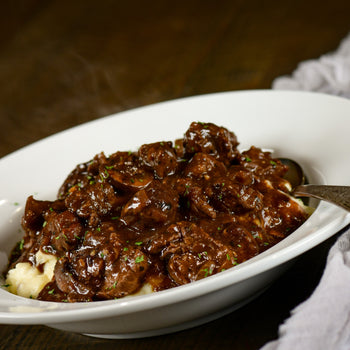
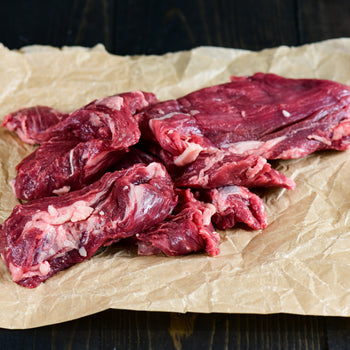
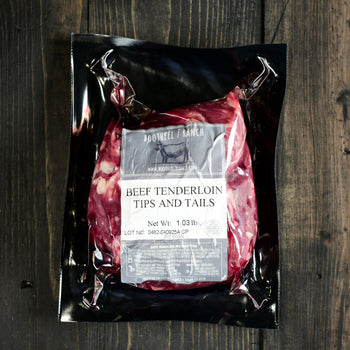
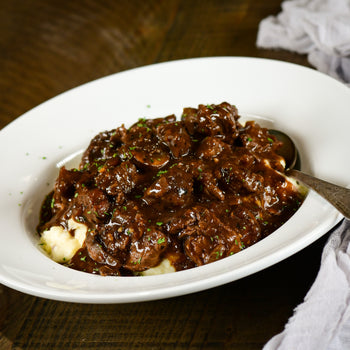
This cut comes from the Loin primal and the Tenderloin subprimal. Tips and Tails are the beautifully trimmed, extremely tender and flavorful ends of the Tenderloin Steak. This cut can be grilled, pan seared or braised.
Perfect for kabobs, stews, and stir-fry!
Approx 1lb per package
Larger pieces than expected but you must adapt. Trim and prepare. Were excellent for a chili. Kid you not.
Anyways, many, many recipes out there to check out and try out. Enjoy!
Outstanding! Really enjoyed the flavor and tenderness.
Duane, great to hear you are enjoying this new product. Thanks for your positive review!
Burger and brisket are my main buys, always good to stock up for winter! That is not to slight the steaks, ribeyes are top notch.
Glenn, we're happy to hear you are enjoying our burgers, brisket and ribeyes! Thanks for shopping B7R.
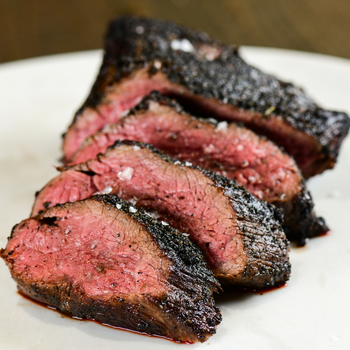
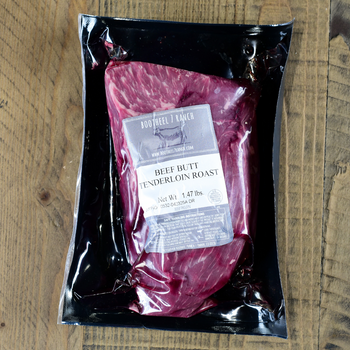
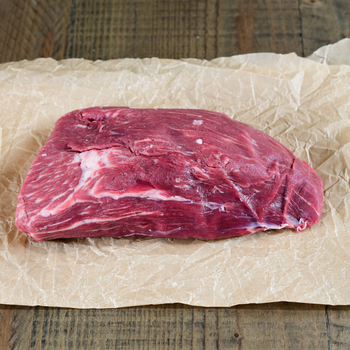
We wanted to keep these all for ourselves (they are THAT good!) but we decided to share. These are a show stopper and turn out perfect every single time!
1.5 - 2lbs each
Although we love a lot of your cuts, this one tops all. So tender and juicy.
The BEST roast available. Insanely good quality meat. Turkey day....LOL...yeah, no...roast day and go carnivore!
We may be biased, but we're a 'Beef on Turkey Day' family, too! Thanks for the review, Jeremi. - Team B7R
Quite simply the best steaks out there. I divide them up and my wife and I get three meals with one roast. The taste is exceptional and better than any fancy steakhouse!!! 5 stars
Incredible cut of beef! Amazingly tender but still flavorful.
We always look forward to when these are available. I like to grill them.
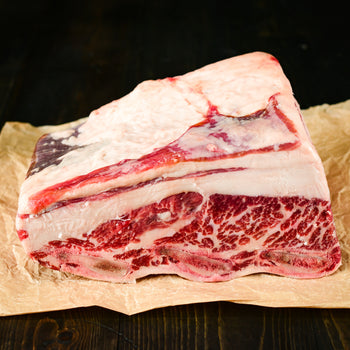
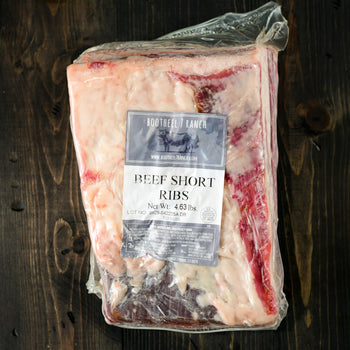
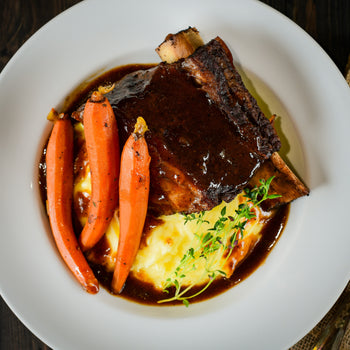
Our beef short ribs are meaty beyond belief! Short ribs need to be braised and/or cooked low and slow but are worth the effort and are always a crowd favorite!
2-3 ribs per package (Approximately 3lbs.)
We ordered two slabs of these amazing ribs and they by far were the most meaty tender ribs we have had i will definitely order again
These were absolutely great! They were so tender and lots of meat. I want to order more!
Mouth watering. Great texture and lots of healthy fat! Taste was amazing.
We are so happy to hear you were pleased with your order, Holly! Thank you very much for your review. - Team B7R
They were tender and delicious. The meal was enjoyed by the whole family. My personal preference however would be that they were half as large.





The baseball cut gets its name from its rounded shape. Cut from the center of the top sirloin, this cut is thick, lean, and flavorful - similar to filet mignon but at smaller price!
2 steaks per package, approx. 1lb per package
Love the size and flavor. A nice lean piece of meat that packs a ton of flavor. I like how they are packaged.
A very tasty piece of steak. Very much resembles a filet!
I just grilled these baseball sirloin steaks to use in my wife’s great beef stroganoff. The sirloin was fantastic like everything else we’ve enjoyed from Bootheel 7 Ranch. They were lean with great flavor. So good, I had to leave a review.
Wayne - We're so happy to hear you're enjoying our products. Thanks for your positive reviews and continued support of our family business. - Team B7R
We’ve been ordering from Bootheel 7 Ranch for a few years, but recently tried these steaks! They are consistently tender and delicious! I grew up on a farm and always had “home grown” beef. Thanks Bootheel 7 Ranch for bringing back memories of home!
We have been ordering with Bootheel 7 Ranch for several years. We find their products to be consitantly wonderful, the delivery always goes off without a hitch. We recommend them highly if you want a superior meal experience!

Give the gift of 'Denver's Best Steak' right at home! Ideal for family, friends, business associates, home chefs, and your hard-to-shop for loved ones!
Purchase a gift card and it will be instantly emailed to you (purchaser). Forward the email to your gift recipient, or print gift card out at home. **Please note - if you would like to include a personal message, please do so when emailing/forwarding to the gift recipient.
Can be used towards any future order, does not expire.
I bought two gift cards as Christmas gifts, gave them out early, their response was pure excitement, I’ve given out steaks as gifts, nothing but love, now they’ll have the pick of the crop.
Thank you Bootheel 7 Ranch, Merry Christmas
Hi Deb, Thank you so much for spreading the word about Bootheel 7 Ranch! Thank you for your 5* review, and for your support of our homegrown family business. Best, Team B7R


Brand new to the B7R Jerky Collection!
The classic, mild beef stick flavor you love with just a hint of smoke! A protein-packed snack made with premium beef cuts and clean ingredients you can feel good about feeding your family. With a little "snap" in each bite, they are the perfect pre/post workout, easy-to-pack lunch, or afternoon snack on the go!
2.65oz, peelable package - 3 sticks per package.
*Please note, second image shows two product packages to display item texture only. Customer will receive one package per quantity ordered.


A perfect mix of sweet and savory, our new Pineapple Teriyaki Beef Sticks are tangy and flavorful with just a hint of pepper! A protein-packed snack made with premium beef cuts and clean ingredients you can feel good about feeding your family. Kid-approved as a delicious, nutrition-packed snack for on the go or in between practices!
3.2oz peelable package - 2 sticks per package.
*Please note, second image shows two product packages to display item texture only. Customer will receive one package per quantity ordered.
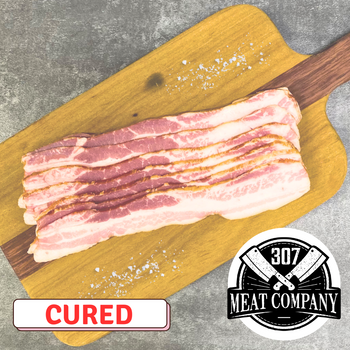
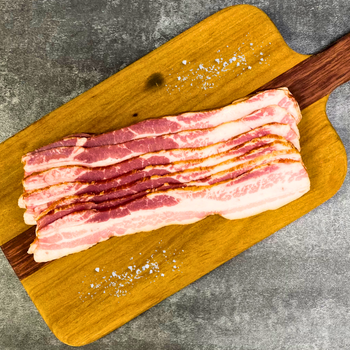
New to the Bootheel 7 Ranch shelves – be the first to try this premium, locally-produced bacon from our partners, 307 Meat Company. As juicy as it is savory, this bacon is ready to be tossed in the skillet and crisped to melt-in-your-mouth perfection.
This bacon is the perfect addition to your breakfast spread, BLTs, soups – and more!
*1LB
*Locally-produced, nitrate-free
*The main difference between cured and uncured meat generally has to do with the aging process and methods used to preserve the product. Cured bacon, for example, may include sea salt and nitrites to seal the product’s flavor and color, while UNCURED bacon (like this product here), cures with naturally-occurring nitrites like celery juice powder.
Although a new addition to the B7R shop, this product is the result of our longstanding partnership with 307 Meat Company. 307 is a full-service craft butcher shop and retail store in Laramie, WY – just about the halfway point between Denver and the pastures of Bootheel 7 Ranch in Lusk, WY. We’re proud to carry 307 pork products and see our 307 partners expand their reach to B7R customers.
I've made my own bacon a lot and this bacon is every bit as good as home made.
Scott - We're so happy to hear you're enjoying the bacon! Thanks for your review and your support of our family business. - Team B7R
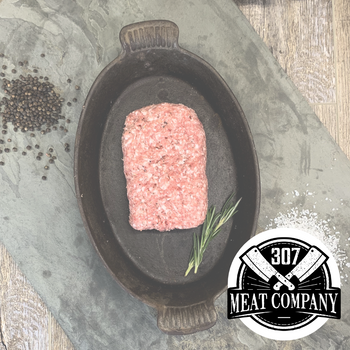
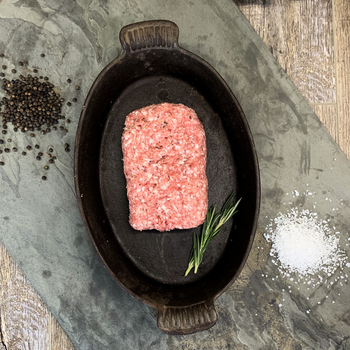
New to B7R shelves, this savory classic is a product from our partners, 307 Meat Company. Just a hint of sage and a whole lot of flavor – fry this up with Sunday brunch or bake it in a casserole or hot dish, and watch the family come running to enjoy this perfect breakfast (or anytime) sausage.
*1LB
*Locally-produced, nitrate-free
*All natural, antibiotic-free, no hormones
Although a new addition to the B7R shop, this product is the result of our longstanding partnership with 307 Meat Company. 307 is a full-service craft butcher shop and retail store in Laramie, WY – just about the halfway point between Denver and the pastures of Bootheel 7 Ranch in Lusk, WY. This premium, locally-produced product is sourced from twenty family-owned farms who promote and practice sustainable agriculture, and devote individualized attention to the animals. We’re proud to carry 307 pork products and see our 307 partners expand their reach to B7R customers.
Bootheel's beef and other products are amazing and very reasonably priced.
The pork sausage taste delicious! Best we've ever had.
A little on the expensive side though.
No onions or garlic! And I find the bulk more useful than the large 1/4 lb patties
My gold standard for taste of breakfast sausage is Bob Evans (midwesterners will recognize that), and this sausage meets that standard while far exceeding the quality of the pork and other ingredients. My only concern would be that it has a bit too much fat.
This is A++++. Super tasty. My whole family loved it. Love the minimal ingredients and something we can all feel good about eating. Tasted delicous!


Be the first to try the all-new breakfast sausage patties from our partners, 307 Meat Company. 307’s customer-favorite classic breakfast sausage, now in patty form for your convenience. These patties are a rich, mouth-watering must-have for breakfast sandwiches – not to mention, great for meal prep, tailgates, campfires – you name it!
*1lb Packs
*Locally-produced, nitrate-free
*All natural, antibiotic-free, no hormones
Although a new addition to the B7R shop, this product is the result of our longstanding partnership with 307 Meat Company. 307 is a full-service craft butcher shop and retail store in Laramie, WY – just about the halfway point between Denver and the pastures of Bootheel 7 Ranch in Lusk, WY. This premium, locally-produced product is sourced from twenty family-owned farms who promote and practice sustainable agriculture, and devote individualized attention to the animals. We’re proud to carry 307 pork products and see our 307 partners expand their reach to B7R customers.
This sausage is very tasty and safe for someone with onion and garlic sensitivity. The only thing I didn’t like was that the patties are burger sized. Too big to serve with a normal breakfast unless you’re a linebacker!
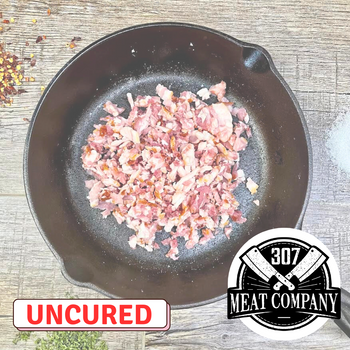
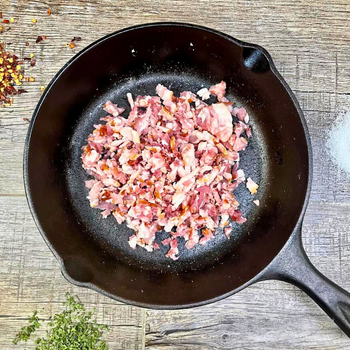
New from our local partners, 307 Meat Company, add this chopped bacon to any salad, chili, baked potatoes or casserole for a flavor-enhancing treat. A bit richer than regular bacon (also available in our shop), chopped bacon – otherwise known as ‘ends and pieces’ – are the tasty morsels that remain after the slicing process. Though smaller – these little flavor bombs pack a hearty punch and will elevate any dish.
*0.5LB
*Locally-produced, nitrate-free
*All natural, antibiotic-free, no hormones
*The main difference between cured and uncured meat generally has to do with the aging process and methods used to preserve the product. Cured bacon, for example, may include sea salt and nitrites to seal the product’s flavor and color, while UNCURED bacon (like this product here), cures with naturally-occurring nitrites like celery juice powder.
Although a new addition to the B7R shop, this product is the result of our longstanding partnership with 307 Meat Company. 307 is a full-service craft butcher shop and retail store in Laramie, WY – just about the halfway point between Denver and the pastures of Bootheel 7 Ranch in Lusk, WY. This premium, locally-produced product is sourced from twenty family-owned farms who promote and practice sustainable agriculture, and devote individualized attention to the animals. We’re proud to carry 307 pork products and see our 307 partners expand their reach to B7R customers.
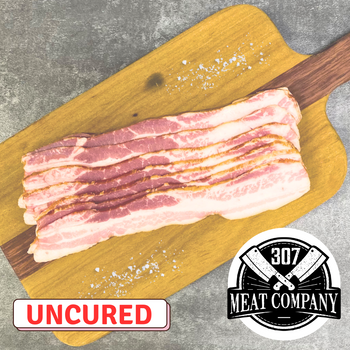
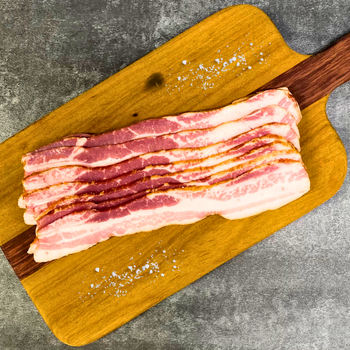
Succulent, uncured bacon from 307 Meat Company has hit the B7R shelves! Be the first to try this premium, locally-produced bacon sourced from twenty family-owned farms. Juicy and skillet-ready, this uncured bacon will level-up any meal.
This bacon is the perfect addition to your breakfast spread, sandwiches – and more!
*1LB
*Locally-produced, nitrate-free
*All natural, antibiotic-free, no hormones
*The main difference between cured and uncured meat generally has to do with the aging process and methods used to preserve the product. Cured bacon, for example, may include sea salt and nitrites to seal the product’s flavor and color, while UNCURED bacon (like this product here), cures with naturally-occurring nitrites like celery juice powder.
Although a new addition to the B7R shop, this product is the result of our longstanding partnership with 307 Meat Company. 307 is a full-service craft butcher shop and retail store in Laramie, WY – just about the halfway point between Denver and the pastures of Bootheel 7 Ranch in Lusk, WY. We’re proud to carry 307 pork products and see our 307 partners expand their reach to B7R customers.
Yummy!
This bacon shrinks a lot when cooked, some shrinkage is normal but this seems a bit higher than expected.
This is the best bacon I've ever bought! Great value for the cost. Worth every penny.



1lb Ground Beef: Buy 5, Save $5
Save $5.00 when you buy this bundle of (5) 1lb-packages of our 90/10 Ground Beef.
Our ground beef is a perfect blend that balances distinguished taste and texture. Made from 21-day dry-aged beef cuts including arm roast, mock tender, short rib, round steak, and sirloin, it's the flavorful, lean protein you can feel good about feeding your family. 1lb packages arrive flash-frozen and individually vacuum-sealed to maintain the highest quality standards.
Shepard's pie. Chili. Italian carbonara sauce and anything else that has 'ground beef' as an ingredient.
The best there is bar none.
We love the ground beef, it looks and tastes fresh.



1lb Ground Beef: Buy 9, Get 1 FREE
Earn (1) FREE package of our bestselling ground beef when you buy this bundle of (9) 1lb-packages of our 90/10 Ground Beef (10 1lb packages total).
Our ground beef is a perfect blend that balances distinguished taste and texture. Made from 21-day dry-aged beef cuts including arm roast, mock tender, short rib, round steak, and sirloin, it's the flavorful, lean protein you can feel good about feeding your family.
(10) 1lb packages arrive flash-frozen and individually vacuum-sealed to maintain the highest quality standards. Approximately 10lbs of ground beef total.
Seriously cannot buy ground beef at the supermarket anymore.
Love the hamburger from Bootheel Ranch! Once you try it you can't go back to what is in the grocery stores as it just doesn't compare to the quality and you know you are getting a good product.
We love bootheel ranch. Have tried other beef companies, but this one has great delivery and the product is top notch. You won't be disappointed.
This is my family's favorite ground beef! Super flavorful and better than anything I've found in the grocery store. I always have to make sure I have several pounds of this in my freezer!
Their meat is so tasty! We love buying from a quality, local source.



Hamburger Patties: Buy 5, Save $5
Save $5.00 when you buy this bundle of (5) Packages of 4x 6oz-patties.
Enjoy our grill-ready hamburger patties! 80/20 lean, vacuum-sealed, arrives frozen.
1 order of patties includes (4) patties per package, 6oz per patty (1.5lb of beef total). This bulk order includes 20 patties totaling 7.5lbs of burger patties.
Amazing product and service - never disappointing
Love these hamburgers, very juicy and there is hardly any shrinkage. The ground beef is also very good.



Hamburger Patties: Buy 5, Save $5
Earn (1) FREE package of burger patties when you buy this bundle of (9) Packages of 4x 6oz-patties.
Enjoy our grill-ready hamburger patties! 80/20 lean, vacuum-sealed, arrives frozen.
1 order of patties includes (4) patties per package, 6oz per patty (1.5lb of beef total). This bulk order includes 40 patties totaling 15lbs of burger patties.
These burgers are always flavorful and delicious!
Jennifer - We're so happy to hear our burgers are your favorite! Thanks for your kind words and continued support of our family business. - Team B7R
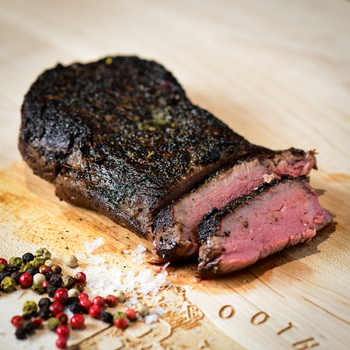
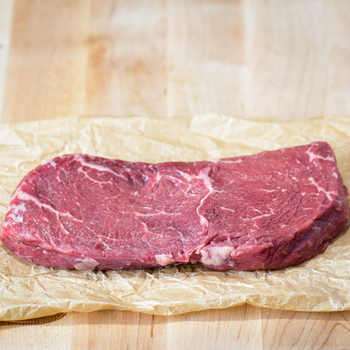
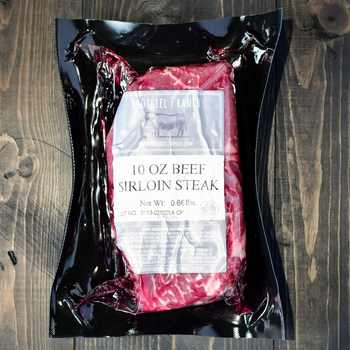
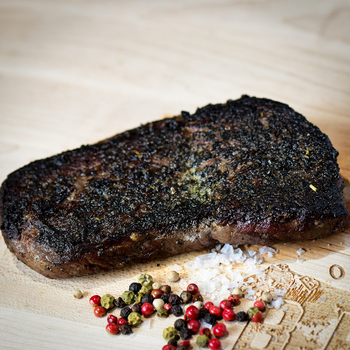
Sirloin Steak, 10oz: Buy 9, get 1 FREE
Earn (1) FREE steak when you buy this bundle of (9) Sirloin steaks (10 steaks total).
Flavorful, juicy, and versatile enough for weeknight meals and special occasions. A family favorite as a steak, cut into kabobs, or used in stir fry.
Approx. .6-.7lb per steak-This bulk order includes approximately 6-7lbs of 10oz sirloins.
These sirloins are delicious, flavorful, tender, and meaty and the perfect protein for a quick grilled dinner. Love the size and cut. The buy 9, get one bundle adds value!
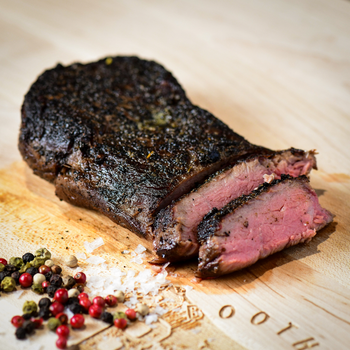
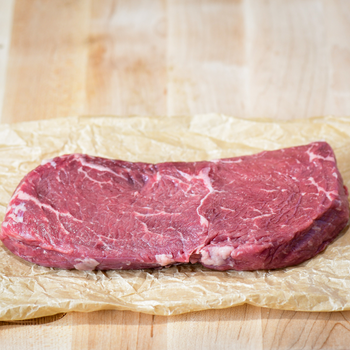
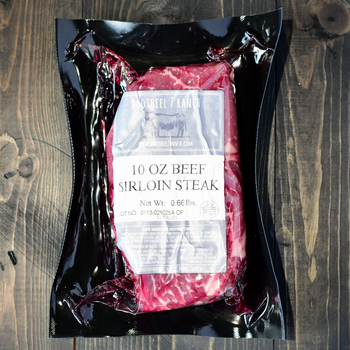
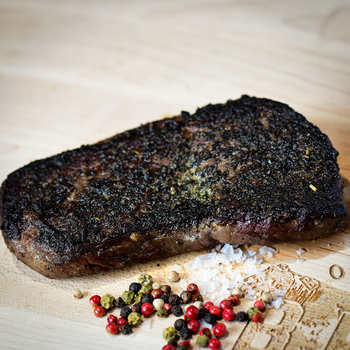
Sirloin Steak, 10oz: Buy 5, Save $5
Save $5.00 when you buy this bundle of (5) Sirloins steaks.
Flavorful, juicy, and versatile enough for weeknight meals and special occasions. A family favorite as a steak, cut into kabobs, or used in stir fry.
Approx. .6-.7lb per steak-This bulk order includes approximately 3-3.5lbs of 10oz sirloins.
Did the streaks on the bbq with some smoke, medium rare turned out perfect and tasted great.
Best!





Baseball-Cut Sirloins: Buy 5, Save $5
Save $5.00 when you buy this bundle of (5) packages of 1lbs-packages of Baseball-Cut Sirloin steaks.
The baseball cut gets its name from its rounded shape. Cut from the center of the top sirloin, this cut is thick, lean, and flavorful - similar to filet mignon but at smaller price!
2 steaks per package, approx. 1lb per package -This bulk order includes approximately 5lbs of baseball-cut sirloins.
ootheel 7 Ranch baseball-cut sirloin steaks are delicious! All the flavor you can imagine in a steak with a tenderness second only to their tenderloin filets.
Season, grill, rest, and sprinkle with your favorite finishing salt! Steakhouse delicious!
Bootheel 7 Ranch baseball-cut sirloin steaks are delicious! All the flavor you can imagine in a steak with a tenderness second only to their tenderloin filets.
Season, grill, rest, and sprinkle with your favorite finishing salt! Steakhouse delicious!


Fajita Meat: Buy 5, Save $5
Save $5.00 when you buy this bundle of (5) 1lb-Packages of Fajita Meat.
Our B7R Fajita Meat is a flavorful and tender cut pre-sliced into fajita-ready strips. All you have to do is throw it in your pan or wok and add your favorite veggies for an easy, delicious weeknight dinner!
1lb packages -This bulk order includes 5lbs of Fajita Meat.
We buy the fajita meat all the time. It’s versatile and is great for prepping multiple meals for the week. Comes together really quick and is delicious.
We have this weekly in our menu rotation. Everyone in the family looks forward to fajita night!
Cheri, thank you so much for your review, and we're thrilled the whole family is enjoying our product. We appreciate your support of our family business. - Team B7R


Fajita Meat: Buy 9, Get 1 FREE
Earn (1) FREE package of fajita meat when you buy this bundle of (9) packages of fajita meat (10 1lb packages total).
Our B7R Fajita Meat is a flavorful and tender cut pre-sliced into fajita-ready strips. All you have to do is throw it in your pan or wok and add your favorite veggies for an easy, delicious weeknight dinner!
1lb packages -This bulk order includes 10lbs of Fajita Meat.



Flat Iron Steak: Buy 5, Save $5
Save $5.00 when you buy this bundle of (5) Flat Iron steaks.
This cut is a hidden gem. Considered the second most tender cut of the cow (only after filet/tenderloin), the flat iron is well marbled and has a robust, meaty flavor like a NY Strip. Popular for grilling and certainly a crowd-pleaser!
Approx. 8oz portion size per steak-This bulk order includes approximately 2.5lbs of 8oz flat irons.





Bone-in Ribeye, 18oz: Buy 9, Get 1 FREE
Earn (1) FREE steak when you buy this bundle of (9) 18oz Bone-in Ribeyes (10 steaks total).
A crowd favorite here at the ranch, these 18oz bone-in ribeyes have incredible marbling and stand out as one of our most tender, juicy cuts. A 21-day, dry-aged B7R ribeye is hard to beat!
Approx. 18oz per steak-This bulk order includes approximately 11.2lbs of Bone-in Ribeyes.





Bone-in Ribeye, 18oz: Buy 5, Save $5
Save $5.00 when you buy this bundle of (5) 18oz Bone-in Ribeyes.
A crowd favorite here at the ranch, these 18oz bone-in ribeyes have incredible marbling and stand out as one of our most tender, juicy cuts. A 21-day, dry-aged B7R ribeye is hard to beat!
Approx. 18oz per steak-This bulk order includes approximately 5.6lbs of Bone-in Ribeyes.



Flat Iron Steak: Buy 9, Get 1 FREE
Earn (1) FREE steak when you buy this bundle of (9) Flat Iron steaks (10 steaks total).
This cut is a hidden gem. Considered the second most tender cut of the cow (only after filet/tenderloin), the flat iron is well marbled and has a robust, meaty flavor like a NY Strip. Popular for grilling and certainly a crowd-pleaser!
Approx. 8oz portion size per steak-This bulk order includes approximately 5lbs of 8oz flat irons.




Boneless Ribeye, 12oz: Buy 5, Save $5
Save $5.00 when you buy this bundle of (5) 12oz Boneless Ribeyes.
A crowd favorite here at the ranch, these 12oz boneless ribeyes have incredible marbling and stand out as one of our most tender, juicy cuts. A 21-day, dry-aged B7R ribeye is hard to beat!
Approx. 12oz per steak-This bulk order includes approximately 3.75lbs of Boneless Ribeyes.
Ribeyes are perfect! Grilled them up and they are some of the best ribeyes!!
Top notch!




Boneless Ribeye, 12oz: Buy 9, Get 1 FREE
Earn (1) FREE steak when you buy this bundle of (9) 12oz Boneless Ribeyes (10 steaks total).
A crowd favorite here at the ranch, these 12oz boneless ribeyes have incredible marbling and stand out as one of our most tender, juicy cuts. A 21-day, dry-aged B7R ribeye is hard to beat!
Approx. 12oz per steak-This bulk order includes approximately 7.5lbs of Boneless Ribeyes.
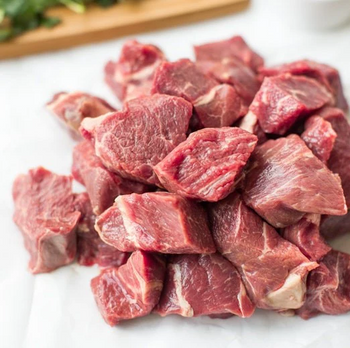


Stew/Kabob Meat: Buy 9, Get 1 FREE
Earn (1) FREE package of stew/kabob meat when you buy this bundle of (9) packages of Stew/Kabob meat (10 1lb packages total).
From simple minestrone to classic beef bourguignon, our stew meat is a flavorful and affordable cut that can liven up your weeknight dinner rotation! Throw it in the slow cooker or marinate and throw on the grill for a perfect and easy dinner!
Approx. 1lb per package -This bulk order includes 10lbs of Stew Meat.



Stew/Kabob meat: Buy 5, Save $5
Save $5.00 when you buy this bundle of (5) 1lb-Packages of Stew Meat.
From simple minestrone to classic beef bourguignon, our stew meat is a flavorful and affordable cut that can liven up your weeknight dinner rotation! Throw it in the slow cooker or marinate and throw on the grill for a perfect and easy dinner!
Approx. 1lb per package -This bulk order includes 5lbs of Stew Meat.



1lb Ground Beef: Buy 5, Save $5
Save $5.00 when you buy this bundle of (5) 1lb-packages of our 90/10 Ground Beef.
Our ground beef is a perfect blend that balances distinguished taste and texture. Made from 21-day dry-aged beef cuts including arm roast, mock tender, short rib, round steak, and sirloin, it's the flavorful, lean protein you can feel good about feeding your family. 1lb packages arrive flash-frozen and individually vacuum-sealed to maintain the highest quality standards.
Shepard's pie. Chili. Italian carbonara sauce and anything else that has 'ground beef' as an ingredient.
The best there is bar none.
We love the ground beef, it looks and tastes fresh.



1lb Ground Beef: Buy 9, Get 1 FREE
Earn (1) FREE package of our bestselling ground beef when you buy this bundle of (9) 1lb-packages of our 90/10 Ground Beef (10 1lb packages total).
Our ground beef is a perfect blend that balances distinguished taste and texture. Made from 21-day dry-aged beef cuts including arm roast, mock tender, short rib, round steak, and sirloin, it's the flavorful, lean protein you can feel good about feeding your family.
(10) 1lb packages arrive flash-frozen and individually vacuum-sealed to maintain the highest quality standards. Approximately 10lbs of ground beef total.
Seriously cannot buy ground beef at the supermarket anymore.
Love the hamburger from Bootheel Ranch! Once you try it you can't go back to what is in the grocery stores as it just doesn't compare to the quality and you know you are getting a good product.
We love bootheel ranch. Have tried other beef companies, but this one has great delivery and the product is top notch. You won't be disappointed.
This is my family's favorite ground beef! Super flavorful and better than anything I've found in the grocery store. I always have to make sure I have several pounds of this in my freezer!
Their meat is so tasty! We love buying from a quality, local source.


Fajita Meat: Buy 5, Save $5
Save $5.00 when you buy this bundle of (5) 1lb-Packages of Fajita Meat.
Our B7R Fajita Meat is a flavorful and tender cut pre-sliced into fajita-ready strips. All you have to do is throw it in your pan or wok and add your favorite veggies for an easy, delicious weeknight dinner!
1lb packages -This bulk order includes 5lbs of Fajita Meat.
We buy the fajita meat all the time. It’s versatile and is great for prepping multiple meals for the week. Comes together really quick and is delicious.
We have this weekly in our menu rotation. Everyone in the family looks forward to fajita night!
Cheri, thank you so much for your review, and we're thrilled the whole family is enjoying our product. We appreciate your support of our family business. - Team B7R


Fajita Meat: Buy 9, Get 1 FREE
Earn (1) FREE package of fajita meat when you buy this bundle of (9) packages of fajita meat (10 1lb packages total).
Our B7R Fajita Meat is a flavorful and tender cut pre-sliced into fajita-ready strips. All you have to do is throw it in your pan or wok and add your favorite veggies for an easy, delicious weeknight dinner!
1lb packages -This bulk order includes 10lbs of Fajita Meat.





Baseball-Cut Sirloins: Buy 5, Save $5
Save $5.00 when you buy this bundle of (5) packages of 1lbs-packages of Baseball-Cut Sirloin steaks.
The baseball cut gets its name from its rounded shape. Cut from the center of the top sirloin, this cut is thick, lean, and flavorful - similar to filet mignon but at smaller price!
2 steaks per package, approx. 1lb per package -This bulk order includes approximately 5lbs of baseball-cut sirloins.
ootheel 7 Ranch baseball-cut sirloin steaks are delicious! All the flavor you can imagine in a steak with a tenderness second only to their tenderloin filets.
Season, grill, rest, and sprinkle with your favorite finishing salt! Steakhouse delicious!
Bootheel 7 Ranch baseball-cut sirloin steaks are delicious! All the flavor you can imagine in a steak with a tenderness second only to their tenderloin filets.
Season, grill, rest, and sprinkle with your favorite finishing salt! Steakhouse delicious!
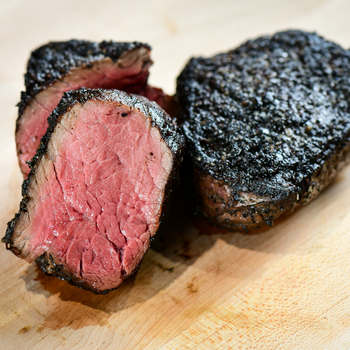
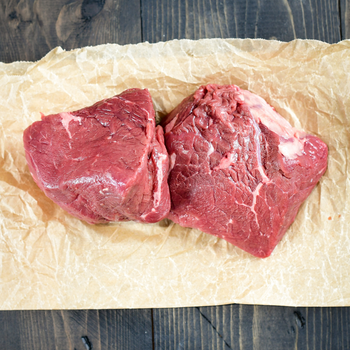
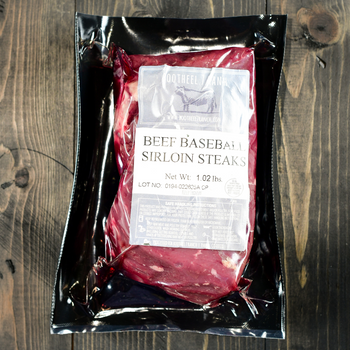
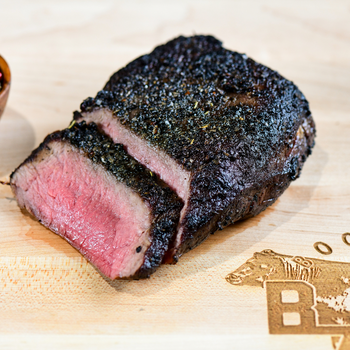
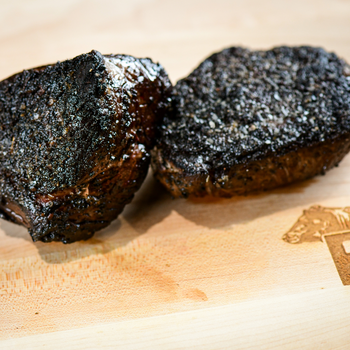
Baseball-Cut Sirloins: Buy 9, get 1 FREE
Earn (1) FREE steak when you buy this bundle of (9) Baseball Cut Sirloin steaks (10 packages of 2 steaks each, 20 steaks total).
The baseball cut gets its name from its rounded shape. Cut from the center of the top sirloin, this cut is thick, lean, and flavorful - similar to filet mignon but at smaller price!
2 steaks per package, approx. 1lb per package -This bulk order includes approximately 10lbs of baseball-cut sirloins.




Boneless Ribeye, 12oz: Buy 5, Save $5
Save $5.00 when you buy this bundle of (5) 12oz Boneless Ribeyes.
A crowd favorite here at the ranch, these 12oz boneless ribeyes have incredible marbling and stand out as one of our most tender, juicy cuts. A 21-day, dry-aged B7R ribeye is hard to beat!
Approx. 12oz per steak-This bulk order includes approximately 3.75lbs of Boneless Ribeyes.
Ribeyes are perfect! Grilled them up and they are some of the best ribeyes!!
Top notch!




Boneless Ribeye, 12oz: Buy 9, Get 1 FREE
Earn (1) FREE steak when you buy this bundle of (9) 12oz Boneless Ribeyes (10 steaks total).
A crowd favorite here at the ranch, these 12oz boneless ribeyes have incredible marbling and stand out as one of our most tender, juicy cuts. A 21-day, dry-aged B7R ribeye is hard to beat!
Approx. 12oz per steak-This bulk order includes approximately 7.5lbs of Boneless Ribeyes.





Bone-in Ribeye, 18oz: Buy 5, Save $5
Save $5.00 when you buy this bundle of (5) 18oz Bone-in Ribeyes.
A crowd favorite here at the ranch, these 18oz bone-in ribeyes have incredible marbling and stand out as one of our most tender, juicy cuts. A 21-day, dry-aged B7R ribeye is hard to beat!
Approx. 18oz per steak-This bulk order includes approximately 5.6lbs of Bone-in Ribeyes.





Bone-in Ribeye, 18oz: Buy 9, Get 1 FREE
Earn (1) FREE steak when you buy this bundle of (9) 18oz Bone-in Ribeyes (10 steaks total).
A crowd favorite here at the ranch, these 18oz bone-in ribeyes have incredible marbling and stand out as one of our most tender, juicy cuts. A 21-day, dry-aged B7R ribeye is hard to beat!
Approx. 18oz per steak-This bulk order includes approximately 11.2lbs of Bone-in Ribeyes.
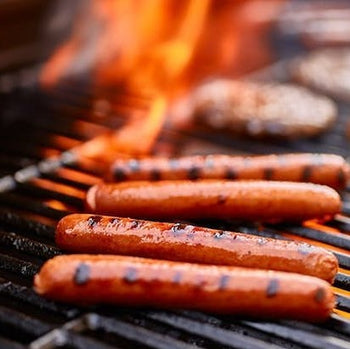
All Beef Hot Dogs: Buy 5, Save $5
Save $5.00 when you buy this bundle of (5) packages of 10oz All Beef Hot Dogs.
Let's be honest, who doesn't love a great hot dog? Especially when they are made only with 100% B7R beef and spices. Zero fillers, junk, or nitrates. Fully-cooked and definitely kid-approved!
Approx. 8oz packs, 4 Hot Dogs per pack
Best hot dogs!!!!
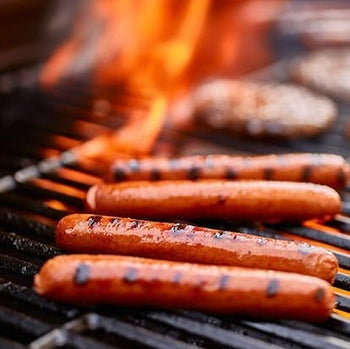
All Beef Hot Dogs: Buy 9, Get 1 FREE
Earn (1) FREE package of dogs when you buy this bundle of (9) All Beef Hot Dogs (10 packages, 50 dogs total).
Let's be honest, who doesn't love a great hot dog? Especially when they are made only with 100% B7R beef and spices. Zero fillers, junk, or nitrates. Fully-cooked and definitely kid-approved!
Approx. 8oz package, 4 Hot Dogs per pack



Stew/Kabob meat: Buy 5, Save $5
Save $5.00 when you buy this bundle of (5) 1lb-Packages of Stew Meat.
From simple minestrone to classic beef bourguignon, our stew meat is a flavorful and affordable cut that can liven up your weeknight dinner rotation! Throw it in the slow cooker or marinate and throw on the grill for a perfect and easy dinner!
Approx. 1lb per package -This bulk order includes 5lbs of Stew Meat.



Stew/Kabob Meat: Buy 9, Get 1 FREE
Earn (1) FREE package of stew/kabob meat when you buy this bundle of (9) packages of Stew/Kabob meat (10 1lb packages total).
From simple minestrone to classic beef bourguignon, our stew meat is a flavorful and affordable cut that can liven up your weeknight dinner rotation! Throw it in the slow cooker or marinate and throw on the grill for a perfect and easy dinner!
Approx. 1lb per package -This bulk order includes 10lbs of Stew Meat.



Flat Iron Steak: Buy 5, Save $5
Save $5.00 when you buy this bundle of (5) Flat Iron steaks.
This cut is a hidden gem. Considered the second most tender cut of the cow (only after filet/tenderloin), the flat iron is well marbled and has a robust, meaty flavor like a NY Strip. Popular for grilling and certainly a crowd-pleaser!
Approx. 8oz portion size per steak-This bulk order includes approximately 2.5lbs of 8oz flat irons.



Flat Iron Steak: Buy 9, Get 1 FREE
Earn (1) FREE steak when you buy this bundle of (9) Flat Iron steaks (10 steaks total).
This cut is a hidden gem. Considered the second most tender cut of the cow (only after filet/tenderloin), the flat iron is well marbled and has a robust, meaty flavor like a NY Strip. Popular for grilling and certainly a crowd-pleaser!
Approx. 8oz portion size per steak-This bulk order includes approximately 5lbs of 8oz flat irons.



Hamburger Patties: Buy 5, Save $5
Save $5.00 when you buy this bundle of (5) Packages of 4x 6oz-patties.
Enjoy our grill-ready hamburger patties! 80/20 lean, vacuum-sealed, arrives frozen.
1 order of patties includes (4) patties per package, 6oz per patty (1.5lb of beef total). This bulk order includes 20 patties totaling 7.5lbs of burger patties.
Amazing product and service - never disappointing
Love these hamburgers, very juicy and there is hardly any shrinkage. The ground beef is also very good.



Hamburger Patties: Buy 5, Save $5
Earn (1) FREE package of burger patties when you buy this bundle of (9) Packages of 4x 6oz-patties.
Enjoy our grill-ready hamburger patties! 80/20 lean, vacuum-sealed, arrives frozen.
1 order of patties includes (4) patties per package, 6oz per patty (1.5lb of beef total). This bulk order includes 40 patties totaling 15lbs of burger patties.
These burgers are always flavorful and delicious!
Jennifer - We're so happy to hear our burgers are your favorite! Thanks for your kind words and continued support of our family business. - Team B7R




Sirloin Steak, 10oz: Buy 5, Save $5
Save $5.00 when you buy this bundle of (5) Sirloins steaks.
Flavorful, juicy, and versatile enough for weeknight meals and special occasions. A family favorite as a steak, cut into kabobs, or used in stir fry.
Approx. .6-.7lb per steak-This bulk order includes approximately 3-3.5lbs of 10oz sirloins.
Did the streaks on the bbq with some smoke, medium rare turned out perfect and tasted great.
Best!




Sirloin Steak, 10oz: Buy 9, get 1 FREE
Earn (1) FREE steak when you buy this bundle of (9) Sirloin steaks (10 steaks total).
Flavorful, juicy, and versatile enough for weeknight meals and special occasions. A family favorite as a steak, cut into kabobs, or used in stir fry.
Approx. .6-.7lb per steak-This bulk order includes approximately 6-7lbs of 10oz sirloins.
These sirloins are delicious, flavorful, tender, and meaty and the perfect protein for a quick grilled dinner. Love the size and cut. The buy 9, get one bundle adds value!
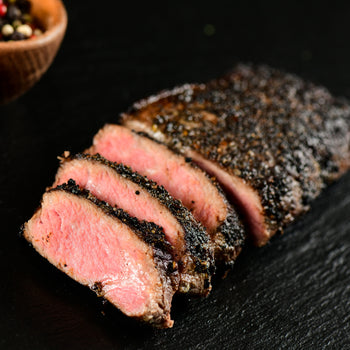
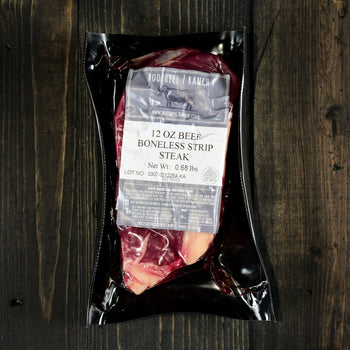
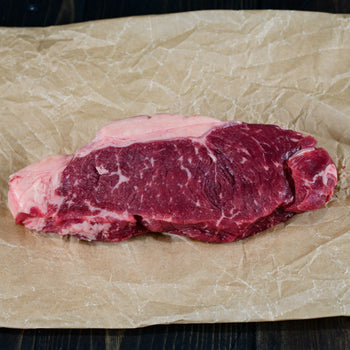
NY Strip: Buy 5, Save $5
Save $5.00 when you buy this bundle of (5) New York Strip steaks.
Crowned the king of all steaks, our 12oz New York Strip Steaks are cut from the center of the loin. This savory, juicy steak is well marbled and trimmed to perfection. Steak connoisseurs value its rich flavor and consider it a favorite grilling steak!
Approx. 12oz portion size per steak-This bulk order includes approximately 3.75lbs of 12oz NY Strip steaks.
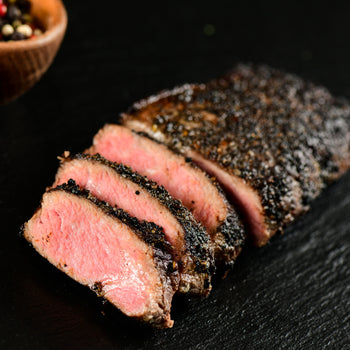


NY Strip Steak: Buy 9, Get 1 FREE
Earn (1) FREE steak when you buy this bundle of (9) NY Strip steaks (10 steaks total).
Crowned the king of all steaks, our 12oz New York Strip Steaks are cut from the center of the loin. This savory, juicy steak is well marbled and trimmed to perfection. Steak connoisseurs value its rich flavor and consider it a favorite grilling steak!
Approx. 12oz portion size per steak -This bulk order includes approximately 7.5lbs of 12oz NY Strip steaks.


New to B7R shelves, this savory classic is a product from our partners, 307 Meat Company. Just a hint of sage and a whole lot of flavor – fry this up with Sunday brunch or bake it in a casserole or hot dish, and watch the family come running to enjoy this perfect breakfast (or anytime) sausage.
*1LB
*Locally-produced, nitrate-free
*All natural, antibiotic-free, no hormones
Although a new addition to the B7R shop, this product is the result of our longstanding partnership with 307 Meat Company. 307 is a full-service craft butcher shop and retail store in Laramie, WY – just about the halfway point between Denver and the pastures of Bootheel 7 Ranch in Lusk, WY. This premium, locally-produced product is sourced from twenty family-owned farms who promote and practice sustainable agriculture, and devote individualized attention to the animals. We’re proud to carry 307 pork products and see our 307 partners expand their reach to B7R customers.
Bootheel's beef and other products are amazing and very reasonably priced.
The pork sausage taste delicious! Best we've ever had.
A little on the expensive side though.
No onions or garlic! And I find the bulk more useful than the large 1/4 lb patties
My gold standard for taste of breakfast sausage is Bob Evans (midwesterners will recognize that), and this sausage meets that standard while far exceeding the quality of the pork and other ingredients. My only concern would be that it has a bit too much fat.
This is A++++. Super tasty. My whole family loved it. Love the minimal ingredients and something we can all feel good about eating. Tasted delicous!


Be the first to try the all-new breakfast sausage patties from our partners, 307 Meat Company. 307’s customer-favorite classic breakfast sausage, now in patty form for your convenience. These patties are a rich, mouth-watering must-have for breakfast sandwiches – not to mention, great for meal prep, tailgates, campfires – you name it!
*1lb Packs
*Locally-produced, nitrate-free
*All natural, antibiotic-free, no hormones
Although a new addition to the B7R shop, this product is the result of our longstanding partnership with 307 Meat Company. 307 is a full-service craft butcher shop and retail store in Laramie, WY – just about the halfway point between Denver and the pastures of Bootheel 7 Ranch in Lusk, WY. This premium, locally-produced product is sourced from twenty family-owned farms who promote and practice sustainable agriculture, and devote individualized attention to the animals. We’re proud to carry 307 pork products and see our 307 partners expand their reach to B7R customers.
This sausage is very tasty and safe for someone with onion and garlic sensitivity. The only thing I didn’t like was that the patties are burger sized. Too big to serve with a normal breakfast unless you’re a linebacker!
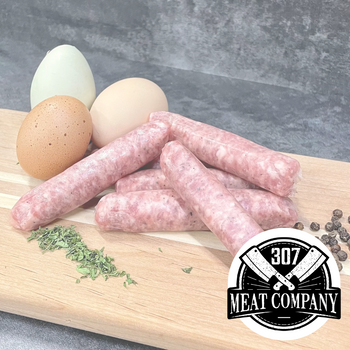
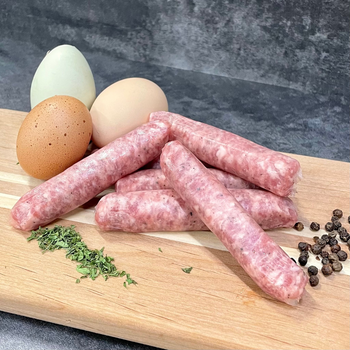
New to the Bootheel 7 Ranch shelves, our partners at 307 Meat Company have delivered ‘the missing LINK’ with these breakfast sausages. Savory and versatile, you can’t go wrong with the classic salt, pepper, and sage flavor.
Try them in ‘pigs in a blanket’, slice ‘em up and toss into an egg casserole, or get creative with ‘pancake corndogs’ – this key ingredient is the hearty protein to pull it all together.
*9oz
*Locally-produced, nitrate-free
*All natural, antibiotic-free, no hormones
Although a new addition to the B7R shop, this product is the result of our longstanding partnership with 307 Meat Company. 307 is a full-service craft butcher shop and retail store in Laramie, WY – just about the halfway point between Denver and the pastures of Bootheel 7 Ranch in Lusk, WY. This premium, locally-produced product is sourced from twenty family-owned farms who promote and practice sustainable agriculture, and devote individualized attention to the animals. We’re proud to carry 307 pork products and see our 307 partners expand their reach to B7R customers.
I don't usually like sausage links but I LOVE these. Simple ingredients but big flavor without the grease.


New to the Bootheel 7 Ranch shelves – be the first to try this premium, locally-produced bacon from our partners, 307 Meat Company. As juicy as it is savory, this bacon is ready to be tossed in the skillet and crisped to melt-in-your-mouth perfection.
This bacon is the perfect addition to your breakfast spread, BLTs, soups – and more!
*1LB
*Locally-produced, nitrate-free
*The main difference between cured and uncured meat generally has to do with the aging process and methods used to preserve the product. Cured bacon, for example, may include sea salt and nitrites to seal the product’s flavor and color, while UNCURED bacon (like this product here), cures with naturally-occurring nitrites like celery juice powder.
Although a new addition to the B7R shop, this product is the result of our longstanding partnership with 307 Meat Company. 307 is a full-service craft butcher shop and retail store in Laramie, WY – just about the halfway point between Denver and the pastures of Bootheel 7 Ranch in Lusk, WY. We’re proud to carry 307 pork products and see our 307 partners expand their reach to B7R customers.
I've made my own bacon a lot and this bacon is every bit as good as home made.
Scott - We're so happy to hear you're enjoying the bacon! Thanks for your review and your support of our family business. - Team B7R


New from our partners, 307 Meat Company, add this chopped bacon to any salad, chili, baked potatoes or casserole for a flavor-enhancing treat. A bit richer than regular bacon (also available in our shop), chopped bacon – otherwise known as ‘ends and pieces’ – are the tasty morsels that remain after the slicing process. Though smaller – these little flavor bombs pack a hearty punch and will elevate any dish.
*0.5LB
*Locally-produced, nitrate-free
*All natural, antibiotic-free, no hormones
*The main difference between cured and uncured meat generally has to do with the aging process and methods used to preserve the product. Cured bacon, for example, may include sea salt and nitrites to seal the product’s flavor and color, while UNCURED bacon (like this product here), cures with naturally-occurring nitrites like celery juice powder.
Although a new addition to the B7R shop, this product is the result of our longstanding partnership with 307 Meat Company. 307 is a full-service craft butcher shop and retail store in Laramie, WY – just about the halfway point between Denver and the pastures of Bootheel 7 Ranch in Lusk, WY. This premium, locally-produced product is sourced from twenty family-owned farms who promote and practice sustainable agriculture, and devote individualized attention to the animals. We’re proud to carry 307 pork products and see our 307 partners expand their reach to B7R customers.


Succulent, uncured bacon from 307 Meat Company has hit the B7R shelves! Be the first to try this premium, locally-produced bacon sourced from twenty family-owned farms. Juicy and skillet-ready, this uncured bacon will level-up any meal.
This bacon is the perfect addition to your breakfast spread, sandwiches – and more!
*1LB
*Locally-produced, nitrate-free
*All natural, antibiotic-free, no hormones
*The main difference between cured and uncured meat generally has to do with the aging process and methods used to preserve the product. Cured bacon, for example, may include sea salt and nitrites to seal the product’s flavor and color, while UNCURED bacon (like this product here), cures with naturally-occurring nitrites like celery juice powder.
Although a new addition to the B7R shop, this product is the result of our longstanding partnership with 307 Meat Company. 307 is a full-service craft butcher shop and retail store in Laramie, WY – just about the halfway point between Denver and the pastures of Bootheel 7 Ranch in Lusk, WY. We’re proud to carry 307 pork products and see our 307 partners expand their reach to B7R customers.
Yummy!
This bacon shrinks a lot when cooked, some shrinkage is normal but this seems a bit higher than expected.
This is the best bacon I've ever bought! Great value for the cost. Worth every penny.


New from our local partners, 307 Meat Company, add this chopped bacon to any salad, chili, baked potatoes or casserole for a flavor-enhancing treat. A bit richer than regular bacon (also available in our shop), chopped bacon – otherwise known as ‘ends and pieces’ – are the tasty morsels that remain after the slicing process. Though smaller – these little flavor bombs pack a hearty punch and will elevate any dish.
*0.5LB
*Locally-produced, nitrate-free
*All natural, antibiotic-free, no hormones
*The main difference between cured and uncured meat generally has to do with the aging process and methods used to preserve the product. Cured bacon, for example, may include sea salt and nitrites to seal the product’s flavor and color, while UNCURED bacon (like this product here), cures with naturally-occurring nitrites like celery juice powder.
Although a new addition to the B7R shop, this product is the result of our longstanding partnership with 307 Meat Company. 307 is a full-service craft butcher shop and retail store in Laramie, WY – just about the halfway point between Denver and the pastures of Bootheel 7 Ranch in Lusk, WY. This premium, locally-produced product is sourced from twenty family-owned farms who promote and practice sustainable agriculture, and devote individualized attention to the animals. We’re proud to carry 307 pork products and see our 307 partners expand their reach to B7R customers.



New from our partners, 307 Meat Company, add these Wisconsin-style PORK bratwursts to any backyard BBQ for a juicy and flavorful summer staple.
Imagine the classic ginger-mace-nutmeg flavor, the majority of "Wisconsin-style" bratwurst is usually made from coarsely ground pork with a consistency that is more like Italian sausage. Traditional bratwurst has a more emulsified and smooth texture. Each is a flavor bomb packing a hearty punch and elevating your summer get-togethers.
*1.25lb per pack, 5 brats per pack
*Please note, images featuring more or less than 5 brats are used simply to show texture of the product.
Although a new addition to the B7R shop, this product is the result of our longstanding partnership with 307 Meat Company. 307 is a full-service craft butcher shop and retail store in Laramie, WY – just about the halfway point between Denver and the pastures of Bootheel 7 Ranch in Lusk, WY.We’re proud to carry 307 pork products and see our 307 partners expand their reach to B7R customers.
Absolutely delicious bratwurst!
Low fat content.
Flavor is spot on. Keep on buying more and more!

New to B7R shelves, this Wyoming Pork Chorizo is a product from our partners, 307 Meat Company. Chorizo is known for being a deeper red in color and the flavor is packed with spices. Chorizo recipes and styles can vary, 307's Wyoming Pork Chorizo has a hint of spice, but not too spicy.
*1LB
*Locally-produced, nitrate-free
*All natural, antibiotic-free, no hormones
Although a new addition to the B7R shop, this product is the result of our longstanding partnership with 307 Meat Company. 307 is a full-service craft butcher shop and retail store in Laramie, WY – just about the halfway point between Denver and the pastures of Bootheel 7 Ranch in Lusk, WY.We’re proud to carry 307 pork products and see our 307 partners expand their reach to B7R customers.

New from our partners, 307 Meat Company, add these Jalapeno Cheddar Pork bratwursts to any tailgate or backyard BBQ for a juicy and flavorful grill top staple.
The bratwurst combines cheddar cheese and jalapeños for a flavorful, right-amount-of-spice bite. They can be prepared on the grill, in the oven, or on the smoker - however you like! Each is a flavor bomb packing a hearty punch and elevating the menu at your get-togethers.
*1.25lb per pack, 5 brats per pack
*Please note, images featuring more or less than 5 brats are used simply to show texture of the product.
Although a new addition to the B7R shop, this product is the result of our longstanding partnership with 307 Meat Company. 307 is a full-service craft butcher shop and retail store in Laramie, WY – just about the halfway point between Denver and the pastures of Bootheel 7 Ranch in Lusk, WY.We’re proud to carry 307 pork products and see our 307 partners expand their reach to B7R customers.


New from our partners, 307 Meat Company, this mild Italian sausage is characterized by its savory, slightly sweet, and aromatic flavor profile, making it versatile for various dishes.
Product weight: 1LB
Although a new addition to the B7R shop, this product is the result of our longstanding partnership with 307 Meat Company. 307 is a full-service craft butcher shop and retail store in Laramie, WY – just about the halfway point between Denver and the pastures of Bootheel 7 Ranch in Lusk, WY.We’re proud to carry 307 pork products and see our 307 partners expand their reach to B7R customers.


New from our partners, 307 Meat Company, this hot Italian sausage is characterized by a bold, spicy, and savory flavor profile with just a small kick of heat.
Product weight: 1LB
Although a new addition to the B7R shop, this product is the result of our longstanding partnership with 307 Meat Company. 307 is a full-service craft butcher shop and retail store in Laramie, WY – just about the halfway point between Denver and the pastures of Bootheel 7 Ranch in Lusk, WY.We’re proud to carry 307 pork products and see our 307 partners expand their reach to B7R customers.


New from our partners, 307 Meat Company, add these Cranberry Jalapeno Mozzarella Pork sausages to any brunch, tailgate, or backyard BBQ for a juicy and flavorful grill top staple.
This sausage combines cranberry and jalapeños for a flavorful, just-right balance of sweet and spice bite, and the mozzarella tops it off with a bit of creamy goodness! They can be prepared on the grill, in the oven, or on the smoker - however you like! Each is a flavor bomb packing a hearty punch and elevating the menu at your get-togethers.
*1.25lb per pack, 5 per pack
*Please note, images featuring more or less than 5 brats are used simply to show texture of the product.
Although a new addition to the B7R shop, this product is the result of our longstanding partnership with 307 Meat Company. 307 is a full-service craft butcher shop and retail store in Laramie, WY – just about the halfway point between Denver and the pastures of Bootheel 7 Ranch in Lusk, WY.We’re proud to carry 307 pork products and see our 307 partners expand their reach to B7R customers.


New from our partners, 307 Meat Company, add these Maui Wowi, Pineapple Teriyaki Pork sausages to any brunch, tailgate, or backyard BBQ for a juicy and flavorful grill top staple.
This sausage combines pineapple and teriyaki for a flavorful, just-right balance of sweet and savory bite. They can be prepared on the grill, in the oven, or on the smoker - however you like! Each is a flavor bomb packing a hearty punch and elevating the menu at your get-togethers.
*1.25lb per pack, 5 per pack
*Please note, any images featuring more or less than 5 brats are used simply to show texture of the product.
Although a new addition to the B7R shop, this product is the result of our longstanding partnership with 307 Meat Company. 307 is a full-service craft butcher shop and retail store in Laramie, WY – just about the halfway point between Denver and the pastures of Bootheel 7 Ranch in Lusk, WY.We’re proud to carry 307 pork products and see our 307 partners expand their reach to B7R customers.
The sausage is really good but it took some time to get used to the flavor. We prefer the jalapeno and cheese sausage, that one is terrific.
Scott, Thanks for your honest review! Your feedback is important to us - and we're so glad to hear you're enjoying a few of our products. We appreciate your business. - Team B7R







Skirt steak is packed with flavor and ready for your recipes! This unique steak cut grills quickly and cuts beautifully for fajitas, tacos, steak salads, stir-fry and more. A B7R family favorite for sure! Whenever we want to feed a crowd, there's nothing better than marinated skirt steak (find our favorite marinade recipe here) grilled and sliced against the grain to perfection.
Pictured: Outside skirt steak
I recently added skirt steaks to my orders and I'm so glad I did. They are consistently so tender and flavorful and a very versatile cut. My family loves it when we grill them. Its hard to pick a favorite with all the options at B7R but these are definitely in the running!
Love this cut. It is usually enough for 2-3 meals for the two of us. I am blown away every time I make it by how tasty it is. Best I’ve ever tasted.
This is a great cut and the flavor always amazes us! We have ordered many times and it never fails. Our family will continue to purchase from Bootheel 7 for years to come.
We've been customers of Bootheel 7 for years and we're never disappointed. We love their skirt steaks for asada marinated tacos, or just to season, grill, and eat off the cutting board. The meat is the highest quality we've experienced and is priced right (especially if you catch their sales.) We're always excited to host friends and family for a nice Bootheel meal. Note that the pictures are briskets and tri-tip but shows the quality!
Seriously. Steak is perfectly marbled for grilling. Season it accordingly, dice it up and server for fajitas. Amazing. Bootheel 7 has been my go-to beef source for over 4 years. Love'em! BUY LOCAL!




Bavette steak comes from the bottom sirloin, close to where a flank steak comes from. When cooked and sliced properly, it’s one incredibly tender and delicious cut that doesn't get nearly the recognition it deserves! With only one per animal, this cut is a welcome treat marinated and thrown on the grill or skillet.
2.5-3lbs per package
I used this to make pot roast. Waaay better than using chuck. A new favorite cut for me.
Hey Deb! Bavette is an exceptional cut that many folks haven't heard of! Thanks for giving it a shot and letting us know how it turned out. We appreciate your support of our family business. - Team B7R
I decided to try this cut I had never heard of because it seemed like a good value. We like our steaks lean and tender and this is a perfect fit! Feed the whole family or have extra for steak salads and sandwiches later.
Delicious and easy to cook on the grill! Very flavorful and made for great steak sandwiches with the leftovers
I was hesitant as I had never heard of this cut before. I put a dry rub on it and cooked it low and slow and it was fall apart tender and full of flavor.
Marinated with a chimichurri sauce. Then drizzled over. Crowd favorite.



Ribeye Steak Tips for Kabobs
Tender, juicy, and packed with rich, beefy flavor — our Ribeye Steak Tips are the perfect choice for your next grilling adventure. Hand-cut from premium ribeye, these steak tips are naturally marbled for maximum tenderness and mouthwatering taste. Ideal for kabobs, stir-fries, or quick searing, they cook beautifully on skewers alongside your favorite vegetables.
Raised with care and expertly prepared, our ribeye tips deliver a melt-in-your-mouth experience with every bite. Whether you’re hosting a backyard barbecue or a cozy family dinner, these steak tips make it easy to impress.
Key Features:
Hand-cut from premium ribeye steaks
Perfectly sized for kabobs, stir-fries, and more
Rich marbling ensures tender, juicy results
Responsibly raised with a focus on quality and flavor
Grill. Savor. Repeat.
Approx. 1lb per package




Flavorful, juicy, and versatile enough for weeknight meals and special occasions. A family favorite as a steak, cut into kabobs, or used in stir fry.
Approx .6 - .7lbs
I ordered ground beef and two sirloins. We LOVE it. The quality and freshness was great and the flavor was even better! So happy and we will definitely be ordering again! Thank you guys!
Jenacie, thank you so much for your business and positive review! Nothing makes us happier than hearing how much our customers enjoy our beef. Look forward to serving you again in the future! - Team B7R
These steaks are ideal cuts-perfect size for even an amateur cook/griller. Seriously, with ideal fat ratio and marbling, these cook up like your favorite steakhouse. Simple salt and pepper is all that’s needed here, the flavor of this bovine is divine! 🥩




This cut comes from the Loin primal and the Tenderloin subprimal. Tips and Tails are the beautifully trimmed, extremely tender and flavorful ends of the Tenderloin Steak. This cut can be grilled, pan seared or braised.
Perfect for kabobs, stews, and stir-fry!
Approx 1lb per package
Larger pieces than expected but you must adapt. Trim and prepare. Were excellent for a chili. Kid you not.
Anyways, many, many recipes out there to check out and try out. Enjoy!
Outstanding! Really enjoyed the flavor and tenderness.
Duane, great to hear you are enjoying this new product. Thanks for your positive review!
Burger and brisket are my main buys, always good to stock up for winter! That is not to slight the steaks, ribeyes are top notch.
Glenn, we're happy to hear you are enjoying our burgers, brisket and ribeyes! Thanks for shopping B7R.





The Porterhouse is a prized steakhouse cut with NY Strip on one side of the bone, and our largest proportion of Tenderloin (filet mignon) on the other. It's a T-Bone Steak of mighty proportions! With our standard 21 day dry-age, this king of cuts is sure to impress.
(1.5-1.75lbs)
Plenty to go around on this trophy steak. B7R never disappoints! This is great for a dinner with friends. I like to send them as gifts too when I can’t grill one up for a friend in person.
We just had the porterhouse last night. It was the best! But we say that about all the steaks from Bootheel! I had the leftovers for breakfast, it was that good! We only buy our meat from here.
The steak was good, but the shipping was so unexpectedly expensive that I won’t order again.
The Porterhouse steak from Bootheel7 Ranch is one of our very favorite steaks. The flavor is unmatched - you seriously can’t find a tastier and juicer steak! Thank you!
Susan, We appreciate your 5* review of the Porterhouse, and hope our beef continues to stun everyone at your dinner table. Thanks for supporting our homegrown family business. Best, Team B7R
We just cooked up our Porterhouse last night and what can I say but delicious. The cut is beautiful and the meat tender and flavorful, I’ll be ordering more and love to share with family to spread the delicious news. Enjoy!




This classic steak lovers cut combines two great cuts in one divided by a t-shaped bone: the larger segment of steak is from the strip loin (NY Strip Steak) and the smaller section is tenderloin (the Porterhouse has the largest tenderloin portion). Incredible flavor and a steakhouse favorite!
Approx 1.35lb
This is my favorite steak because it has the best of all worlds - strip and tenderloin. The T-Bone size is perfect for a dinner party. I love to carve the steak off the bone right at the table for everyone to enjoy. The unique dry-aging process deployed by B7R provides a flavor and tenderness that I’ve never been able to replicate from store bought steaks. We love it!
Wonderful flavor. Cook them sous vide and finish on the grill. Very juicy.
There is no other place I want a T-bone from. Tender, flavorful and juicy. Absolute perfection!
Always a pleasure to do business with.





The baseball cut gets its name from its rounded shape. Cut from the center of the top sirloin, this cut is thick, lean, and flavorful - similar to filet mignon but at smaller price!
2 steaks per package, approx. 1lb per package
Love the size and flavor. A nice lean piece of meat that packs a ton of flavor. I like how they are packaged.
A very tasty piece of steak. Very much resembles a filet!
I just grilled these baseball sirloin steaks to use in my wife’s great beef stroganoff. The sirloin was fantastic like everything else we’ve enjoyed from Bootheel 7 Ranch. They were lean with great flavor. So good, I had to leave a review.
Wayne - We're so happy to hear you're enjoying our products. Thanks for your positive reviews and continued support of our family business. - Team B7R
We’ve been ordering from Bootheel 7 Ranch for a few years, but recently tried these steaks! They are consistently tender and delicious! I grew up on a farm and always had “home grown” beef. Thanks Bootheel 7 Ranch for bringing back memories of home!
We have been ordering with Bootheel 7 Ranch for several years. We find their products to be consitantly wonderful, the delivery always goes off without a hitch. We recommend them highly if you want a superior meal experience!



This cut is a hidden gem. Considered the second most tender cut of the cow (only after filet/tenderloin), the flat iron is well marbled and has a robust, meaty flavor like a NY Strip. Popular for grilling and certainly a crowd pleaser!
Approx. 8oz portion size
This is our go-to steak from Bootheel. We love the size, and it is always so tender. The Flat Iron Steak is a staple in our freezer.
High quality meat
Can’t say enough about this cut of meat. Cooked medium rare it literally melts in your mouth. It truly is an amazing steak that offers a variety of cooking methods that will tantalize your palate. We absolutely love this meat!!
We've been buying our beef from Bootheel 7 Ranch for almost 2 years now, and love always having such high quality meat in our freezer. All of it is exceptional, but the flat iron steaks may be my favorite. Tender, juicy, flavorful and at such a great price point so I tend to order a lot of them.
I love these flatiron steaks! They are tender and flavorful and great for slicing and either adding to a salad or just eating alone.





A crowd favorite here at the ranch, our bone-in ribeyes have incredible marbling and stand out as one of our most tender, juicy cuts. A 21 day dry-aged B7R ribeye is hard to beat!
Approx 1.12lbs
Bootheel continues to be the best in customer service and product satisfaction! These steaks do not disappoint, juicy and delicious, get you some!!!!!
Sean Suppi Highlands Ranch , CO
My husband and I started ordering from Bootheel7 ranch over a year ago and have been totally satisfied! The meat is tender and full of flavor. Highly recommend!
We only but steaks from Boothel 7 and these are our favorite steaks. Stay home, turn on the smoker, and eat a delicious steak dinner for a fraction of restaurant prices and just as high quality.
Cooked one on my Trager and it was wonderful.
My husband loves bone-in ribeye and he has tried others, but when he ate the one from Bootheel 7 Ranch it was a game changer and it is now the only place we buy them from.



The Denver Steak has the qualities of both a Ribeye and a NY Strip Steak in one! Well marbled, this delicious cut carries all the depth of flavor associated with the chuck while remaining super tender. Grill or pan sear to medium-rare and slice against the grain for a show-stopping meal.
2 steaks per package, approx. 1.5lb per package
*Please note the label on the packaging may read 'Short Ribs (Denver Style).'
I’ve never had a Denver steak until seeing on B7R’s website. It has a ton of flavor and reminded me of the ribeye cap - but at a fraction of the price. Fun one to try to add some variety to your menu.
These steaks were so delicious. Great flavor and a good price.
Delicious.
We found steak to have much more fat than we anticipated. I grilled them on the stove to medium rare. Some pieces were really good, but a lot we threw out.
Every Sunday we have my Dad over for dinner. He's an old cowboy who loves good beef! We marinate it as it thaws in a half cup of teriyaki or orange sauce, then my husband grills it at 475 degrees with the grill closed; 10 minutes on one side, then 12 minutes on the other side, and slices it cross grain. One package of Denver Steak easily feeds all three of us, and it tender and delicious.




For a truly unbeatable steak experience, the filet mignon (cut from the beef tenderloin) is definitely your go to! It is the most expensive and sought-after cut of beef, simply because there isn't much of it to go around. It's small and unbelievably tender, making your B7R filet experience truly one to remember!
Individually cut and vacuum-sealed, 21-day dry age.
This is my personal favorite cut! Thank you Bootheel for providing a superior product every time we order! We are never disappointed, only when we run out!
This steak didn’t just change my diet—it rewrote my culinary belief system. This isn’t just meat; it’s a revelation wrapped in marbling. The flavor? Rich, clean, and somehow nostalgic, like it remembers what beef used to taste like before the world got weird. Every bite is a reminder that cows, when raised right, can do magical things.
I now evangelize to friends, family, and unsuspecting strangers at the grocery store. “You haven’t lived,” I whisper, “until you’ve had Bootheel 7.”
Bless you, Bootheel 7. You had me at first sizzle.
⭐️⭐️⭐️⭐️⭐️
I ordered a number of filet mignon’s and they were delicious so I’ve re-ordered more
Hey Steve! Thanks for the 5* review! We're honored to feed your family and that you are loving the filets! We're biased, of course, but agree that they are fantastic cuts :) We appreciate your continued business! - Team B7R


The Merlot Steak is similar in appearance to the Flank Steak, but with a finer texture. Best cooked pan seared or grilled, finish with a pinch of sea salt to amplify the flavor.
Approx 8-12oz Steak
The Merlot steak is one of my favorite cuts from B7R! It’s delicious, meaty, and great for grilling. It’s a great way to compliment the incredible flavor that B7R meat has with their sustainable farming practices and humane processing.
I love that this 100 Grass Fed and locally sourced! Healthy, delicious beef for the win!!



A crowd favorite here at the ranch, these 12oz boneless ribeyes have incredible marbling and stand out as one of our most tender, juicy cuts. A 21-day, dry-aged B7R ribeye is hard to beat!
Great flavor and marbling. Literally "farm to table" with their delivery service.
Hi Mike, We're so glad to hear you enjoyed your order! Thank you for your 5* review, and for your support of our homegrown family business.
Best,
Team B7R





Satisfy your inner caveman with our largest and most impressive steak, the one and only Tomahawk! A large, center-cut, bone-in Ribeye and Ribcap with a long, caveman style bone. Perfect to share for a special occasion!
40oz, Approx 2.5lbs
32oz, Approx 2lbs
I save the tomahawk for when we have friends over and it never fails to impress. The size, succulence and flavor are unmatched. This baby can easily feed the whole table (~4 people). Do yourself a favor and bring out the big guns from Bootheel7 next time you have a party.
Dry aged beef. Yum!
We have purchased these since the pandemic and they are our monthly treat. We love that we can have them as a steak and a cheat "Sunday roast". We sear on grill and then finish in oven and we will sometime slice like a "roast". Saves time when we want that traditional roast beef type dinner.
I buy your hamburger all the time now and have become popular in the neighborhood and with my golf buddies for making smash burgers. The 90% beef is so red and fresh compared to grocery stores. I have also purchased about $500 of your other cuts this past month so anxious to try.
I ordered two large sized Tomohawks and grilled them on the Weber with charcoal. Indirect each side for 10 minutes then finished with a direct sear until blackened. Best thing to ever come off the grill.



The Petite Tender or Terres Major, aka "Bistro Filet" is a small, lean cut from the chuck primal of the cow. It's a relatively rare steak to find in stores because it takes a butcher more time and skill to cut. Juicy and tender, it's second only to the tenderloin but is more affordable. Perfect to grill or broil.
(.5-1lb)
These are unique and great for a dinner for two. I cook on the grill, let it rest, and slice into medallions. We’ve never had this cut before B7R and now we order it all the time!
OK, these tenders don't have any fat...very little actually. Well seasoned and diced up, they make GREAT kabobs. I cube them up, season them with sea salt, garlic salt and black pepper and then combine them on skewers with red peppers, bacon (wink), and red onions. And then...off to the grill. Ahh-mazing. The meat stays tender and doesn't dry up. Great over a bed of rice or rissotto!
I grilled our first petite tender tonight and it was awesome! A perfect size to make a meal for my wife and me. Thanks for another great cut of beef.
Perfect for when my husband and I want to splurge; just big enough for the two of us. Delicious!
We love all your products especially when you have items on sale! Best meat a person can buy!
Howdy Mike - we're so glad to hear you're enjoying B7R products. Be sure to shop the end-of-summer steak sale, now through Labor Day. It's a great chance to stock your steak inventory for winter - save up to 29% on our bestselling steaks.



Our ground beef is a perfect blend that balancesdistinguished taste and texture. Made from 21-day dry-aged beef cuts including arm roast, mock tender, short rib, round steak, and sirloin, it's theflavorful, lean protein you can feel good about feeding your family. 1lb packages arrive flash-frozen and individually vacuum-sealed to maintain the highest quality standards.
Just can't. Been buying ground beef from B7R for the past 6 years and the overall quality is extremely noticeable. Even the smell is so different when compared to store bought ground beef. Taste is amazing.
I make sure I am always stocked up . Thanks B7R!
Our freezer always has Bootheel 7 ground beef! We have been ordering beef from Bootheel for several years and we will never go back to store beef.
Love this ground beef. It contains just the right amount of fat to be tasty, but not greasy. It is flavorful and healthier. Definitely worth a try!
Couldn't be happier with all my purchases. Always my go to for beef. Tastes amazing.
Before I started ordering from B7R, I just bought ground beef in the store. Once I tried this ground beef, I never looked back. The taste is unbeatable. We've become so spoiled and definitely taste the difference when we eat other ground beef. I order extra now so we never run out before our next delivery.



Enjoy our grill-ready hamburger patties! 80/20, vacuum-sealed, arrives frozen. Contains four ready to grill patties 6oz each (1.5lb of beef).
We purchase both the pound package of ground beef and the four-pack of hamburger patties. The patties are incredibly convenient for a quick and easy meal. They are also handy when entertaining, as they make less work for the chef.
B7R’s hamburger is heads and shoulders above what you can find at your local grocery store in my opinion.
We love the hamburger, nice to know we are supporting small businesses and getting a great product.
These make huge burgers, we usually make the 4 into 5 burgers. The beef is so tasty, with a smoother texture than store- bought getting beef.
Susan - Thanks for your review, we are so happy to hear you are enjoying the product! We appreciate your continued support of our family business. - Team B7R
The hamburger patties are the most juiciest and flavorful we've ever had. So far every thing we have had has been wonderful.
We appreciate your continued support of our family business, Scott! Thanks for your positive reviews of our products, we look forward continue serving your dinner table. - Team B7R



One, 77/23 fat ratio, 5lb pound bag of ground beef. Frozen and vacuum-sealed.
* These bulk packages are typically used to provide beef to our local restaurants for hamburgers!
Getting ground beef in the bulk packaging is great! We love Bootheel’s ground beef and use it exclusively, but sometime we need more than one pound increments. The 5lbs is actually (2)2 1/2 lb packages.
It was nice surprise that they packaged it in half just in case you don't need the whole 5 lbs at once.
I order from Royal Crest Dairy and its Bootheel ground beef! This stuff is worth the price! I don't think I will ever buy from the grocery store again! Great job yall!
Love this bulk package option for when you are entertaining/hosting. Great to have on hand in the freezer for when unexpected company drops by!
Hands down, the Best ground beef I've ever tasted!!!
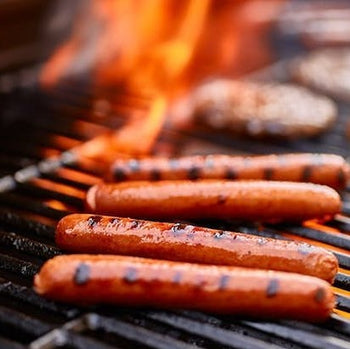
Let's be honest, who doesn't love a great hot dog? Especially when they are made only with 100% B7R beef and spices. Zero fillers, junk, or nitrates. Fully-cooked and definitely kid-approved!
Approx. 8oz packs, 4 Hot Dogs per pack
These are delicious and high quality!
Best hot dogs ever!!
Love the hot dogs, but not paying $9 for a four pack from now on. Used to be 5 dogs a pack.
Hi Gabe, Thank you for your feedback and for being a fan of our hot dogs! We understand your concerns about the change in packaging, and we want to clarify a bit about the update. While the number of hot dogs per pack was reduced, each individual hot dog has been made larger, offering a juicier, plumper bite. The overall weight remains the same as before, but we believe the improved size and quality of the product provides a better experience when enjoying our all-beef hotdogs.
As always, we strive to balance quality and cost, especially since we use all-natural ingredients, which can increase the price. We appreciate your understanding and hope you continue to enjoy our products. If you ever have any questions or concerns, please feel free to reach out at hello@bootheel7ranch.com.
My daughter destroys these! I love finding good, quality meat my kids will eat and contribute to their health!
We absolutely LOVE these dogs!

All Beef Hot Dogs: Buy 5, Save $5
Save $5.00 when you buy this bundle of (5) packages of 10oz All Beef Hot Dogs.
Let's be honest, who doesn't love a great hot dog? Especially when they are made only with 100% B7R beef and spices. Zero fillers, junk, or nitrates. Fully-cooked and definitely kid-approved!
Approx. 8oz packs, 4 Hot Dogs per pack
Best hot dogs!!!!

All Beef Hot Dogs: Buy 9, Get 1 FREE
Earn (1) FREE package of dogs when you buy this bundle of (9) All Beef Hot Dogs (10 packages, 50 dogs total).
Let's be honest, who doesn't love a great hot dog? Especially when they are made only with 100% B7R beef and spices. Zero fillers, junk, or nitrates. Fully-cooked and definitely kid-approved!
Approx. 8oz package, 4 Hot Dogs per pack



Enjoy our grill-ready hamburger patties! 80/20, vacuum-sealed, arrives frozen. Contains four ready to grill patties 6oz each (1.5lb of beef).
We purchase both the pound package of ground beef and the four-pack of hamburger patties. The patties are incredibly convenient for a quick and easy meal. They are also handy when entertaining, as they make less work for the chef.
B7R’s hamburger is heads and shoulders above what you can find at your local grocery store in my opinion.
We love the hamburger, nice to know we are supporting small businesses and getting a great product.
These make huge burgers, we usually make the 4 into 5 burgers. The beef is so tasty, with a smoother texture than store- bought getting beef.
Susan - Thanks for your review, we are so happy to hear you are enjoying the product! We appreciate your continued support of our family business. - Team B7R
The hamburger patties are the most juiciest and flavorful we've ever had. So far every thing we have had has been wonderful.
We appreciate your continued support of our family business, Scott! Thanks for your positive reviews of our products, we look forward continue serving your dinner table. - Team B7R



Hamburger Patties: Buy 5, Save $5
Save $5.00 when you buy this bundle of (5) Packages of 4x 6oz-patties.
Enjoy our grill-ready hamburger patties! 80/20 lean, vacuum-sealed, arrives frozen.
1 order of patties includes (4) patties per package, 6oz per patty (1.5lb of beef total). This bulk order includes 20 patties totaling 7.5lbs of burger patties.
Amazing product and service - never disappointing
Love these hamburgers, very juicy and there is hardly any shrinkage. The ground beef is also very good.



Hamburger Patties: Buy 5, Save $5
Earn (1) FREE package of burger patties when you buy this bundle of (9) Packages of 4x 6oz-patties.
Enjoy our grill-ready hamburger patties! 80/20 lean, vacuum-sealed, arrives frozen.
1 order of patties includes (4) patties per package, 6oz per patty (1.5lb of beef total). This bulk order includes 40 patties totaling 15lbs of burger patties.
These burgers are always flavorful and delicious!
Jennifer - We're so happy to hear our burgers are your favorite! Thanks for your kind words and continued support of our family business. - Team B7R

It's here! Always a holiday favorite, our BONELESS prime rib roast is the most desirable cut for any holiday or special event. With our 21 day dry-age, our rib roast will be sure to WOW your holiday crowd with tenderness and flavor!
Limited quantity available. We will continue to restock through the holiday season, so if your first choice is gone - stay tuned, and check back for restocks!
Please note: Prime Rib roasts are trimmed and have had the fat cap removed (not the spinalis dorsi).
Reverse Seared in the smoker. The best prime rib my family ever had according to them!
Dry brined in the fridge for 48 hours with coarse salt then mustard and Kinders and in to the smoker it went.
Hey Michael, Thank you so much for spreading the word about Bootheel 7 Ranch with your family! We greatly appreciate your 5* review and support of our homegrown family business. Best, Team B7R



A beautiful roast and excellent choice for slow cooking pot roast, shredded beef enchiladas, corned beef and more. The options are endless with this versatile cut!
Approx. 3lbs
This was a tender and juicy roast, easy to make in the crock pot. Out of town company loved it. Bootheel7 never fails to please and has an extremely efficient delivery setup, even if not within the state.
This is the best roast we've had since moving off the farm and eating only the meat raised on the farm. This is our "treat" meal. Comfort food at its finest!
Comparing the bottom round I have occasionally bought at Costco and a few local organic grocery stores, the Bootheel 7 roast was extremely tender and flavorful. What a difference!! I marinated it in the refrigerator overnight with juice of 1 each lime and tangerine and some garlic and herbs. Slow cooked it for 4 hours next day. Very tender and juicy. Probably could have cooked it for a shorter time. Maybe could have had it rare/med rare. Will try next time.
Sharon - We love to hear from happy customers...especially when you share your culinary tips! We'll have to give that marinade a try. Thank you for your business, we look forward to sharing our 21-day dry-aged Black Angus goodness with you again in the future. - Team B7R
This rump roast is perfect and easy for a Sunday dinner. Just put in the crockpot and the roast is tender and delicious!
This is a flavorful cut that works great for roast beef. I season it, then sear in a hot cast iron pan. Then place on a rack in my Instapot with about 1/2 cup of beef broth and cook on high pressure for about 12 min (a 3lb roast) for Med. Rare. Then let it remain in the pot at the Keep Warm setting for 45 min. Remove and use liquid in pot to make a gravy or for AuJus. Slice thinly to serve



Often referred to as a 'California Tri-Tip,' ours are well-marbled and can be prepared as a roast or sliced into steaks. An excellent option for a summer BBQ! Dry aged for 21 days.
Approx 1.5-2lbs
This has been an awesome discovery. I love how tender and flavorful this meat is.
Maria - we're so glad you found us, and that you are enjoying our products! Thank you so much for your support of our family business. - Team B7R
Seriously...an excellent choice for an oven roast or on the grill. YEARS purchasing these cuts and have never been disappointed.
Jeremi - It's great to hear that you are a longtime B7R fan! We're grateful for your continued business - Thank you for your 5* review, and for your support of our homegrown family operation.
Best,
Team B7R
This is great Tri-Tip! We put two Tri-Tips on the smoker, one from Boothill 7 and one from a local high-end meat store. Boothill 7's Try-Tip was a little smaller, but tasted better. Like other Boothill 7 meats, we could taste the difference.
We are so happy to hear you were pleased with your order, Wayne! And very glad that our product surpassed another local contender. Thank you very much for your review. - Team B7R
We have yet to try anything from Bootheel 7 Ranch that isn't superb! This piece of meat was flavorful and delicious!
Theses tri tips cook up great with great flavor!



We love chuck! When prepared slow n' low, this versatile cut can be used for everything from pot roasts to shredded beef enchiladas. Set on low in the slow cooker for 9+ hours and come home to the best dinner (and wonderful smelling home!) waiting for you.
Approx 3lb per roast
First time cooking a chuck roast. It was excellent. Seared both sides (after salt and pepper) then braised in a Dutch oven with a 28oz can of crushed tomatoes, 16oz bone broth, and sautéed garlic, onions, carrots, and celery (spice to taste). Braised at 350 for about an hour per pound (mine was 3.37 lbs). Took some of the braising liquid (skimmed the fat off), puréed with a hand blender, then reduced that liquid in a frying pan after adding some red wine (maybe 1/2 cup). That sauce thickened up and was an awesome gravy on top of mashed potatoes and tender BR7 chuck! Will order again!
One of my favorites! Taste and texture is always perfect. You will notice the quality and then can never go back!
I love using this cut for meals! Such great flavor and excellent quality.
Tender, fatty, goodness!
This chuck roast is the best ever for barbacoa. The flavors really shone through and the entire family loved it in tacos and burritos. Yummy!!
Hey Wendy! Thanks for the 5* review! We're honored to feed your family and that you all enjoyed barbacoa chuck roast! We appreciate your continued business! - Team B7R




Try something out of the ordinary with this hard-to-find cut prized by Brazilian steakhouses. Our Picanha roasts are cut from the cap of top sirloin, with a nice 'fat cap' that makes them moist and tender. The flavor this cut delivers is impossible to find in any other product.
Prepare as a hearty roast or slice into individual steaks. Once you 'know' about picanha, you know - it's a B7R fan favorite!
You can prepare it as steaks on the grill - cut up 1in portions - and then rolled up on skewers.
Oven - easy preparation - many, many great recipes online. Key is to score the fat, season well with salt and garlic and cook with the fat on the top so that as it cooks it gets crispier and as it melts it will do so into the meat itself. Enjoy!
Overall an excellent cut by an excellent ranch!
Flavorful and tender! Good piece of beef!
My husband was intrigued by this cut of roast as he had never heard of it. I am sure it will be a hit just as all the other products from Boot Heel 7! Giving it 5 stars right now!



We wanted to keep these all for ourselves (they are THAT good!) but we decided to share. These are a show stopper and turn out perfect every single time!
1.5 - 2lbs each
Although we love a lot of your cuts, this one tops all. So tender and juicy.
The BEST roast available. Insanely good quality meat. Turkey day....LOL...yeah, no...roast day and go carnivore!
We may be biased, but we're a 'Beef on Turkey Day' family, too! Thanks for the review, Jeremi. - Team B7R
Quite simply the best steaks out there. I divide them up and my wife and I get three meals with one roast. The taste is exceptional and better than any fancy steakhouse!!! 5 stars
Incredible cut of beef! Amazingly tender but still flavorful.
We always look forward to when these are available. I like to grill them.



A classic for the smoker! Our competition-grade whole beef brisket is big, thick, well-marbled, and includes both the flat-cut and the point. Also great for the slow cooker or a Texas style BBQ experience.
This brisket is a crowd favorite at our house. People can’t get enough of it. Turns out fantastically on the smoker.
Awesome Brisket Son in-law smoked it and it was awesome
Hey, Ed! Happy to hear our brisket was an experience the whole family could enjoy. We appreciate your 5* review, and hope our beef continues to stun everyone at your dinner table. Thanks for supporting our homegrown family business. Best, Team B7R
I ordered this brisket for a party we had for a lot of our neighbors. We smoked it on our “egg” and it was the best brisket we have ever tasted. We thought we would have more left overs than we did but everyone raved about it and went back for seconds. So, that is definitely a testament to the brisket! Bootheel is the best!
We are so glad we found Bootheel 7 Ranch. Their beef is amazing. You can taste the difference, not just compared to what we get from the grocery store, but from top local meat stores. We've ordered a variety of products from ground beef to steaks. Just smoked a brisket and it was melt-in-our-mouths fantastic. Tri Tip is excellent. Love the steaks. Delivery is convenient. Highly recommend!
12 pound brisket smoked for 9 hours was very tender and flavorful. We loved it!



From simple minestrone to classic beef bourguignon, our stew meat is a flavorful and affordable cut that can liven up your weeknight dinner rotation! Throw it in the slow cooker or marinate and throw on the grill for a perfect and easy dinner!
Approx. 1lb per package
This Stew meat is so tender and has so much flavor. This is a go to in every order we place!
I use the stew meat for making a tasty stir fry! Always easy and quick to cook for a perfect medium rare and the meat is tender and tasty! They also work great to marinade and throw on a skewer as a kabob!
We absolutely Love this stew meat. It’s so lean and flavorful- Thanks Bootheel for all of your fresh & delicious options!
All the Bootheel7 beef we have tried is amazing! The Bootheel7 beef stew meat make a pot of stew something special!
Hi Cindy - Thanks for your review! Good news, stew and roast season is right around the corner with *hopefully* some cooler temperatures. We look forward to serving you again in the future! - Team B7R
We use these for stews in winter, kabobs on the grill in summer, and stroganoff anytime. Tender, juicy, delicious.



Our beef short ribs are meaty beyond belief! Short ribs need to be braised and/or cooked low and slow but are worth the effort and are always a crowd favorite!
2-3 ribs per package (Approximately 3lbs.)
We ordered two slabs of these amazing ribs and they by far were the most meaty tender ribs we have had i will definitely order again
These were absolutely great! They were so tender and lots of meat. I want to order more!
Mouth watering. Great texture and lots of healthy fat! Taste was amazing.
We are so happy to hear you were pleased with your order, Holly! Thank you very much for your review. - Team B7R
They were tender and delicious. The meal was enjoyed by the whole family. My personal preference however would be that they were half as large.


A perfect mix of sweet and savory, our new Pineapple Teriyaki Beef Sticks are tangy and flavorful with just a hint of pepper! A protein-packed snack made with premium beef cuts and clean ingredients you can feel good about feeding your family. Kid-approved as a delicious, nutrition-packed snack for on the go or in between practices!
3.2oz peelable package - 2 sticks per package.
*Please note, second image shows two product packages to display item texture only. Customer will receive one package per quantity ordered.


Brand new to the B7R Jerky Collection!
The classic, mild beef stick flavor you love with just a hint of smoke! A protein-packed snack made with premium beef cuts and clean ingredients you can feel good about feeding your family. With a little "snap" in each bite, they are the perfect pre/post workout, easy-to-pack lunch, or afternoon snack on the go!
2.65oz, peelable package - 3 sticks per package.
*Please note, second image shows two product packages to display item texture only. Customer will receive one package per quantity ordered.


Our B7R Fajita Meat is a flavorful and tender cut pre-sliced into fajita-ready strips. All you have to do is throw it in your pan or wok and add your favorite veggies for an easy, delicious weeknight dinner!
1lb package
The fajita meat is the best and easiest to prepare. Great flavor and very tender, love it.
This is our first time order from Bootheel7 Ranch and we were not disappointed. We used this order for stir fry and the texture and taste were terrific. We are now a permanent customer!
This comes in thin strips which I cut down into 1inch pieces for beef stroganoff. Love the convenience and the beef is tasty and tender.
This is one of my faves! The meat is consistently good and soft!
This is the best for a quick, easy dinner! I let it sit for an hour with lime juice, cumin, chili powder, salt/pepper and throw it in a cast iron. Makes the best steak tacos!
Caitlin - thanks for your sharing your culinary secrets! We'll have to give this one a try. Enjoy your fajitas and thanks for shopping B7R!


Suggested as a supplement for more active dogs, B7R Canine POWER Blend is a proprietary, healthy blend of lean beef, fruit, veggies, and organ meat:
Arrives frozen in individually wrapped 1lb packages. The meat used to produce this blend is human grade, USDA inspected, and produced fresh like our other B7R products.
My Shiba loves the raw Power Blend! I like that it comes in a small, manageable portion. It always looks fresh and looks appetizing (well, as appetizing as raw meat can look).
Our dogs and some of our friends' pups have food allergies. We also know that dog food is not nearly as regulated as people food, so you can't account for the quality, ingredients, or freshness.
We like to stock up and also give these canine blends as gifts!
Dogs love it!! No fillers just good healthy dog food.
Our dogs love this power blend and contains a variety of healthy ingredients for them.

One package of beef marrow bones, averages 3lbs.
I always have these marrow bones on hand for special occasions or if we have company and I need to keep them busy. They love these!
My dogs enjoyed immensely. Kept them happy and busy chewing for hours.
I wasn’t please this time. The marrow bones I purchase for my dogs to chew on. This time they came split so I can’t let the dogs gnaw at them due to bone shards.
The picture that you’re showing advertising them they are not split and they haven’t been split on my past purchases.
Oh these would definitely be good for soups/stock/broth if someone was asking those.
Hi SKJ! First, thank you for your continued business, and for bringing this issue to our attention. We're sorry you received the wrong marrow bones. Your feedback helps us do better; we are looking into the issue and hope to resolve it quickly. Please contact us at hello@bootheel7ranch.com and we'll be happy to send a replacement of whole marrow bones for your dogs to enjoy safely.



Oxtail are some of the most flavorful soup bones available. Give them a try in oxtail soup!
Approx 1.75lbs per package
These oxtails are awesome. Nicely trimmed and meaty! You won’t be disappointed. Just ordered more.
Really can’t beat the price and quality! Please bring them back in stock!
Bravo Bootheel 7 Ranch!!
Ordering was easy. The price for the meat was very good...and the quality EXCELLENT!!
I felt like I was, for the first time, actually getting my money's worth.
The fat was trimmed down perfectly & the packaging was done well.
There is nothing like buying straight from the ranch.
I will be making more purchases in the neat future.
You are greatly appreciate!
Best
K.
*IF there were anything to stop me from future orders, it will be due to the shipping costs...NOT because of quality or service**
Hi K, Thank you so much for your 5* review - we are happy to hear you enjoyed your order! We aim to keep shipping costs as manageable as possible, and we would be happy to help you build an order that will optimize the cost of shipping. Please reach out to us at hello@bootheel7ranch.com before placing your order next time and we'll go from there! Thank you for your support of our homegrown family business. Best, Team B7R

Our favorite bone for dogs! No edges with extra cartilage on the ends for strong chewers!
One package of beef knuckle bones, averages 2-3 bones (4lbs total)
These knuckle bones make the best ever healthy and healing beef bone broth. We freeze them in small one-cup bags just perfect to heat up in a mug and settle down in front of the fire.
Thanks for the 5* review, Wendy! Great idea for preparing your bone broth. We're so happy you are enjoying our products, and appreciate your continued business! - Team B7R
These are the best bones that I have found for my dogs, as long as each dog has their own. Even my little Maltese enjoys these big boy bones!
Jan - Nothing makes us happier than going above and beyond for our customers - the four-legged ones included! Thanks for sharing your review, we look forward to serving you and the pups again in the future. - Team B7R
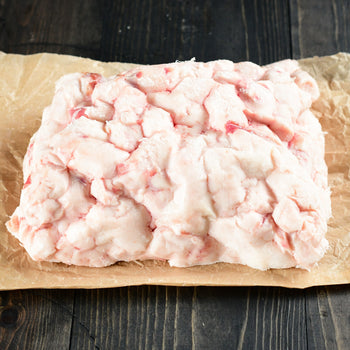
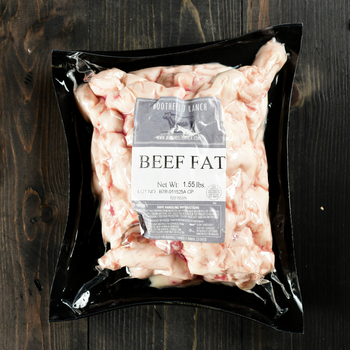
Beef suet is a pure, crumbly fat that comes from the area around the kidneys. It is perfect for rendering into tallow, which can be used for cooking, lip balm, candles and more!
Approx. 1.5-2lbs per package.

Enjoy a significant savings on your beef by moving up to one of our cow shares!
Our 1/12th cow share is an equal share of everything you would find on the side of a beef, just scaled down! Pricing includes all processing and packaging.
**SUBSTITUTIONS MAY BE POSSIBLE DEPENDING ON AVAILABILITY. PLEASE EMAIL HELLO@BOOTHEEL7RANCH.COM TO INQUIRE ABOUT PRODUCT SUBSTITUTIONS.**
Our 1/12th share includes:
(15) 1lb packages of our lean ground beef
(2) Bone-In Ribeyes
(2) T-bones
(1) package Short Ribs
(2) Assorted roasts (Chuck, Bottom Round)
(2) Top Round Steaks
(1) Top Sirloin Steaks
(1) package of Fajita Strip
(1) package Stew Meat
All cuts individually vacuum-sealed, labeled, and ready for your freezer!
Great taste and I appreciate the individually vacuumed sealed packaging
Thanks for the 5* review! We're delighted that you are happy with our products. We appreciate your continued business! - Team B7R
My husband was hesitant about the taste of grass-fed beef, but he couldn't be more pleased with the quality and taste. I love that you have different share size options with Bootheel. Prompt, on time delivery. This was my second order!
We have been ordering our beef from Bootheel for over a year… so delicious. I highly recommend it .

Our 1/8th cow share is an equal share of everything you would find on the side of a beef, just scaled down! Pricing includes all processing and packaging.
**SUBSTITUTIONS MAY BE POSSIBLE DEPENDING ON AVAILABILITY. PLEASE EMAIL HELLO@BOOTHEEL7RANCH.COM TO INQUIRE ABOUT PRODUCT SUBSTITUTIONS.**
Our 1/8th share includes:
(30) 1lb packages of lean ground beef
(3) Bone-In Ribeyes
(3) T-bones/Porterhouse
(1) Top Sirloin Steaks
(2) Top Round Steaks
(1) Cut Oxtail
(2) packages Short Ribs
(2) assorted roasts (Chuck, Bottom Round)
(1) package Fajita Strip
(1) package Stew Meat
(1) package Marrow or Knuckle Bones
All 21-day dry aged. Cuts are individually vacuum-sealed, labeled, and ready for your freezer!
*Please note there may be an additional fee to ship depending on your location.
Awesome service and high quality beef. A couple of the items included in the package we won’t use , would’ve liked the option to substitute.
Hi Pam, We're so glad to hear you enjoyed your order! Thank you for the feedback regarding substitutions. In the future, please do not hesitate to reach out to us at hello@bootheel7ranch.com before placing your order, and we would be happy to discuss substitutions with you. We appreciate your 5* review, and for your support of our homegrown family business. Best, Team B7R
Bought an eighth. Started with sirloin steak for first test. Amazing flavor and tenderness. Thank you. Will continue to be my source for “local” beef.
I did a ton of research on local farms that offer cow shares around Denver before deciding on B7R. We already knew they had quality ground beef because we'd been getting 1 lb/week through Royal Crest for a long while. I compared farming practices, price/lb, testimonials online, etc and found that B7R was about as good as you can get across the board. Regenerative farming + competitive pricing + affordable local delivery + the meat itself being higher quality than expected? Go ahead and put me down for an 1/8th every 6 months.
p.s. didn't come close to fitting in my 40 qt cooler on the porch, but fit perfectly in our standard freezer. 1/8th is the perfect amount.

Our 1/4th cow share is an equal share of everything you would find on the side of a beef, just scaled down! Pricing includes all processing and packaging.
**SUBSTITUTIONS MAY BE POSSIBLE DEPENDING ON AVAILABILITY. PLEASE EMAIL HELLO@BOOTHEEL7RANCH.COM TO INQUIRE ABOUT PRODUCT SUBSTITUTIONS.**
Our 1/4th share includes:
(60) 1lb packages of lean ground beef
(6) Bone-In Ribeye Steaks
(6) T-bone/Porterhouse Steaks
(1) package of Short Ribs
(1) Oxtail
(2) Top Sirloin Steaks
(2) Top Round Steaks
(2) Flat Iron 8oz Steaks
(1) package Sirloin Bavette
(1) package Flank Steak or Skirt Steak
(4) assorted roasts (Chuck, Bottom Round)
(1) Denver Steak
(2) packages of Fajita Strips
(2) packages of Stew Meat
(1) packages of Marrow and/or Knuckle Bones
All 21-day dry aged. Cuts are individually vacuum-sealed, labeled, and ready for your freezer.
*Please note there may be an additional fee to ship depending on your location.
This has been our go to order for some time now. We love all of the different cuts we get to try in this order. Everything is delicious and the portion size is perfect for our family to last 6 months. Keeping the freezer full gives us piece of mind and provides our family with delicious, healthy beef!
We have been getting a 1/4 share from Bootheel 7 since 2018. Originally, we had to meet them in a parking lot to pick it up, but now they deliver directly to your door. All of the meat in the share is great tasting and is package well for the freezer. Our grandkids love the steaks and the hamburger!
We have been getting beef from Bootheel 7 since when you had to meet them in a parking lot to get your meat. We always enjoy it and usually order extra steaks and hamburger.
Hey Tom! Thanks for the 5* review! We're honored to feed your family and are grateful for your continued support of our family business! - Team B7R
I've bought this 1/4 cow share almost a handful of times. It's the bang for your buck that will fit in my freezer! The meat tastes great. When we go out to expensive steak houses the steaks aren't as good as what I can cook at home wtih a bootheel ribeye and the ground beef at grocery stores also doesn't hold a candle to the ground beef in this product!

Our 1/2 cow share is in fact, a whole side of a beef! Pricing includes all processing, packaging, and delivery.
**SUBSTITUTIONS MAY BE POSSIBLE DEPENDING ON AVAILABILITY. PLEASE EMAIL HELLO@BOOTHEEL7RANCH.COM TO INQUIRE ABOUT PRODUCT SUBSTITUTIONS.**
Our 1/2 share includes:
(100) 1lb packages of our lean ground beef
(12) Bone-In Ribeyes
(12) T-Bone/Porterhouse
(1) Whole Tenderloin Roast
(1) Brisket
(4) Sirloin Steaks
(1) Tri-Tip
(1) Sirloin Bavette
(2) packages of Short Ribs
(2) packages Denver Steaks (2 steaks per pack)
(4) Flat Iron 8oz Steaks
(1) Flank Steak
(1) Skirt Steak
(8) assorted roasts (Chuck, Bottom Round)
(4) Top Round Steaks
(1) Oxtail
(2) packages Fajita Strip
(1) Petite Tender
(4) packages Stew Meat
(3) packages of Marrow and/or Knuckle Bones
All 21-day dry aged. Cuts are individually vacuum-sealed, labeled, and ready for your freezer.
We ordered the 1/2 and split with close friends so we could introduce them to the amazing beef at Bootheel 7. Needless to say they loved it, but we were so excited to try some new cuts with this order we don't see in the 1/4 order.
We ordered a half share from Bootheel 7 Ranch last October and were so impressed with the flavor and quality. I don’t usually buy beef because I care about how animals are treated, but knowing Bootheel 7 raises their cattle well made me feel good about our choice. Everything was delicious! We’re planning to order again this year.
Great taste nice portions reasonable price
meat is beautiful to look at, we had the pporterhouse this week and are impressed with the cut, the marbeling and the flavor. since we just got the 1/2 cow, we haven't tried many of the other steaks and chopmeat but the way the sale went and the niceness of the staff make me sure that we will buy again
The half share was delivered quickly, well packaged, and had great variety of cuts. Very happy with this purchase
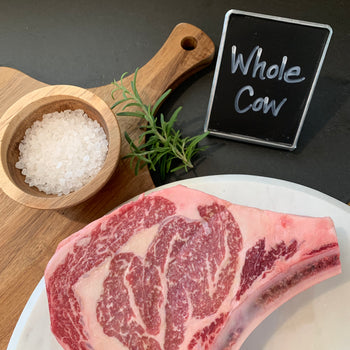
We do offer whole animals! This is an excellent option for families looking to go in on a whole animal together for additional savings. Pricing includes all processing, packaging, and delivery.

Give the gift of 'Denver's Best Steak' right at home! Ideal for family, friends, business associates, home chefs, and your hard-to-shop for loved ones!
Purchase a gift card and it will be instantly emailed to you (purchaser). Forward the email to your gift recipient, or print gift card out at home. **Please note - if you would like to include a personal message, please do so when emailing/forwarding to the gift recipient.
Can be used towards any future order, does not expire.
I bought two gift cards as Christmas gifts, gave them out early, their response was pure excitement, I’ve given out steaks as gifts, nothing but love, now they’ll have the pick of the crop.
Thank you Bootheel 7 Ranch, Merry Christmas
Hi Deb, Thank you so much for spreading the word about Bootheel 7 Ranch! Thank you for your 5* review, and for your support of our homegrown family business. Best, Team B7R

Give the gift of 'Denver's Best Steak' right at home! Ideal for family, friends, business associates, home chefs, and your hard-to-shop for loved ones!
Purchase a gift card and it will be instantly emailed to you (purchaser). Forward the email to your gift recipient, or print gift card out at home. **Please note - if you would like to include a personal message, please do so when emailing/forwarding to the gift recipient.
Can be used towards any future order, does not expire.
I bought two gift cards as Christmas gifts, gave them out early, their response was pure excitement, I’ve given out steaks as gifts, nothing but love, now they’ll have the pick of the crop.
Thank you Bootheel 7 Ranch, Merry Christmas
Hi Deb, Thank you so much for spreading the word about Bootheel 7 Ranch! Thank you for your 5* review, and for your support of our homegrown family business. Best, Team B7R

It's here! Always a holiday favorite, our BONE-IN prime rib roast is the most desirable cut for any holiday or special event. With our 21 day dry-age, our rib roast will be sure to WOW your holiday crowd with tenderness and flavor!
Limited quantity available. We will continue to restock through the holiday season, so if your first choice is gone - stay tuned, and check back for restocks!
Please note: Prime Rib roasts are trimmed and have had the fat cap removed (not the spinalis dorsi).
Book your ticket to flavor town. Much better flavor than comparable rib roasts from the grocery store.
Hey, Sean! Happy to hear you enjoy our 21-day dry age. We appreciate your 5* review, and hope our beef continues to stun everyone at your dinner table. Thanks for supporting our homegrown family business. Best, Team B7R
Scrumptious!
Thanks, Pat! So happy to hear you enjoyed our Prime Rib. - Best, Team B7R





Satisfy your inner caveman with our largest and most impressive steak, the one and only Tomahawk! A large, center-cut, bone-in Ribeye and Ribcap with a long, caveman style bone. Perfect to share for a special occasion!
40oz, Approx 2.5lbs
32oz, Approx 2lbs
I save the tomahawk for when we have friends over and it never fails to impress. The size, succulence and flavor are unmatched. This baby can easily feed the whole table (~4 people). Do yourself a favor and bring out the big guns from Bootheel7 next time you have a party.
Dry aged beef. Yum!
We have purchased these since the pandemic and they are our monthly treat. We love that we can have them as a steak and a cheat "Sunday roast". We sear on grill and then finish in oven and we will sometime slice like a "roast". Saves time when we want that traditional roast beef type dinner.
I buy your hamburger all the time now and have become popular in the neighborhood and with my golf buddies for making smash burgers. The 90% beef is so red and fresh compared to grocery stores. I have also purchased about $500 of your other cuts this past month so anxious to try.
I ordered two large sized Tomohawks and grilled them on the Weber with charcoal. Indirect each side for 10 minutes then finished with a direct sear until blackened. Best thing to ever come off the grill.



1lb Ground Beef: Buy 9, Get 1 FREE
Earn (1) FREE package of our bestselling ground beef when you buy this bundle of (9) 1lb-packages of our 90/10 Ground Beef (10 1lb packages total).
Our ground beef is a perfect blend that balances distinguished taste and texture. Made from 21-day dry-aged beef cuts including arm roast, mock tender, short rib, round steak, and sirloin, it's the flavorful, lean protein you can feel good about feeding your family.
(10) 1lb packages arrive flash-frozen and individually vacuum-sealed to maintain the highest quality standards. Approximately 10lbs of ground beef total.
Seriously cannot buy ground beef at the supermarket anymore.
Love the hamburger from Bootheel Ranch! Once you try it you can't go back to what is in the grocery stores as it just doesn't compare to the quality and you know you are getting a good product.
We love bootheel ranch. Have tried other beef companies, but this one has great delivery and the product is top notch. You won't be disappointed.
This is my family's favorite ground beef! Super flavorful and better than anything I've found in the grocery store. I always have to make sure I have several pounds of this in my freezer!
Their meat is so tasty! We love buying from a quality, local source.





Baseball-Cut Sirloins: Buy 5, Save $5
Save $5.00 when you buy this bundle of (5) packages of 1lbs-packages of Baseball-Cut Sirloin steaks.
The baseball cut gets its name from its rounded shape. Cut from the center of the top sirloin, this cut is thick, lean, and flavorful - similar to filet mignon but at smaller price!
2 steaks per package, approx. 1lb per package -This bulk order includes approximately 5lbs of baseball-cut sirloins.
ootheel 7 Ranch baseball-cut sirloin steaks are delicious! All the flavor you can imagine in a steak with a tenderness second only to their tenderloin filets.
Season, grill, rest, and sprinkle with your favorite finishing salt! Steakhouse delicious!
Bootheel 7 Ranch baseball-cut sirloin steaks are delicious! All the flavor you can imagine in a steak with a tenderness second only to their tenderloin filets.
Season, grill, rest, and sprinkle with your favorite finishing salt! Steakhouse delicious!





Bone-in Ribeye, 18oz: Buy 9, Get 1 FREE
Earn (1) FREE steak when you buy this bundle of (9) 18oz Bone-in Ribeyes (10 steaks total).
A crowd favorite here at the ranch, these 18oz bone-in ribeyes have incredible marbling and stand out as one of our most tender, juicy cuts. A 21-day, dry-aged B7R ribeye is hard to beat!
Approx. 18oz per steak-This bulk order includes approximately 11.2lbs of Bone-in Ribeyes.




Boneless Ribeye, 12oz: Buy 9, Get 1 FREE
Earn (1) FREE steak when you buy this bundle of (9) 12oz Boneless Ribeyes (10 steaks total).
A crowd favorite here at the ranch, these 12oz boneless ribeyes have incredible marbling and stand out as one of our most tender, juicy cuts. A 21-day, dry-aged B7R ribeye is hard to beat!
Approx. 12oz per steak-This bulk order includes approximately 7.5lbs of Boneless Ribeyes.

New to B7R shelves, this Wyoming Pork Chorizo is a product from our partners, 307 Meat Company. Chorizo is known for being a deeper red in color and the flavor is packed with spices. Chorizo recipes and styles can vary, 307's Wyoming Pork Chorizo has a hint of spice, but not too spicy.
*1LB
*Locally-produced, nitrate-free
*All natural, antibiotic-free, no hormones
Although a new addition to the B7R shop, this product is the result of our longstanding partnership with 307 Meat Company. 307 is a full-service craft butcher shop and retail store in Laramie, WY – just about the halfway point between Denver and the pastures of Bootheel 7 Ranch in Lusk, WY.We’re proud to carry 307 pork products and see our 307 partners expand their reach to B7R customers.



A crowd favorite here at the ranch, these 12oz boneless ribeyes have incredible marbling and stand out as one of our most tender, juicy cuts. A 21-day, dry-aged B7R ribeye is hard to beat!
Great flavor and marbling. Literally "farm to table" with their delivery service.
Hi Mike, We're so glad to hear you enjoyed your order! Thank you for your 5* review, and for your support of our homegrown family business.
Best,
Team B7R


New from our local partners, 307 Meat Company, add this chopped bacon to any salad, chili, baked potatoes or casserole for a flavor-enhancing treat. A bit richer than regular bacon (also available in our shop), chopped bacon – otherwise known as ‘ends and pieces’ – are the tasty morsels that remain after the slicing process. Though smaller – these little flavor bombs pack a hearty punch and will elevate any dish.
*0.5LB
*Locally-produced, nitrate-free
*All natural, antibiotic-free, no hormones
*The main difference between cured and uncured meat generally has to do with the aging process and methods used to preserve the product. Cured bacon, for example, may include sea salt and nitrites to seal the product’s flavor and color, while UNCURED bacon (like this product here), cures with naturally-occurring nitrites like celery juice powder.
Although a new addition to the B7R shop, this product is the result of our longstanding partnership with 307 Meat Company. 307 is a full-service craft butcher shop and retail store in Laramie, WY – just about the halfway point between Denver and the pastures of Bootheel 7 Ranch in Lusk, WY. This premium, locally-produced product is sourced from twenty family-owned farms who promote and practice sustainable agriculture, and devote individualized attention to the animals. We’re proud to carry 307 pork products and see our 307 partners expand their reach to B7R customers.


Succulent, uncured bacon from 307 Meat Company has hit the B7R shelves! Be the first to try this premium, locally-produced bacon sourced from twenty family-owned farms. Juicy and skillet-ready, this uncured bacon will level-up any meal.
This bacon is the perfect addition to your breakfast spread, sandwiches – and more!
*1LB
*Locally-produced, nitrate-free
*All natural, antibiotic-free, no hormones
*The main difference between cured and uncured meat generally has to do with the aging process and methods used to preserve the product. Cured bacon, for example, may include sea salt and nitrites to seal the product’s flavor and color, while UNCURED bacon (like this product here), cures with naturally-occurring nitrites like celery juice powder.
Although a new addition to the B7R shop, this product is the result of our longstanding partnership with 307 Meat Company. 307 is a full-service craft butcher shop and retail store in Laramie, WY – just about the halfway point between Denver and the pastures of Bootheel 7 Ranch in Lusk, WY. We’re proud to carry 307 pork products and see our 307 partners expand their reach to B7R customers.
Yummy!
This bacon shrinks a lot when cooked, some shrinkage is normal but this seems a bit higher than expected.
This is the best bacon I've ever bought! Great value for the cost. Worth every penny.


New from our partners, 307 Meat Company, add this chopped bacon to any salad, chili, baked potatoes or casserole for a flavor-enhancing treat. A bit richer than regular bacon (also available in our shop), chopped bacon – otherwise known as ‘ends and pieces’ – are the tasty morsels that remain after the slicing process. Though smaller – these little flavor bombs pack a hearty punch and will elevate any dish.
*0.5LB
*Locally-produced, nitrate-free
*All natural, antibiotic-free, no hormones
*The main difference between cured and uncured meat generally has to do with the aging process and methods used to preserve the product. Cured bacon, for example, may include sea salt and nitrites to seal the product’s flavor and color, while UNCURED bacon (like this product here), cures with naturally-occurring nitrites like celery juice powder.
Although a new addition to the B7R shop, this product is the result of our longstanding partnership with 307 Meat Company. 307 is a full-service craft butcher shop and retail store in Laramie, WY – just about the halfway point between Denver and the pastures of Bootheel 7 Ranch in Lusk, WY. This premium, locally-produced product is sourced from twenty family-owned farms who promote and practice sustainable agriculture, and devote individualized attention to the animals. We’re proud to carry 307 pork products and see our 307 partners expand their reach to B7R customers.


New to the Bootheel 7 Ranch shelves – be the first to try this premium, locally-produced bacon from our partners, 307 Meat Company. As juicy as it is savory, this bacon is ready to be tossed in the skillet and crisped to melt-in-your-mouth perfection.
This bacon is the perfect addition to your breakfast spread, BLTs, soups – and more!
*1LB
*Locally-produced, nitrate-free
*The main difference between cured and uncured meat generally has to do with the aging process and methods used to preserve the product. Cured bacon, for example, may include sea salt and nitrites to seal the product’s flavor and color, while UNCURED bacon (like this product here), cures with naturally-occurring nitrites like celery juice powder.
Although a new addition to the B7R shop, this product is the result of our longstanding partnership with 307 Meat Company. 307 is a full-service craft butcher shop and retail store in Laramie, WY – just about the halfway point between Denver and the pastures of Bootheel 7 Ranch in Lusk, WY. We’re proud to carry 307 pork products and see our 307 partners expand their reach to B7R customers.
I've made my own bacon a lot and this bacon is every bit as good as home made.
Scott - We're so happy to hear you're enjoying the bacon! Thanks for your review and your support of our family business. - Team B7R


New to the Bootheel 7 Ranch shelves, our partners at 307 Meat Company have delivered ‘the missing LINK’ with these breakfast sausages. Savory and versatile, you can’t go wrong with the classic salt, pepper, and sage flavor.
Try them in ‘pigs in a blanket’, slice ‘em up and toss into an egg casserole, or get creative with ‘pancake corndogs’ – this key ingredient is the hearty protein to pull it all together.
*9oz
*Locally-produced, nitrate-free
*All natural, antibiotic-free, no hormones
Although a new addition to the B7R shop, this product is the result of our longstanding partnership with 307 Meat Company. 307 is a full-service craft butcher shop and retail store in Laramie, WY – just about the halfway point between Denver and the pastures of Bootheel 7 Ranch in Lusk, WY. This premium, locally-produced product is sourced from twenty family-owned farms who promote and practice sustainable agriculture, and devote individualized attention to the animals. We’re proud to carry 307 pork products and see our 307 partners expand their reach to B7R customers.
I don't usually like sausage links but I LOVE these. Simple ingredients but big flavor without the grease.


Be the first to try the all-new breakfast sausage patties from our partners, 307 Meat Company. 307’s customer-favorite classic breakfast sausage, now in patty form for your convenience. These patties are a rich, mouth-watering must-have for breakfast sandwiches – not to mention, great for meal prep, tailgates, campfires – you name it!
*1lb Packs
*Locally-produced, nitrate-free
*All natural, antibiotic-free, no hormones
Although a new addition to the B7R shop, this product is the result of our longstanding partnership with 307 Meat Company. 307 is a full-service craft butcher shop and retail store in Laramie, WY – just about the halfway point between Denver and the pastures of Bootheel 7 Ranch in Lusk, WY. This premium, locally-produced product is sourced from twenty family-owned farms who promote and practice sustainable agriculture, and devote individualized attention to the animals. We’re proud to carry 307 pork products and see our 307 partners expand their reach to B7R customers.
This sausage is very tasty and safe for someone with onion and garlic sensitivity. The only thing I didn’t like was that the patties are burger sized. Too big to serve with a normal breakfast unless you’re a linebacker!


New to B7R shelves, this savory classic is a product from our partners, 307 Meat Company. Just a hint of sage and a whole lot of flavor – fry this up with Sunday brunch or bake it in a casserole or hot dish, and watch the family come running to enjoy this perfect breakfast (or anytime) sausage.
*1LB
*Locally-produced, nitrate-free
*All natural, antibiotic-free, no hormones
Although a new addition to the B7R shop, this product is the result of our longstanding partnership with 307 Meat Company. 307 is a full-service craft butcher shop and retail store in Laramie, WY – just about the halfway point between Denver and the pastures of Bootheel 7 Ranch in Lusk, WY. This premium, locally-produced product is sourced from twenty family-owned farms who promote and practice sustainable agriculture, and devote individualized attention to the animals. We’re proud to carry 307 pork products and see our 307 partners expand their reach to B7R customers.
Bootheel's beef and other products are amazing and very reasonably priced.
The pork sausage taste delicious! Best we've ever had.
A little on the expensive side though.
No onions or garlic! And I find the bulk more useful than the large 1/4 lb patties
My gold standard for taste of breakfast sausage is Bob Evans (midwesterners will recognize that), and this sausage meets that standard while far exceeding the quality of the pork and other ingredients. My only concern would be that it has a bit too much fat.
This is A++++. Super tasty. My whole family loved it. Love the minimal ingredients and something we can all feel good about eating. Tasted delicous!





Our NEW beef stick and steak strip products are finally here! Buy in bulk and save - these items have become customers' new favorites!
Customers receive one package of each new product, multiples in product images are meant only to display texture.
Pineapple Teriyaki Beef Sticks
Tangy and flavorful, witha hint of pepper. - Approx. 1.8oz peelable package, 3 sticks per package.
Original Steak Strips
Black pepper, paprika, and red pepper, a mild kick you will love. - Approx. 1.8oz peelable package, 3 strips per package.
Original Beef Sticks
The classic flavor you grew up with, a bit of Nostalgia in every bite. - Approx. 1.8oz peelable package, 3 sticks per package.
Total shipping weight, approx. .5LBs
I tried these for the first time. I can’t close a favorite. They were all delicious. Perfect snack or picnic on the go.
Delicious and healthy
We threw this in our order just to give them a try. These beef sticks were awesome. They tasted great and did not last long! We will need to order several next time we place our order :)
These beef sticks are delicious, a quick healthy snack. My kids devoured the pineapple teriyaki ones!


Brand new to the B7R Jerky Collection!
The classic, mild beef stick flavor you love with just a hint of smoke! A protein-packed snack made with premium beef cuts and clean ingredients you can feel good about feeding your family. With a little "snap" in each bite, they are the perfect pre/post workout, easy-to-pack lunch, or afternoon snack on the go!
2.65oz, peelable package - 3 sticks per package.
*Please note, second image shows two product packages to display item texture only. Customer will receive one package per quantity ordered.


A perfect mix of sweet and savory, our new Pineapple Teriyaki Beef Sticks are tangy and flavorful with just a hint of pepper! A protein-packed snack made with premium beef cuts and clean ingredients you can feel good about feeding your family. Kid-approved as a delicious, nutrition-packed snack for on the go or in between practices!
3.2oz peelable package - 2 sticks per package.
*Please note, second image shows two product packages to display item texture only. Customer will receive one package per quantity ordered.




For a truly unbeatable steak experience, the filet mignon (cut from the beef tenderloin) is definitely your go to! It is the most expensive and sought-after cut of beef, simply because there isn't much of it to go around. It's small and unbelievably tender, making your B7R filet experience truly one to remember!
Individually cut and vacuum-sealed, 21-day dry age.
This is my personal favorite cut! Thank you Bootheel for providing a superior product every time we order! We are never disappointed, only when we run out!
This steak didn’t just change my diet—it rewrote my culinary belief system. This isn’t just meat; it’s a revelation wrapped in marbling. The flavor? Rich, clean, and somehow nostalgic, like it remembers what beef used to taste like before the world got weird. Every bite is a reminder that cows, when raised right, can do magical things.
I now evangelize to friends, family, and unsuspecting strangers at the grocery store. “You haven’t lived,” I whisper, “until you’ve had Bootheel 7.”
Bless you, Bootheel 7. You had me at first sizzle.
⭐️⭐️⭐️⭐️⭐️
I ordered a number of filet mignon’s and they were delicious so I’ve re-ordered more
Hey Steve! Thanks for the 5* review! We're honored to feed your family and that you are loving the filets! We're biased, of course, but agree that they are fantastic cuts :) We appreciate your continued business! - Team B7R





A crowd favorite here at the ranch, our bone-in ribeyes have incredible marbling and stand out as one of our most tender, juicy cuts. A 21 day dry-aged B7R ribeye is hard to beat!
Approx 1.12lbs
Bootheel continues to be the best in customer service and product satisfaction! These steaks do not disappoint, juicy and delicious, get you some!!!!!
Sean Suppi Highlands Ranch , CO
My husband and I started ordering from Bootheel7 ranch over a year ago and have been totally satisfied! The meat is tender and full of flavor. Highly recommend!
We only but steaks from Boothel 7 and these are our favorite steaks. Stay home, turn on the smoker, and eat a delicious steak dinner for a fraction of restaurant prices and just as high quality.
Cooked one on my Trager and it was wonderful.
My husband loves bone-in ribeye and he has tried others, but when he ate the one from Bootheel 7 Ranch it was a game changer and it is now the only place we buy them from.

It's here! Always a holiday favorite, our BONELESS prime rib roast is the most desirable cut for any holiday or special event. With our 21 day dry-age, our rib roast will be sure to WOW your holiday crowd with tenderness and flavor!
Limited quantity available. We will continue to restock through the holiday season, so if your first choice is gone - stay tuned, and check back for restocks!
Please note: Prime Rib roasts are trimmed and have had the fat cap removed (not the spinalis dorsi).
Reverse Seared in the smoker. The best prime rib my family ever had according to them!
Dry brined in the fridge for 48 hours with coarse salt then mustard and Kinders and in to the smoker it went.
Hey Michael, Thank you so much for spreading the word about Bootheel 7 Ranch with your family! We greatly appreciate your 5* review and support of our homegrown family business. Best, Team B7R